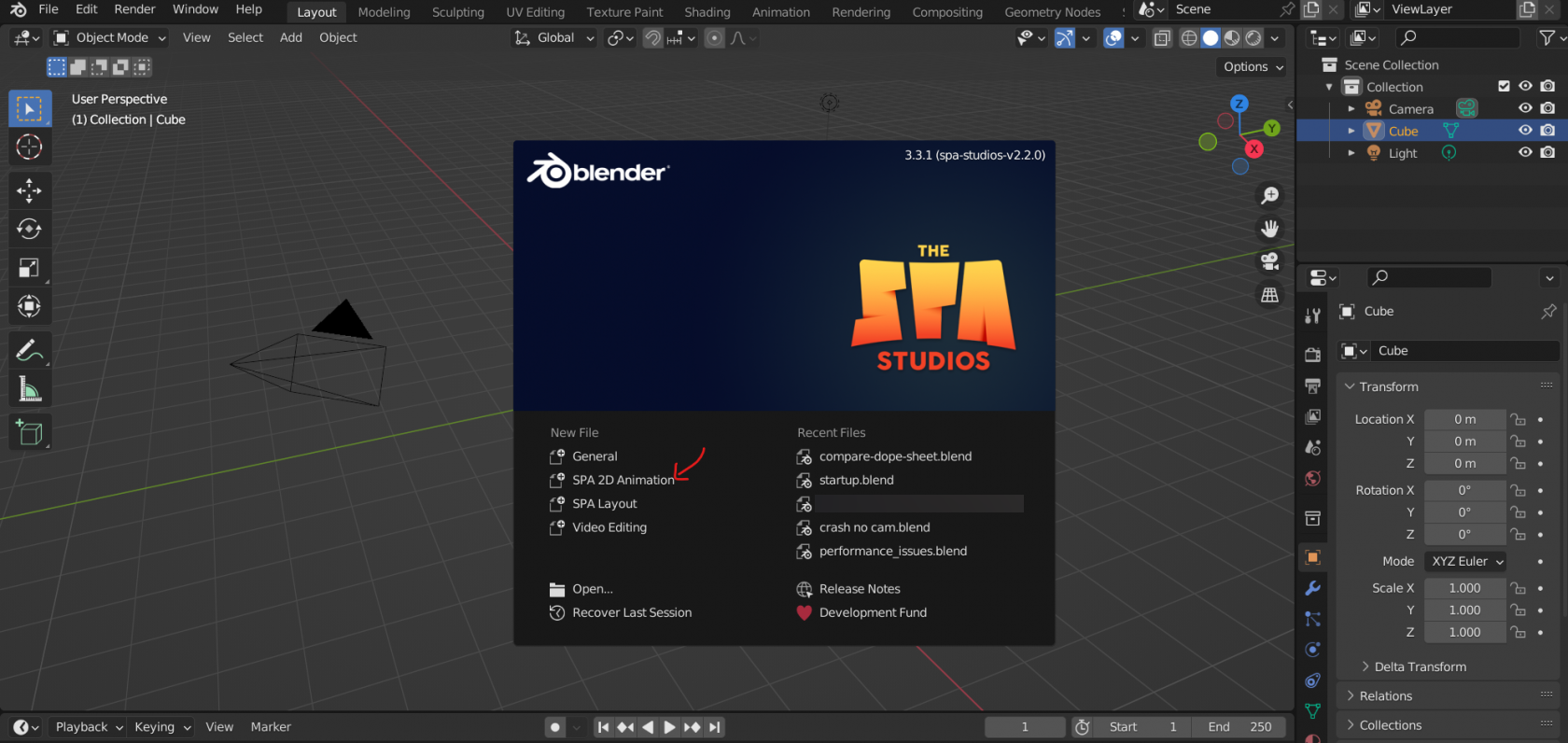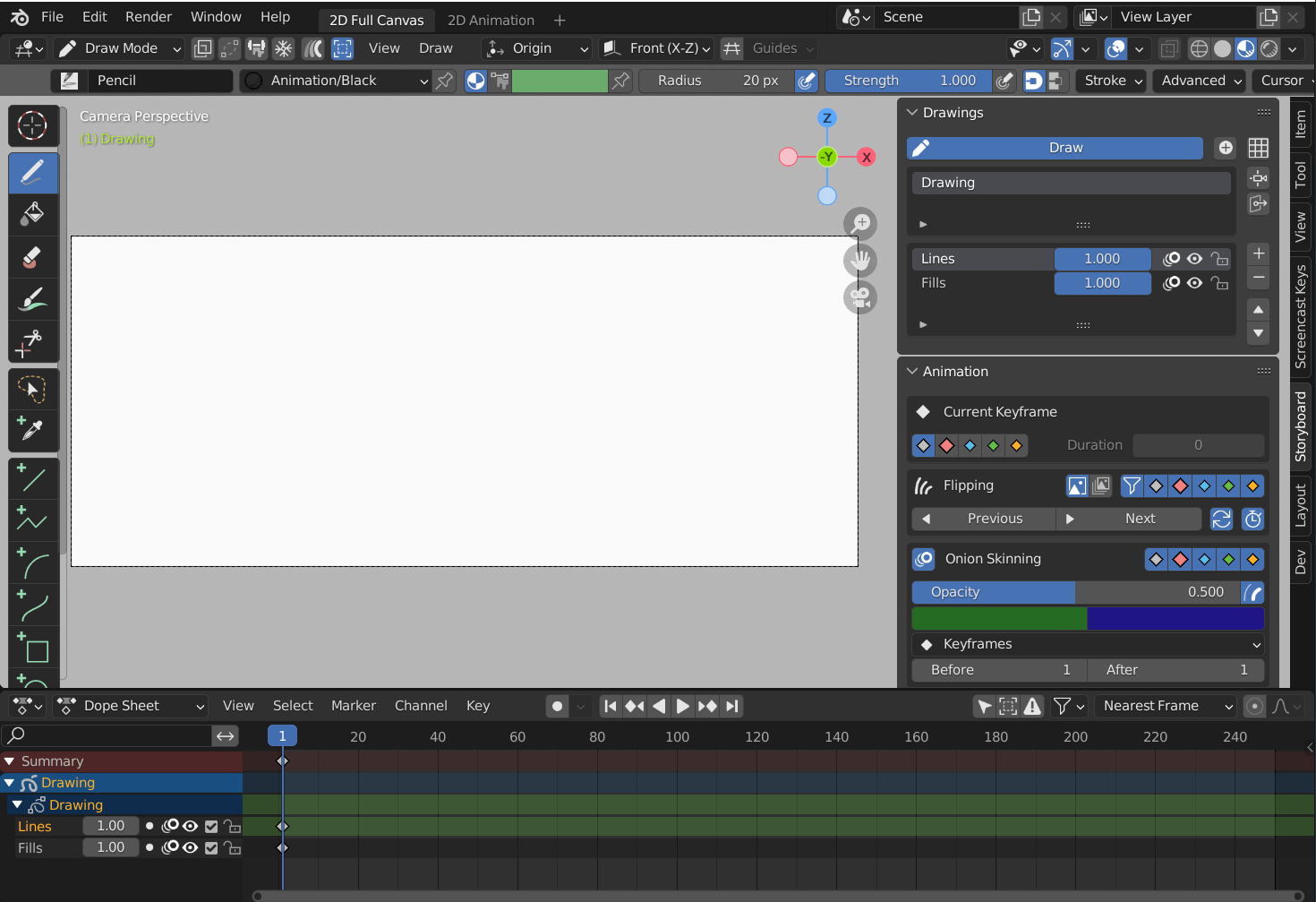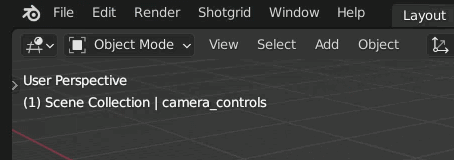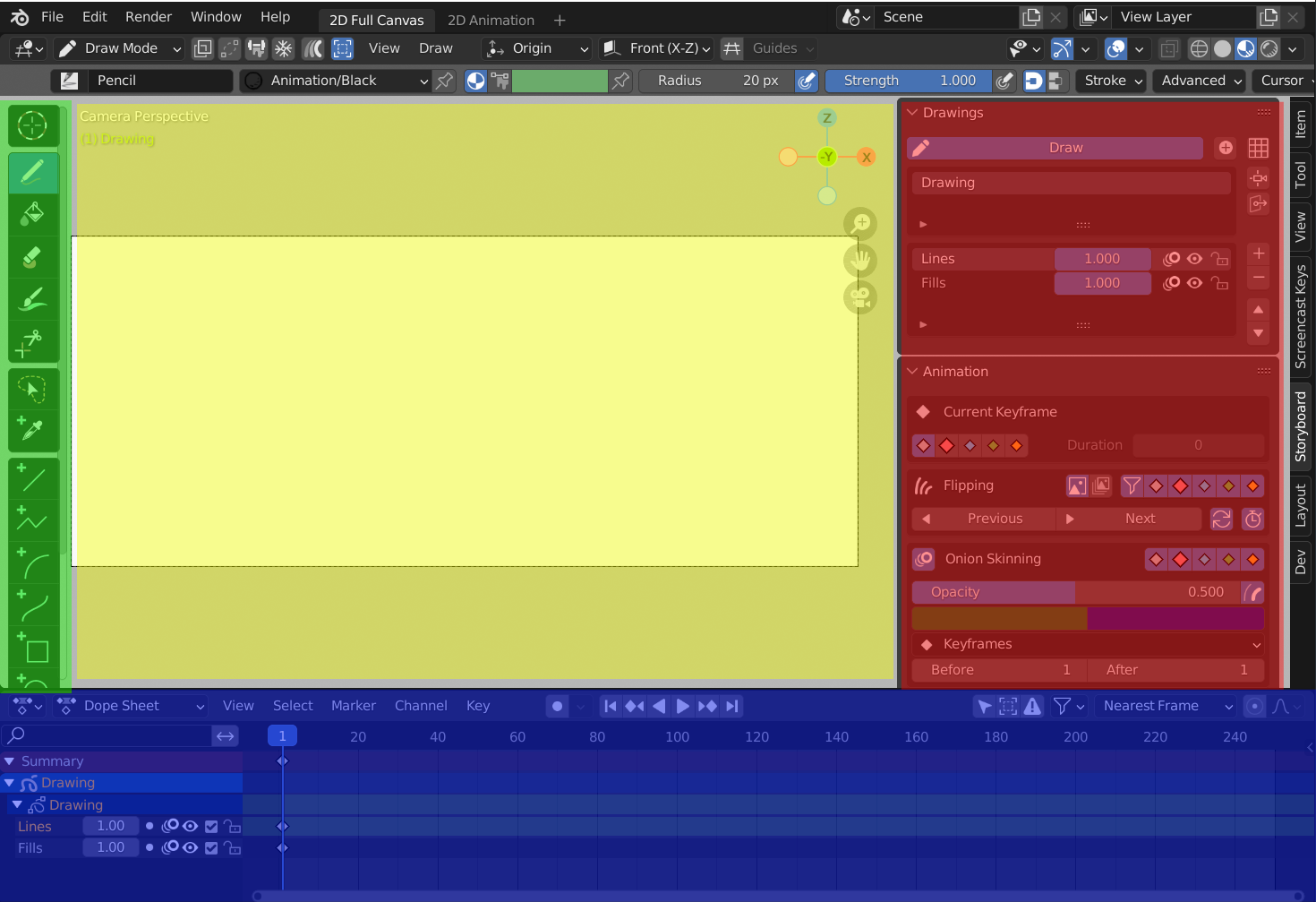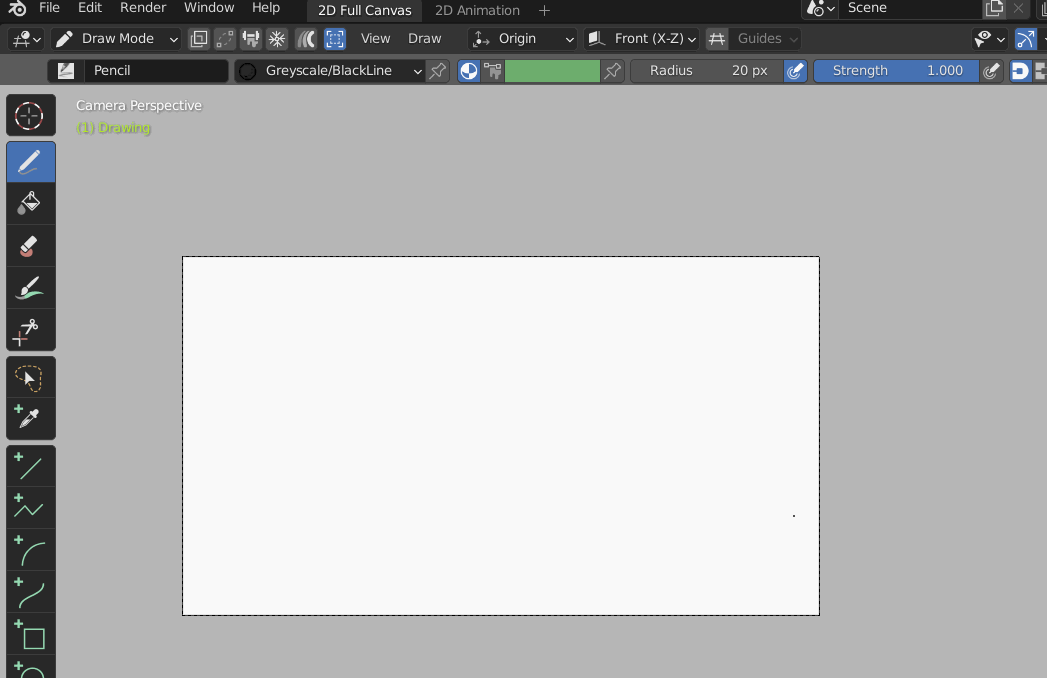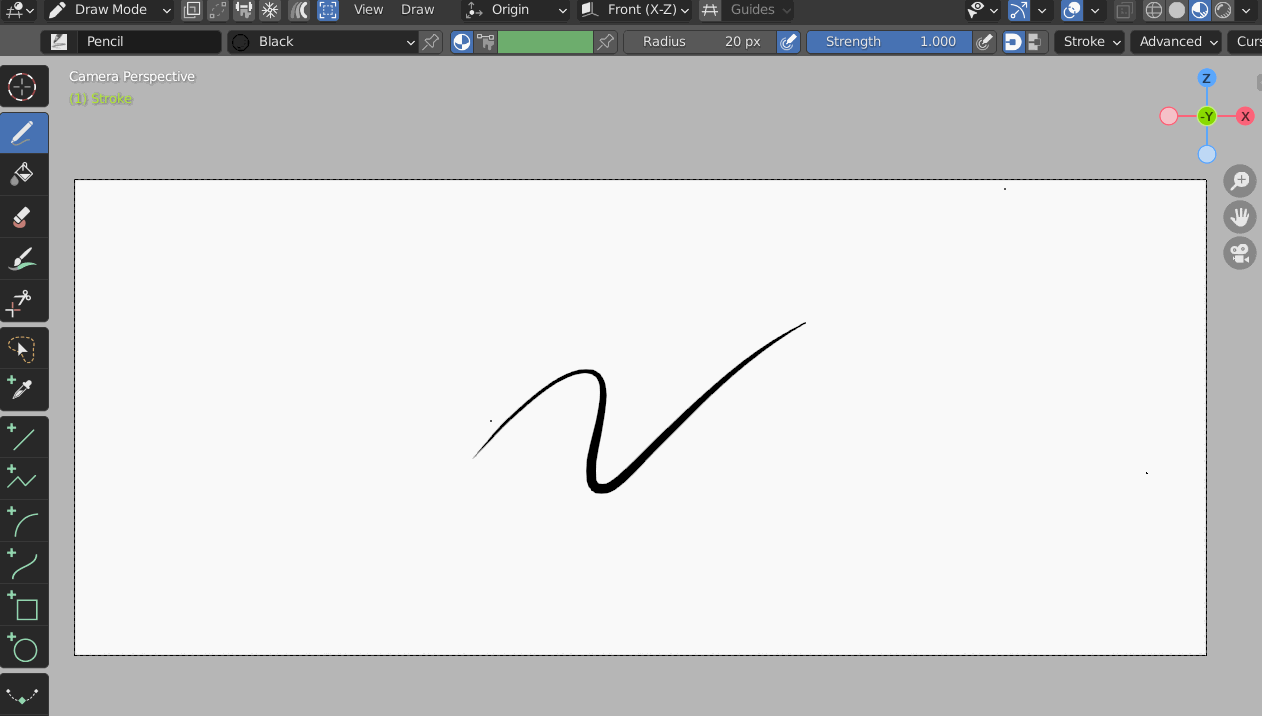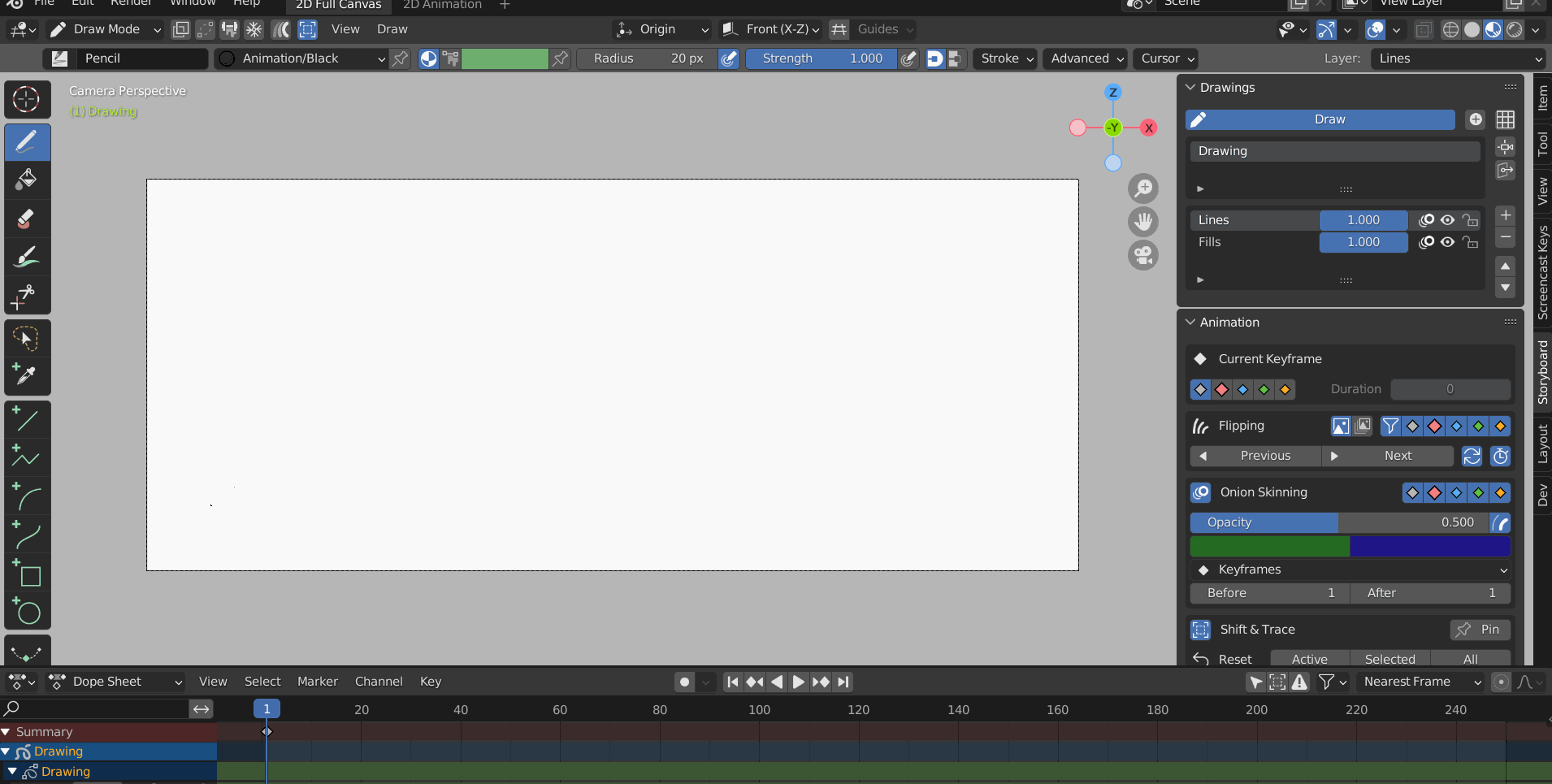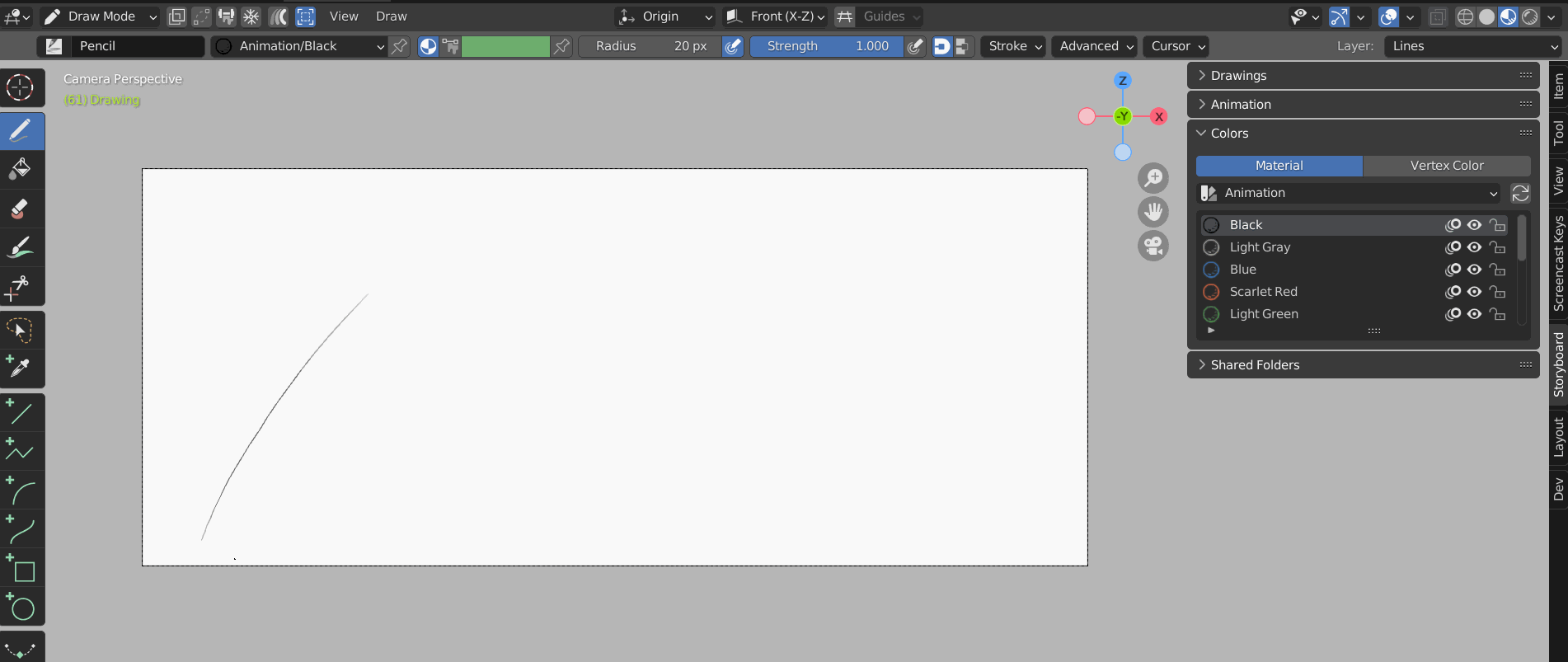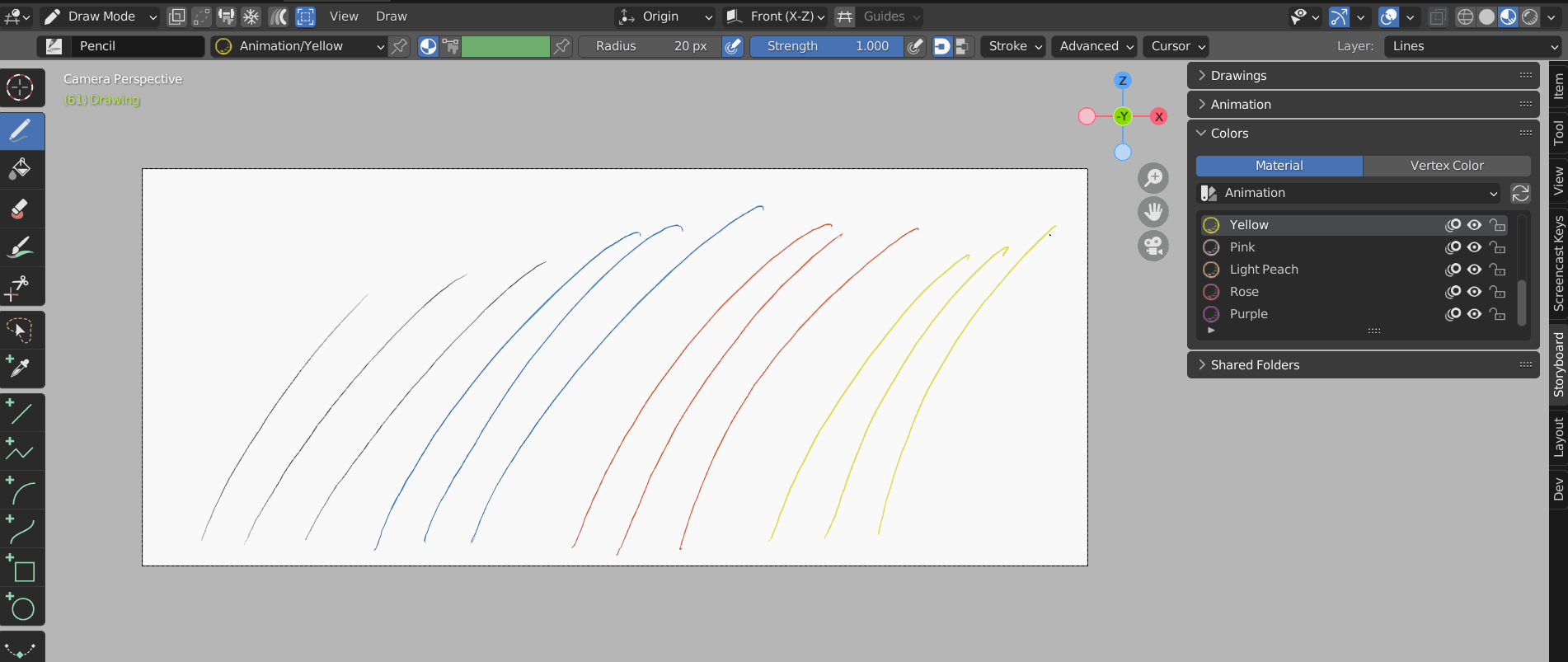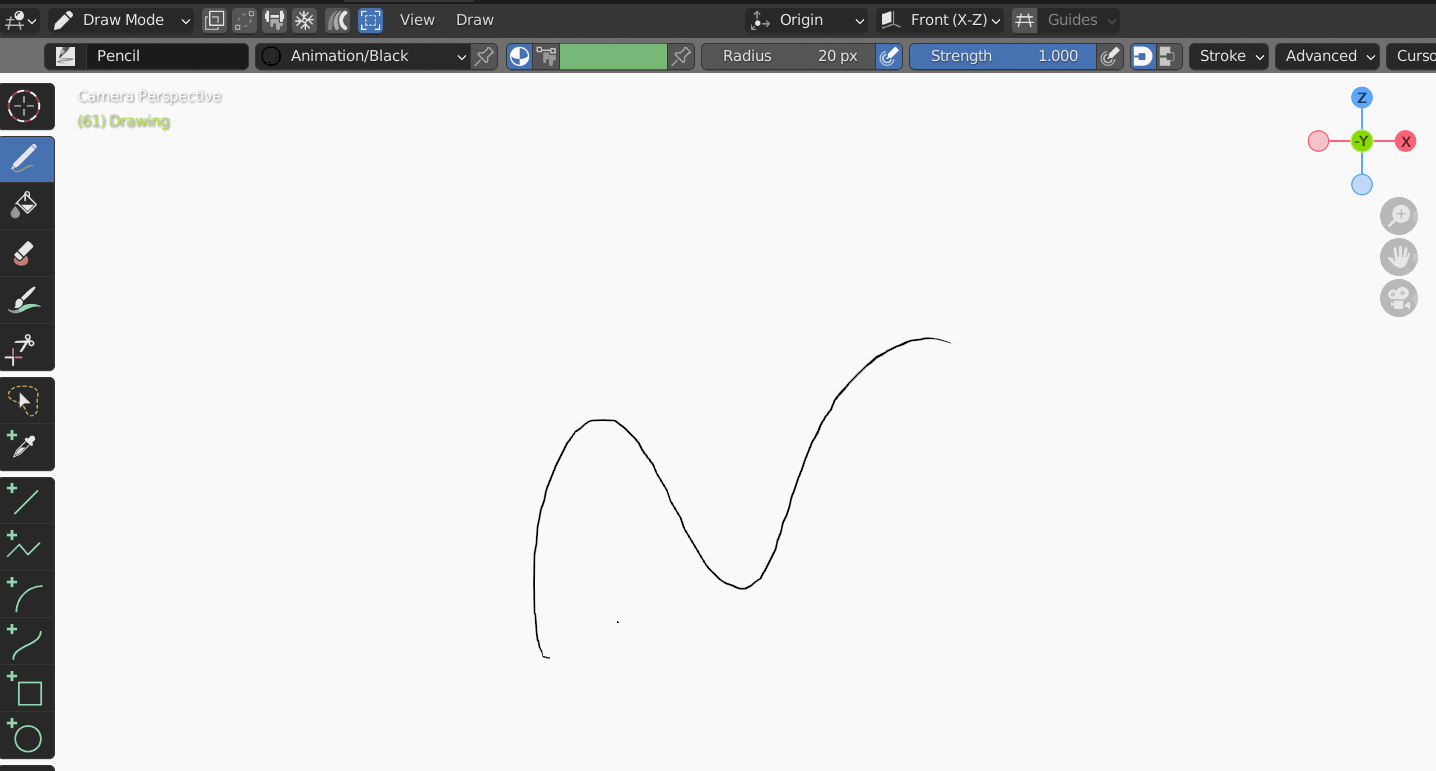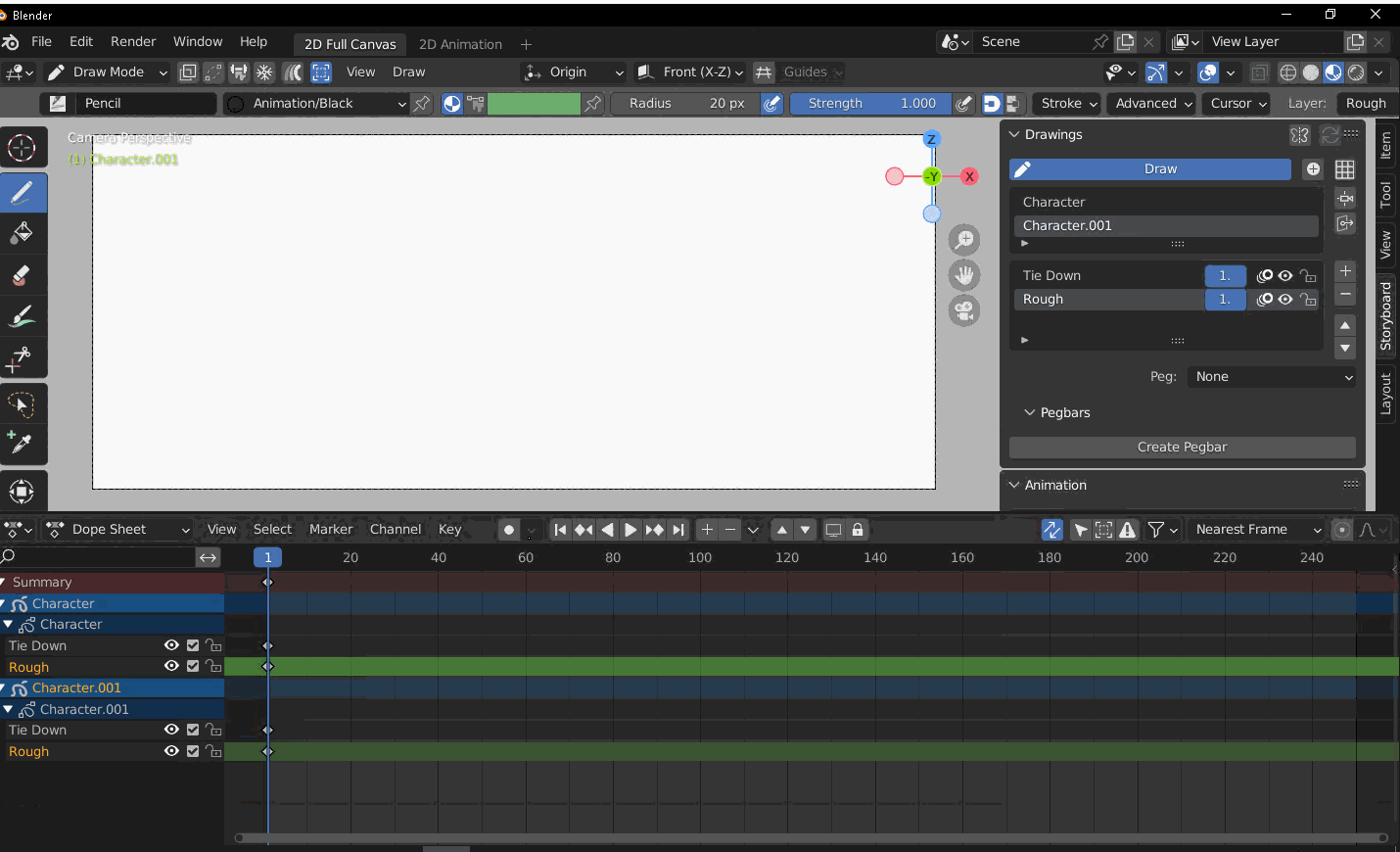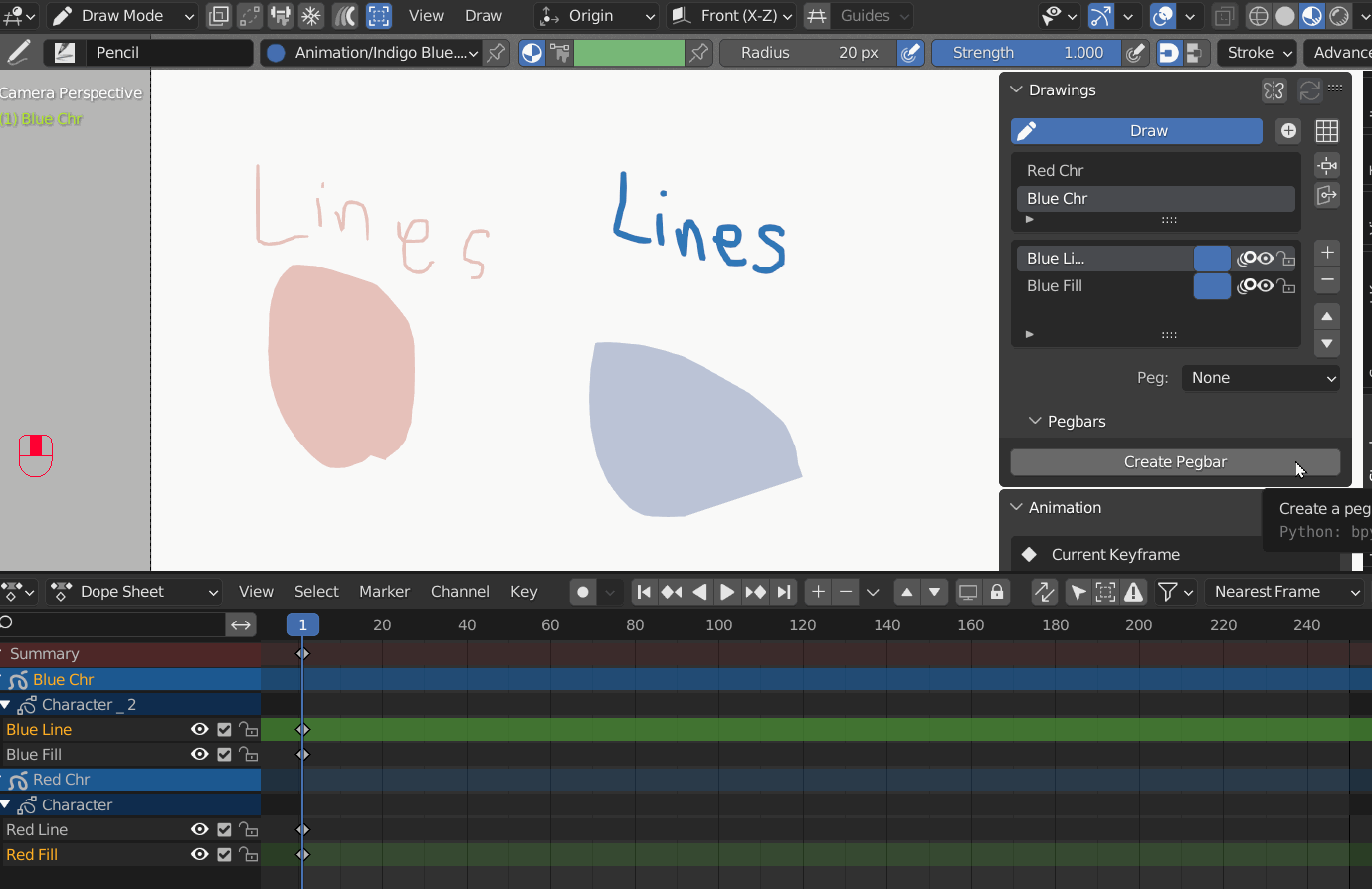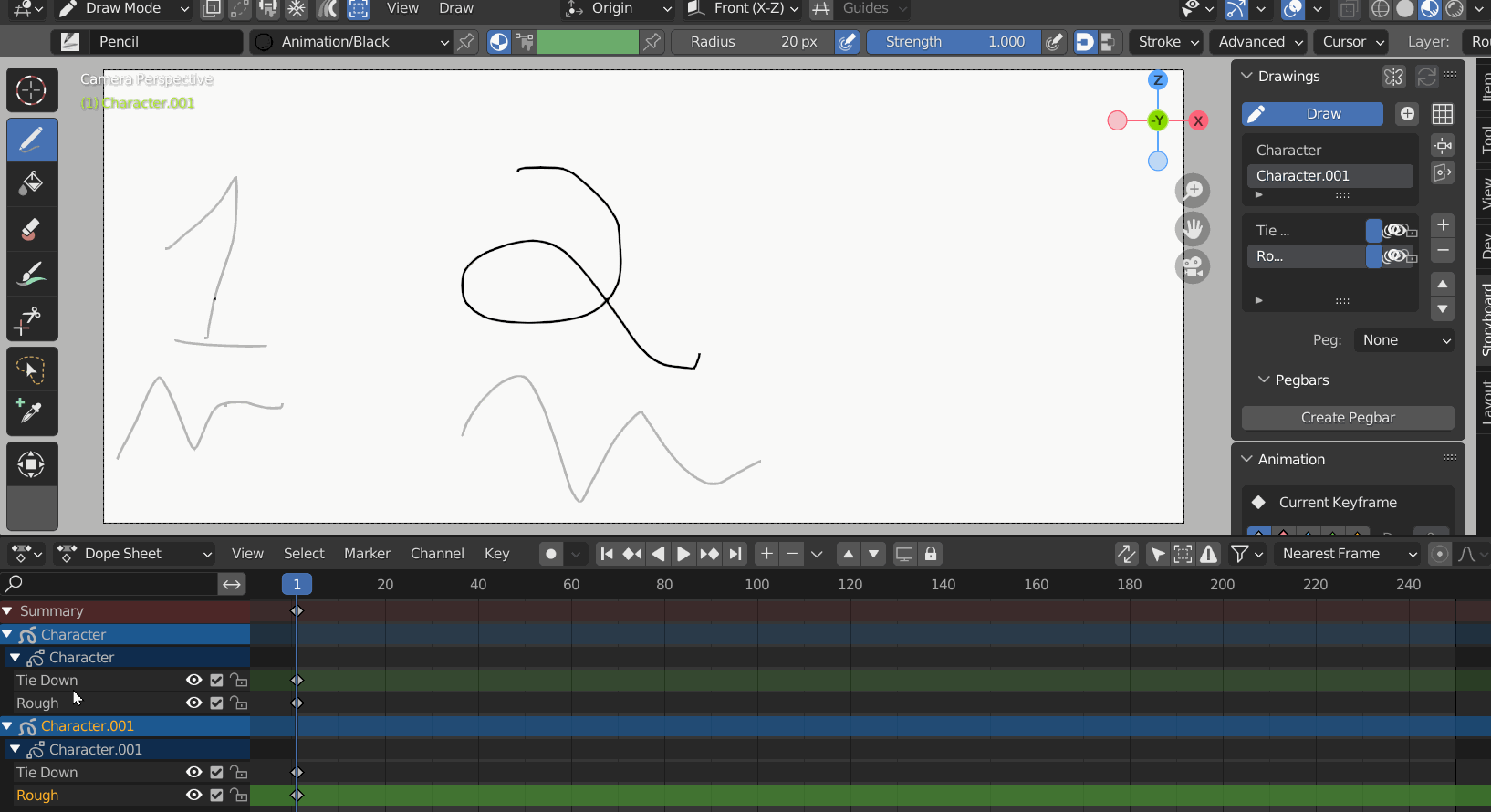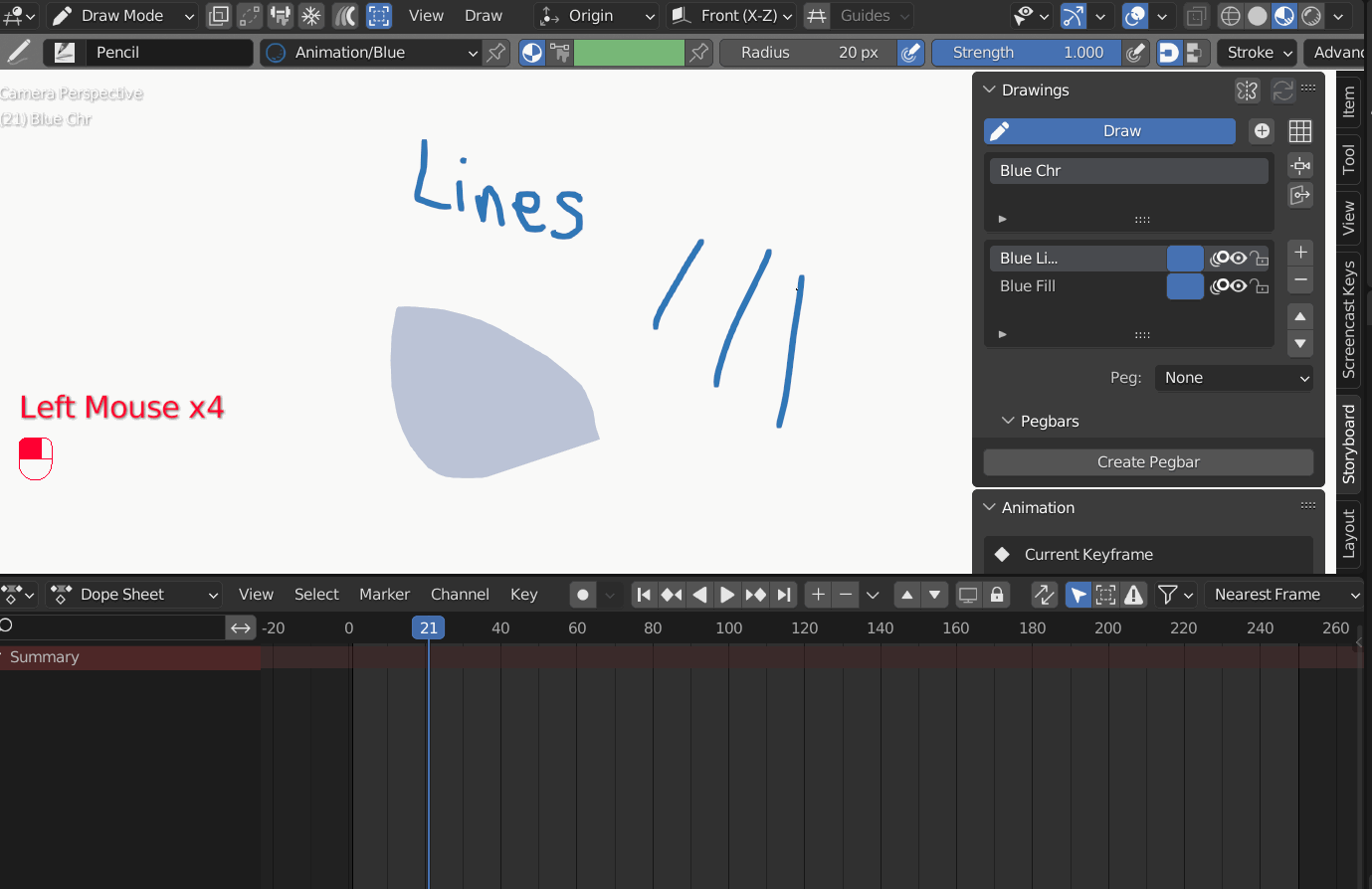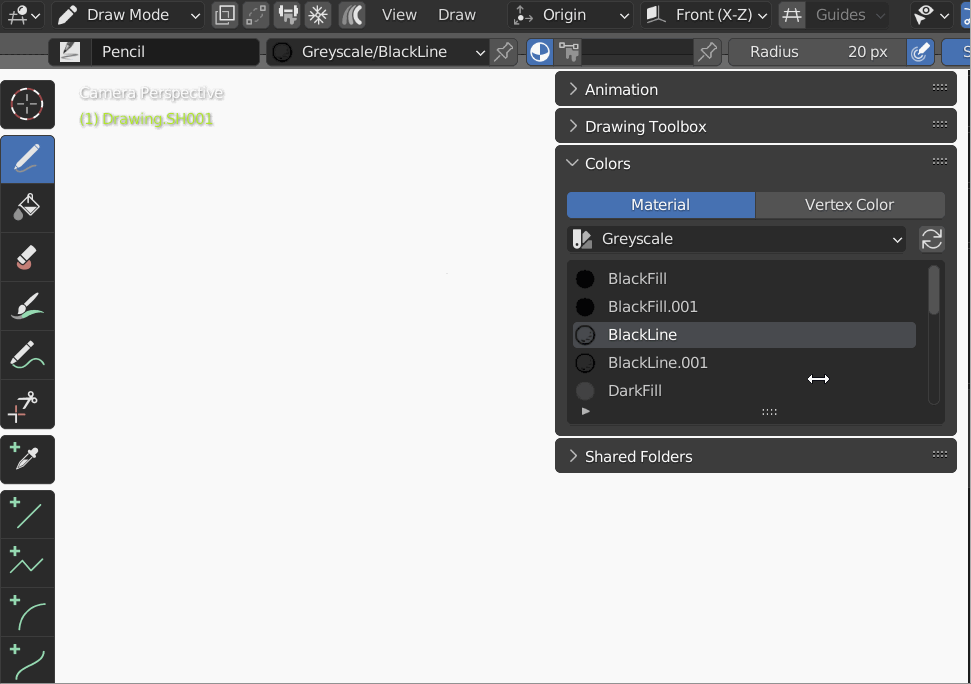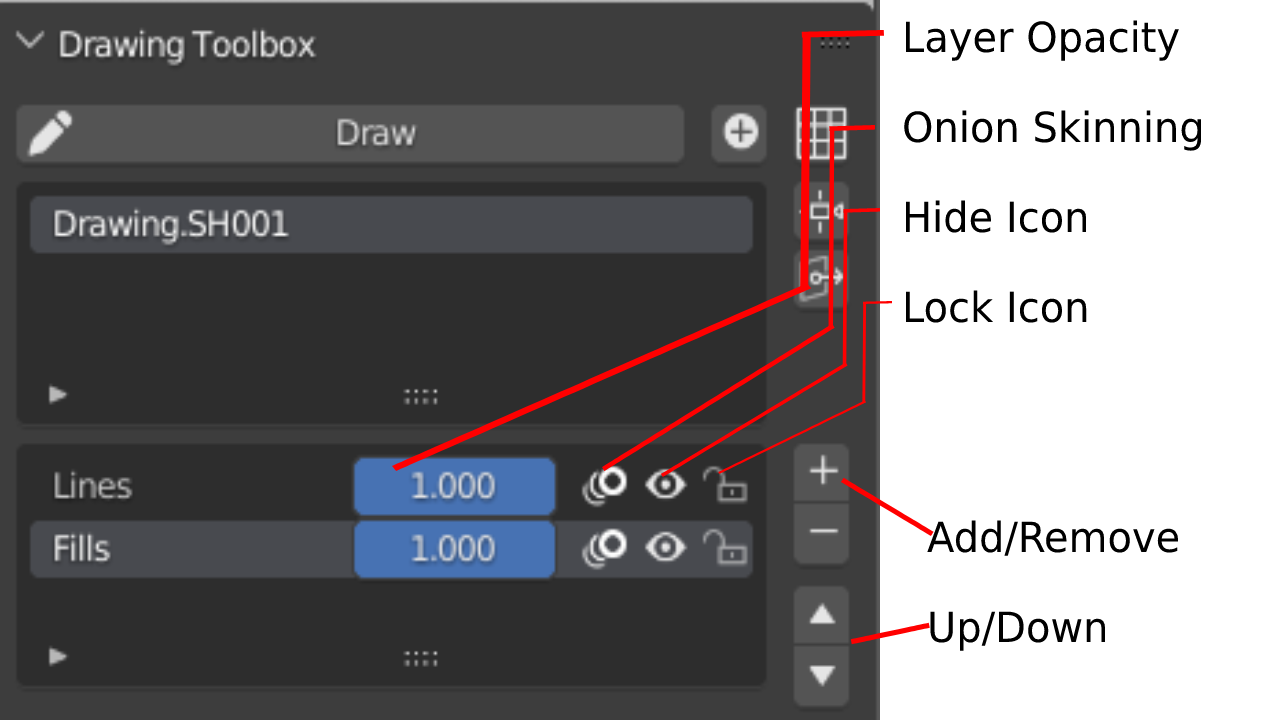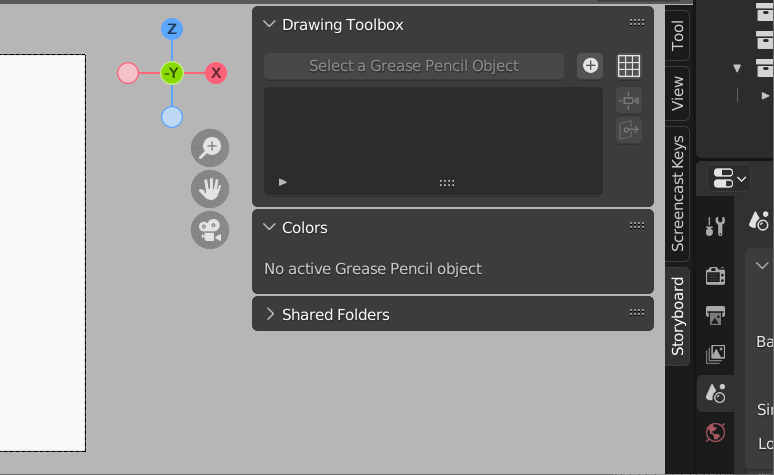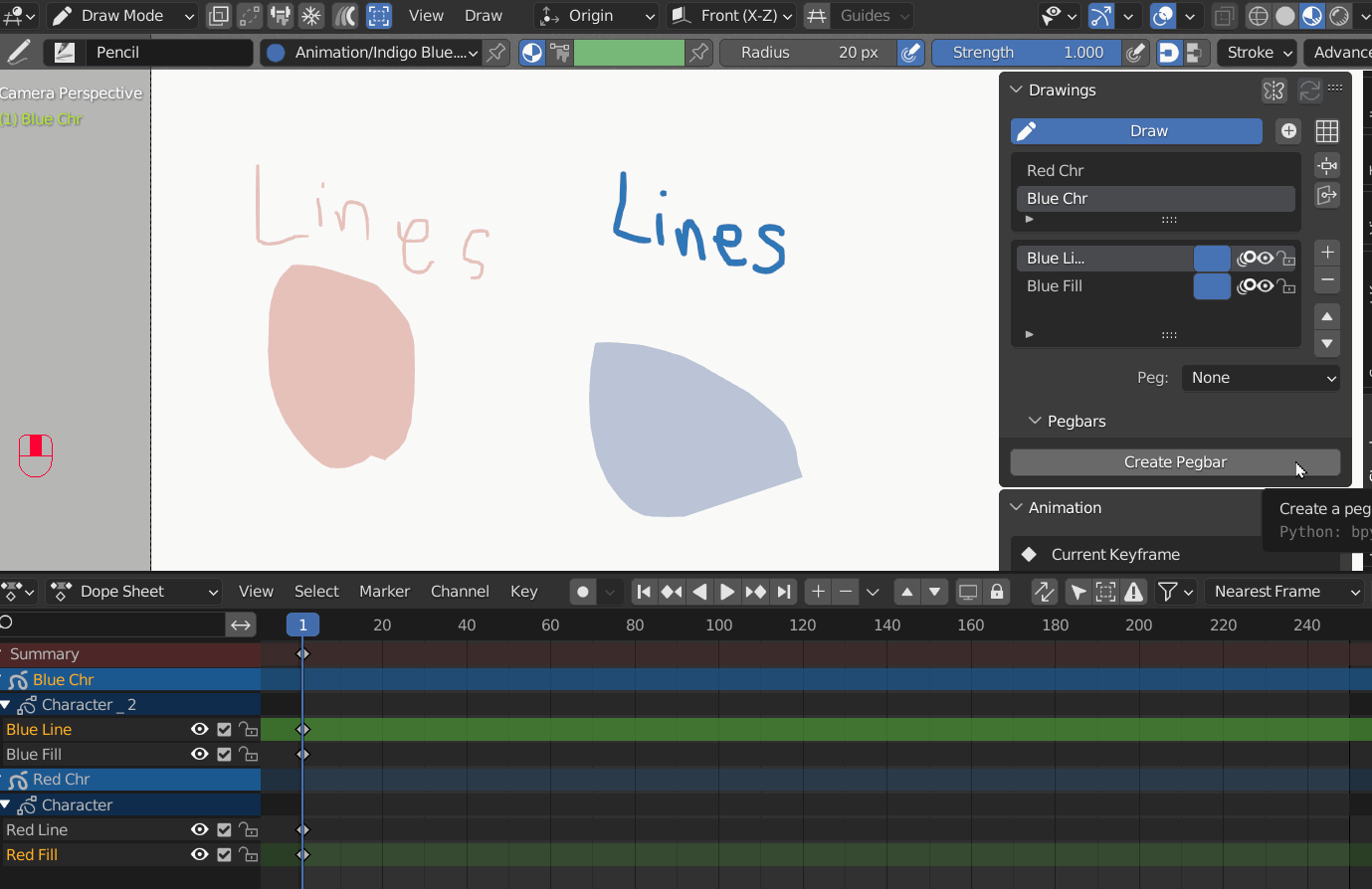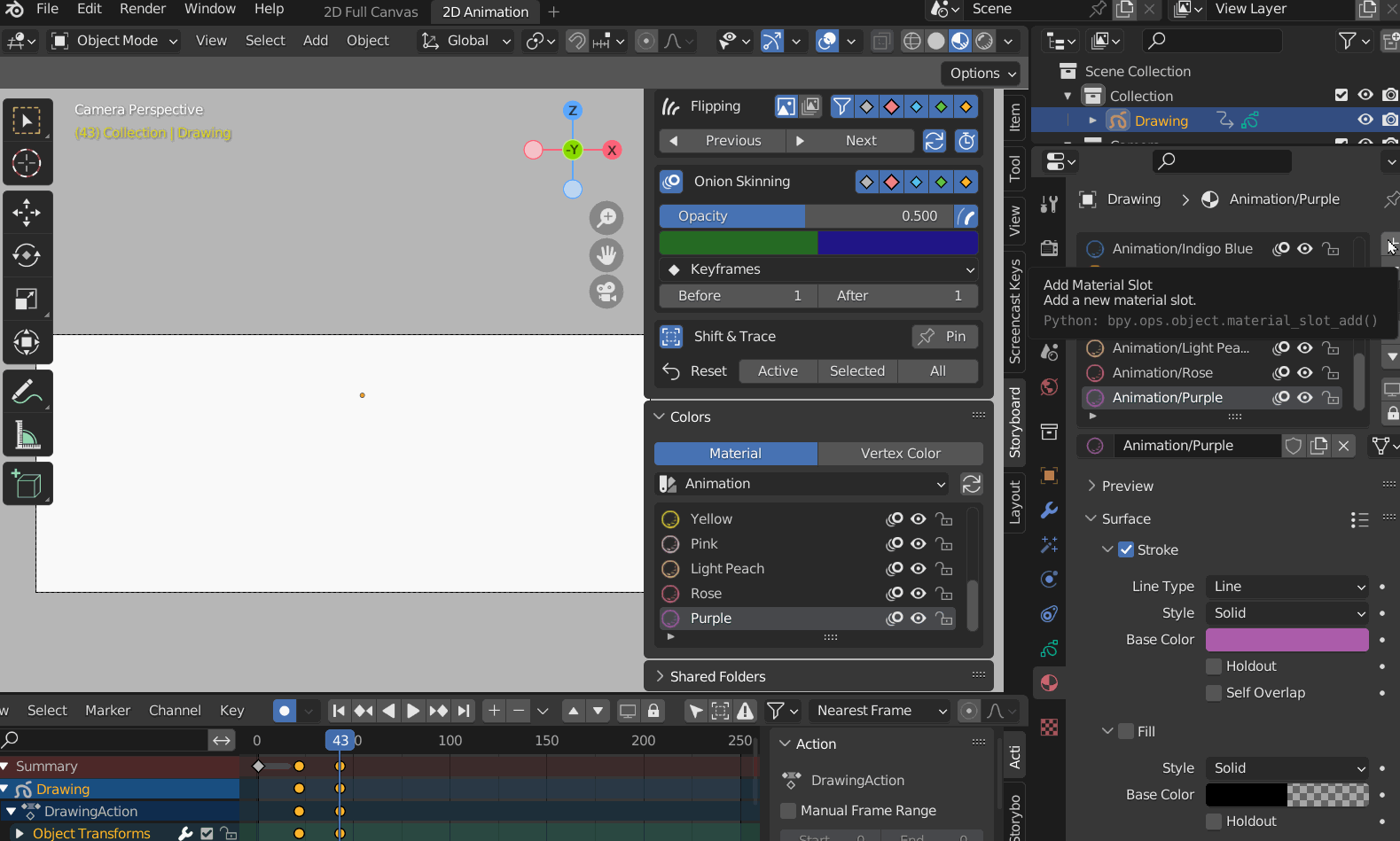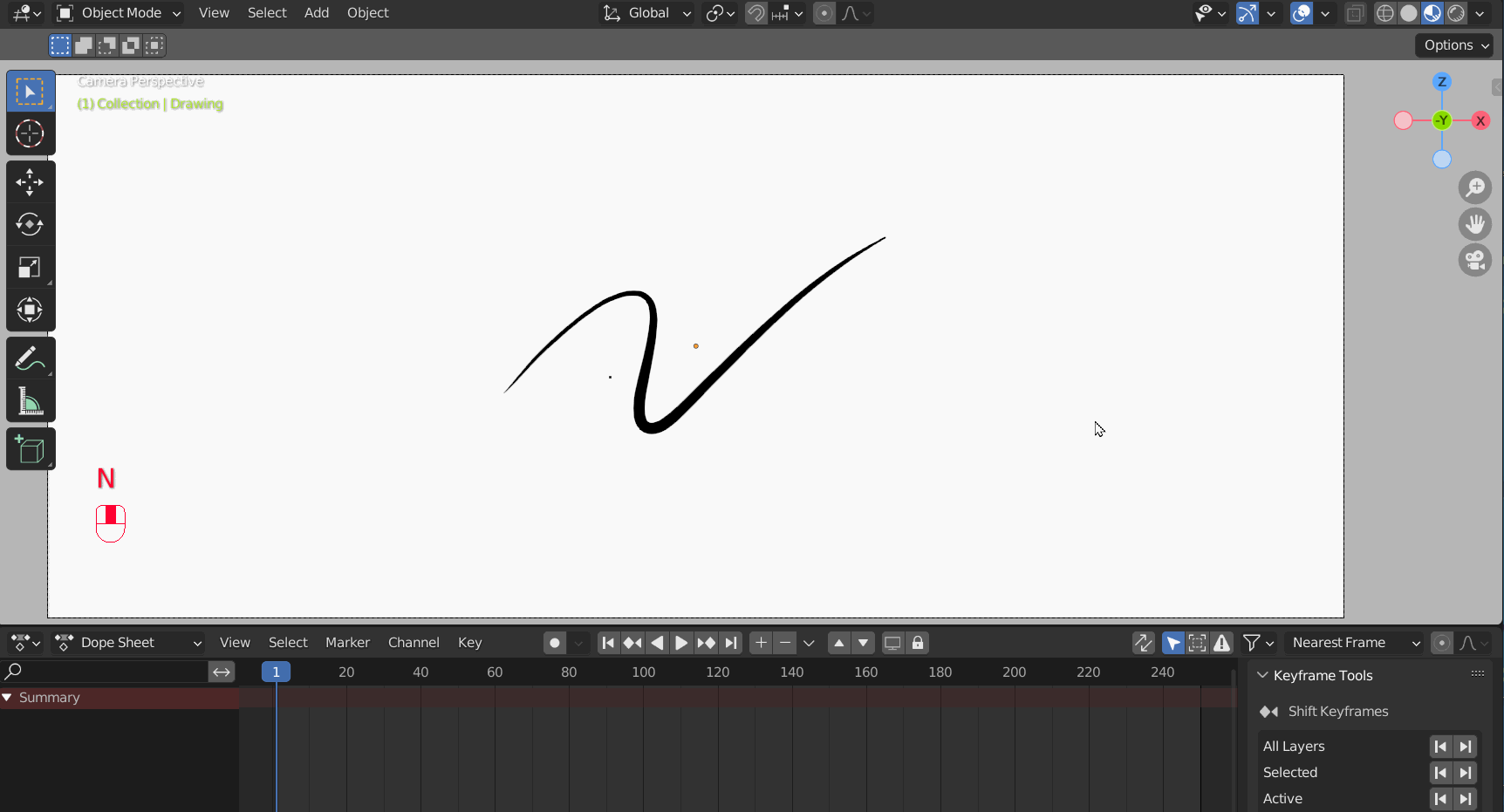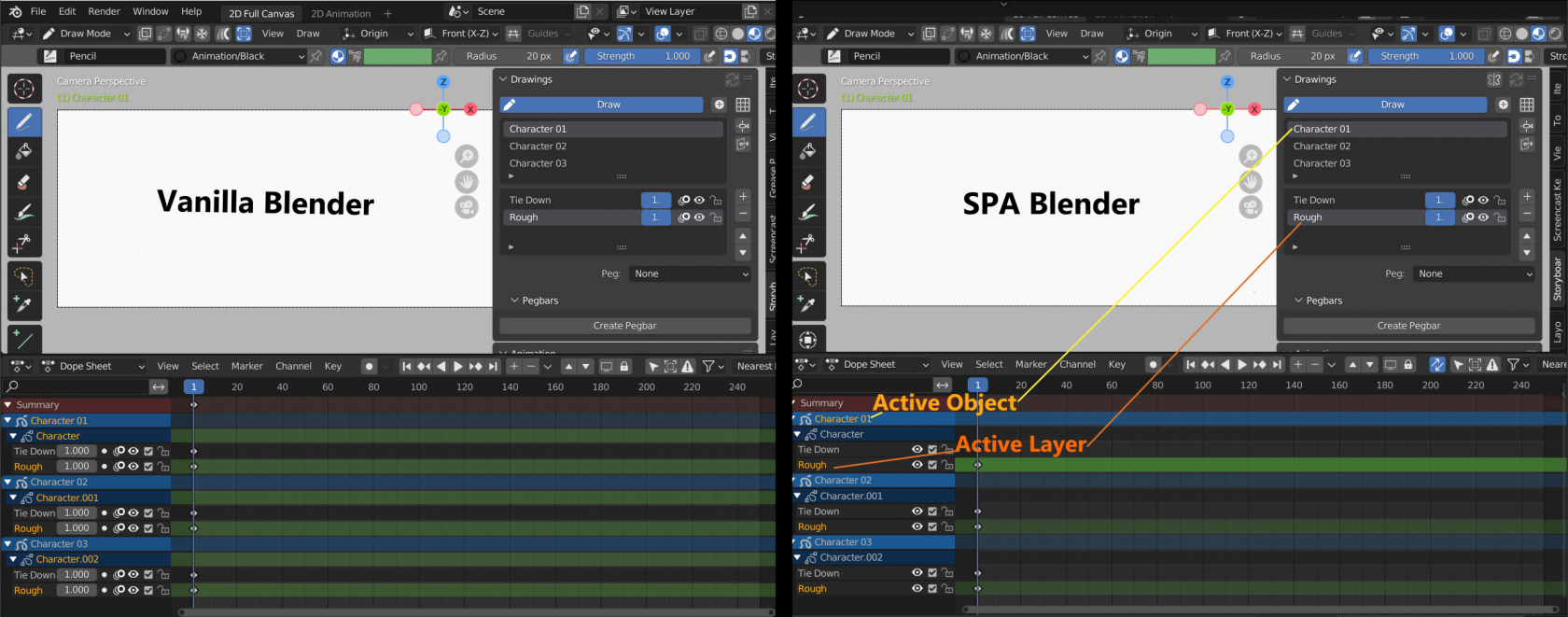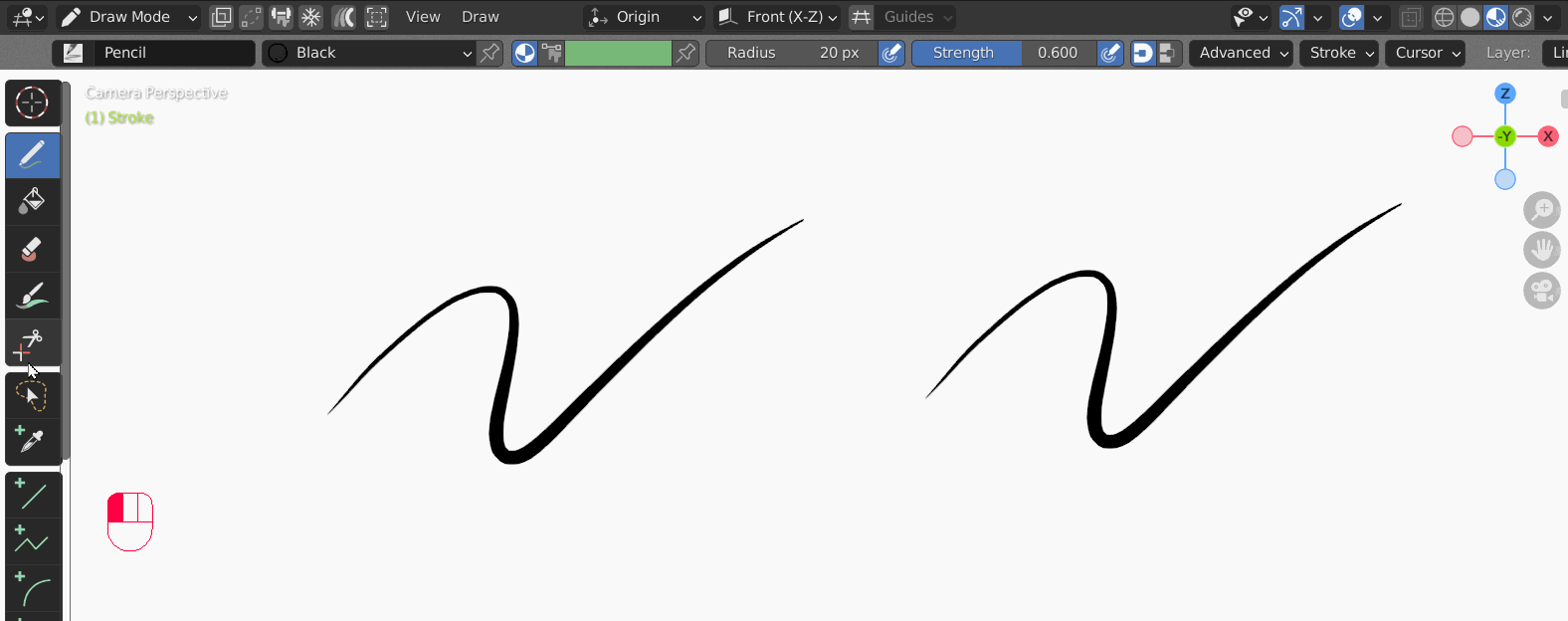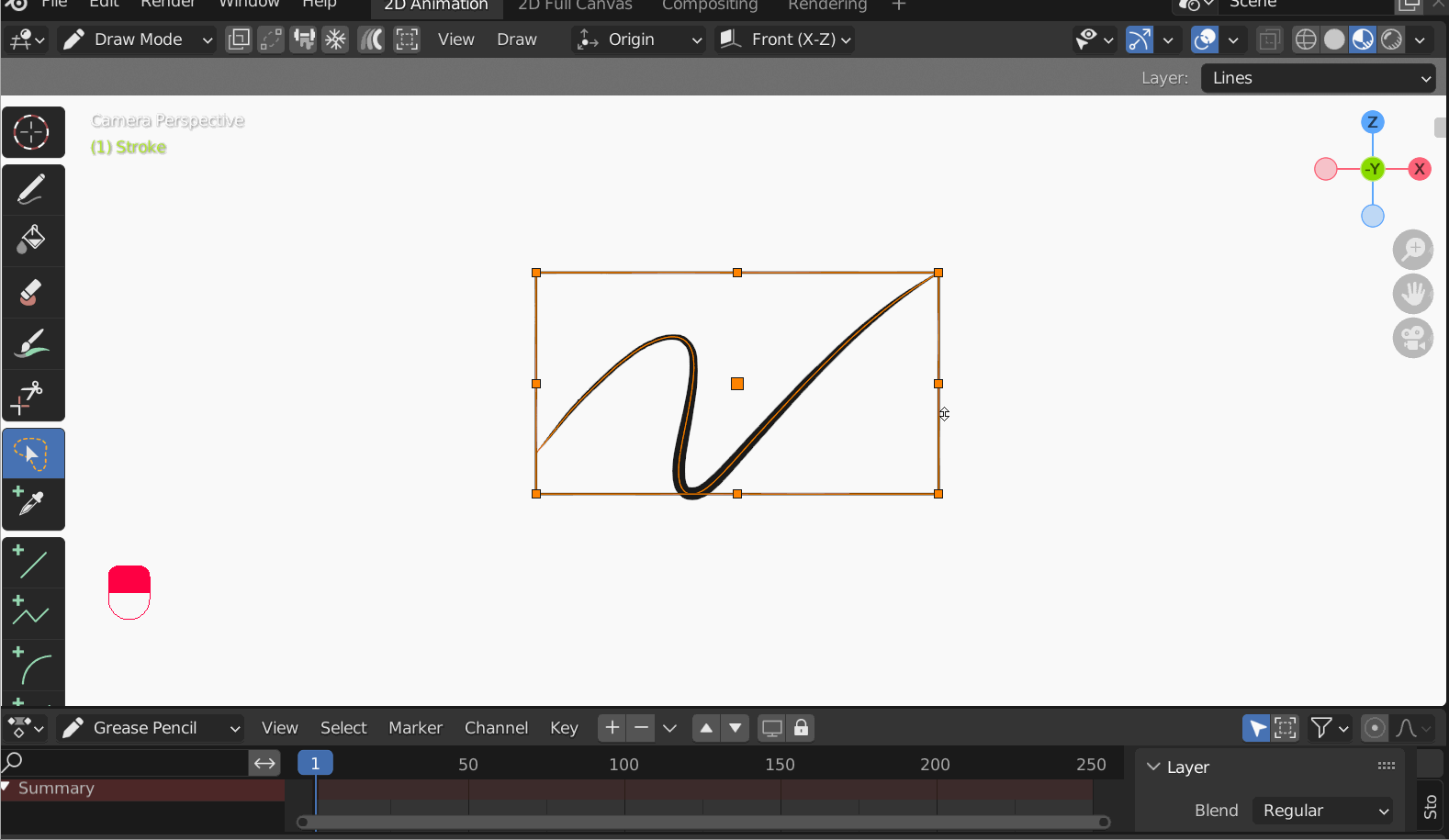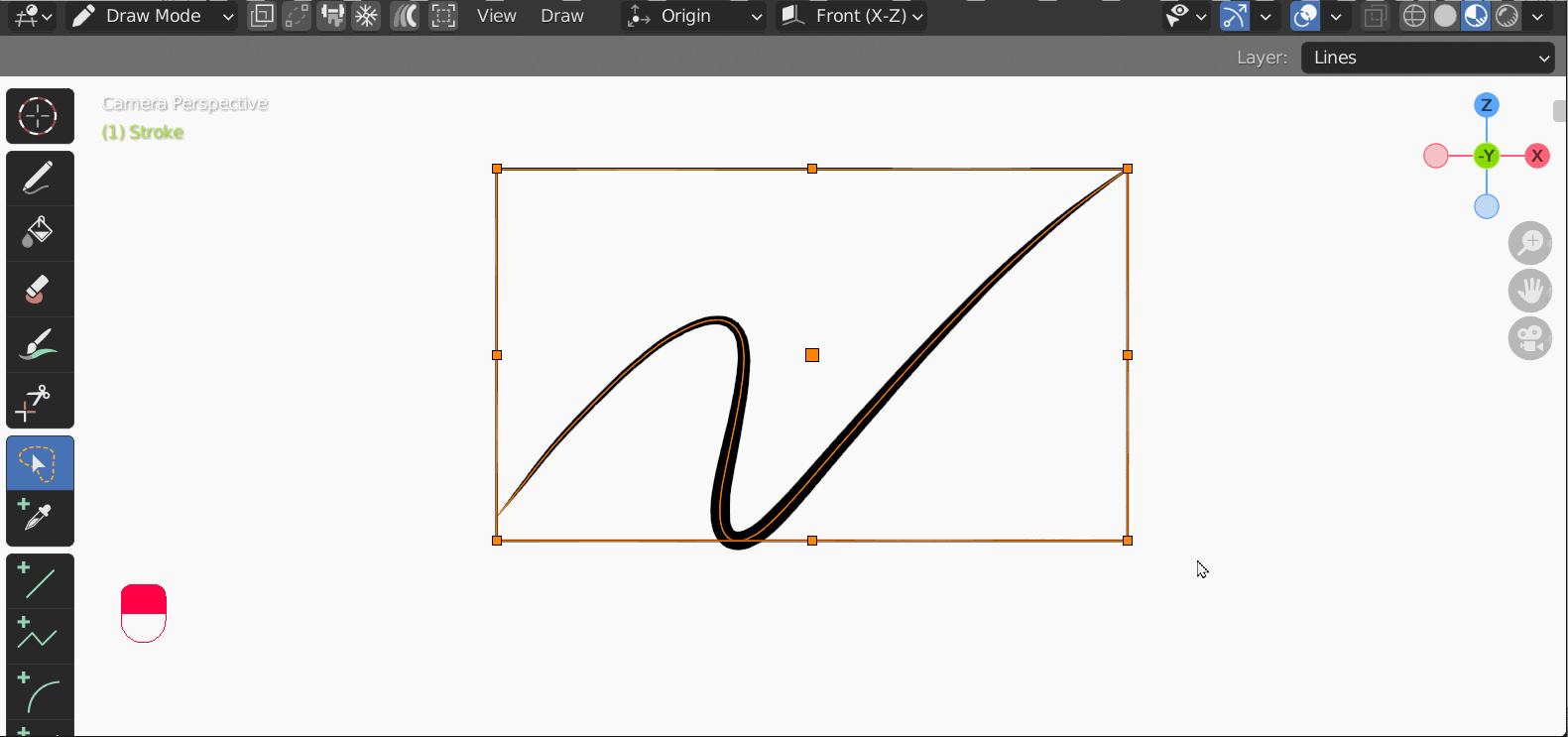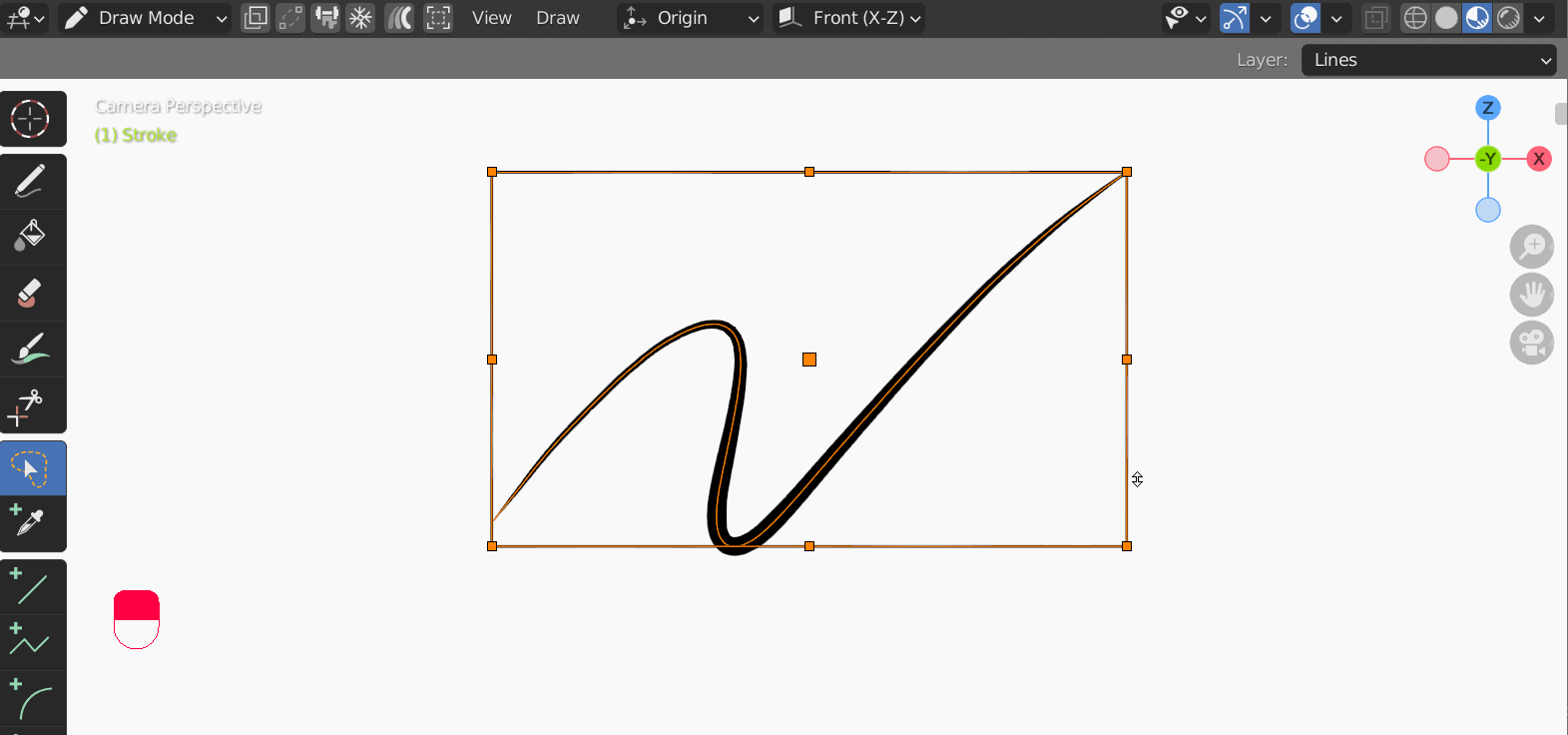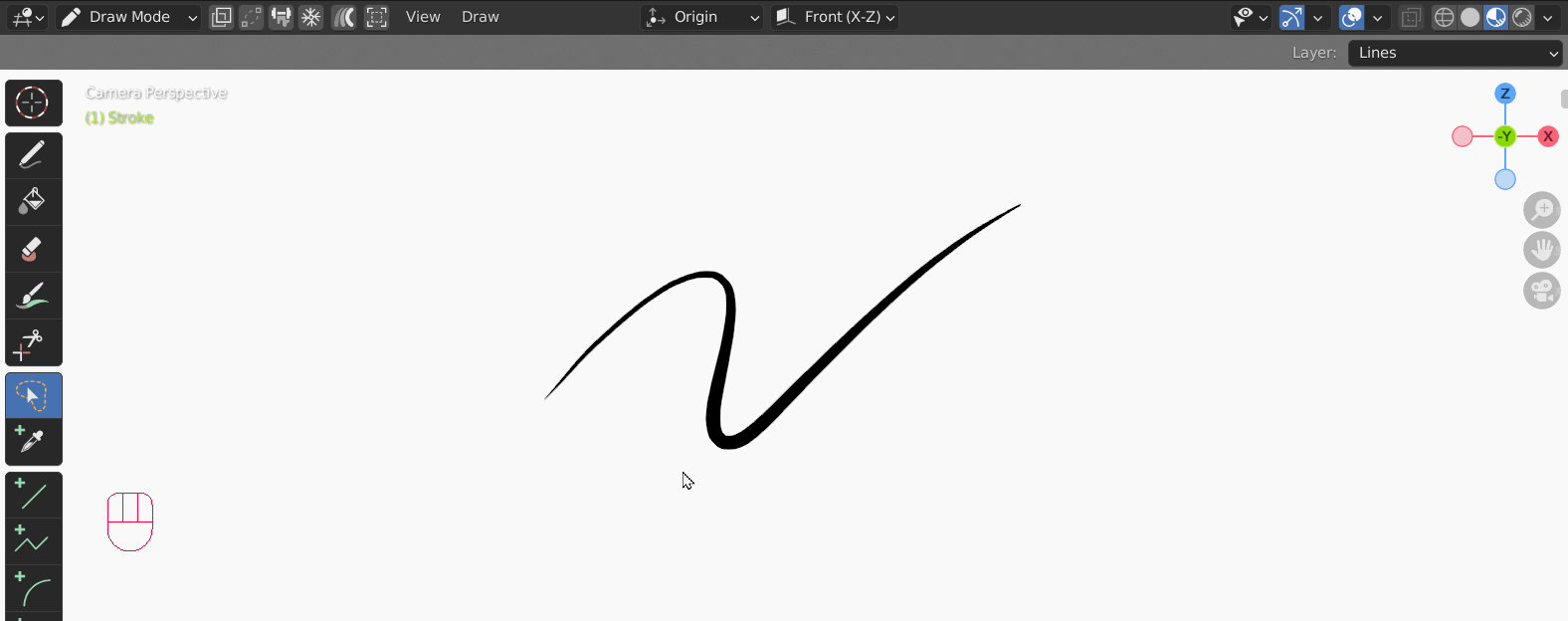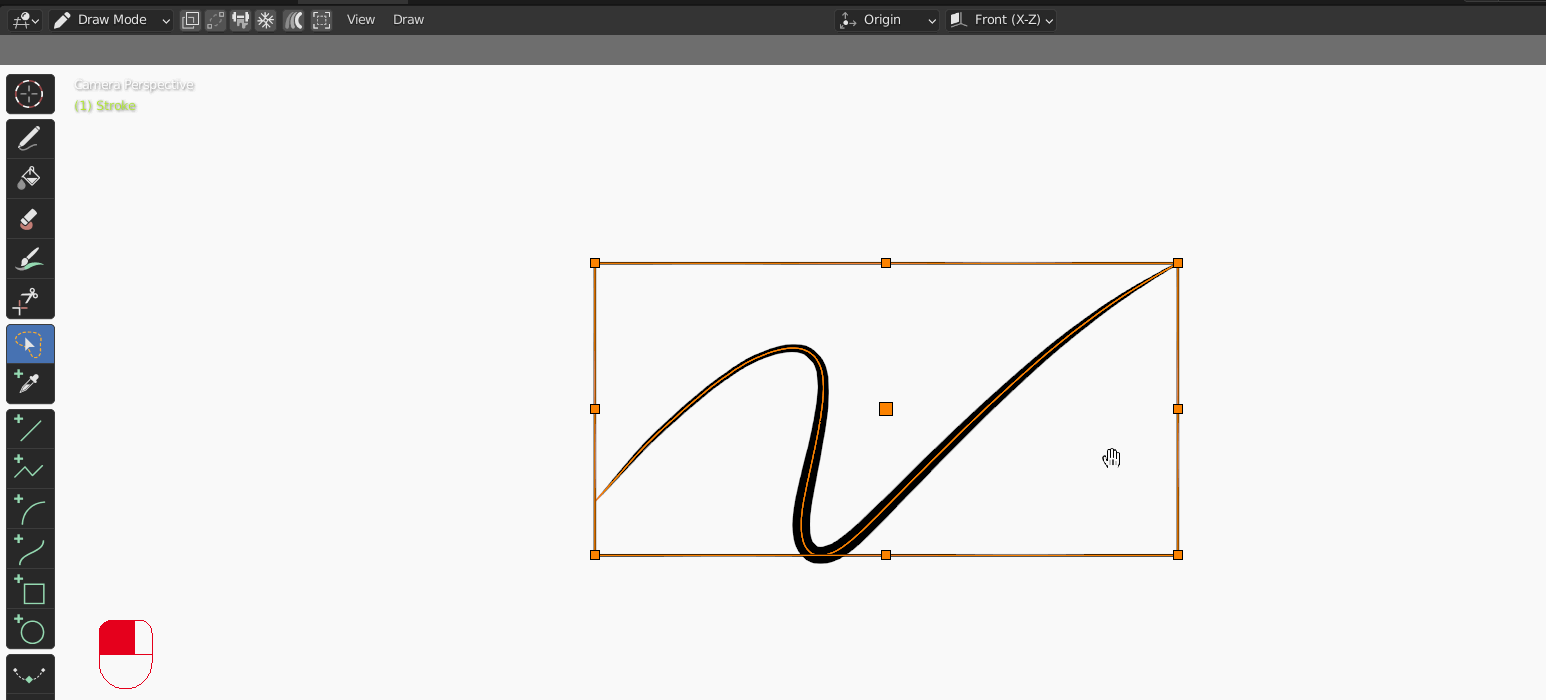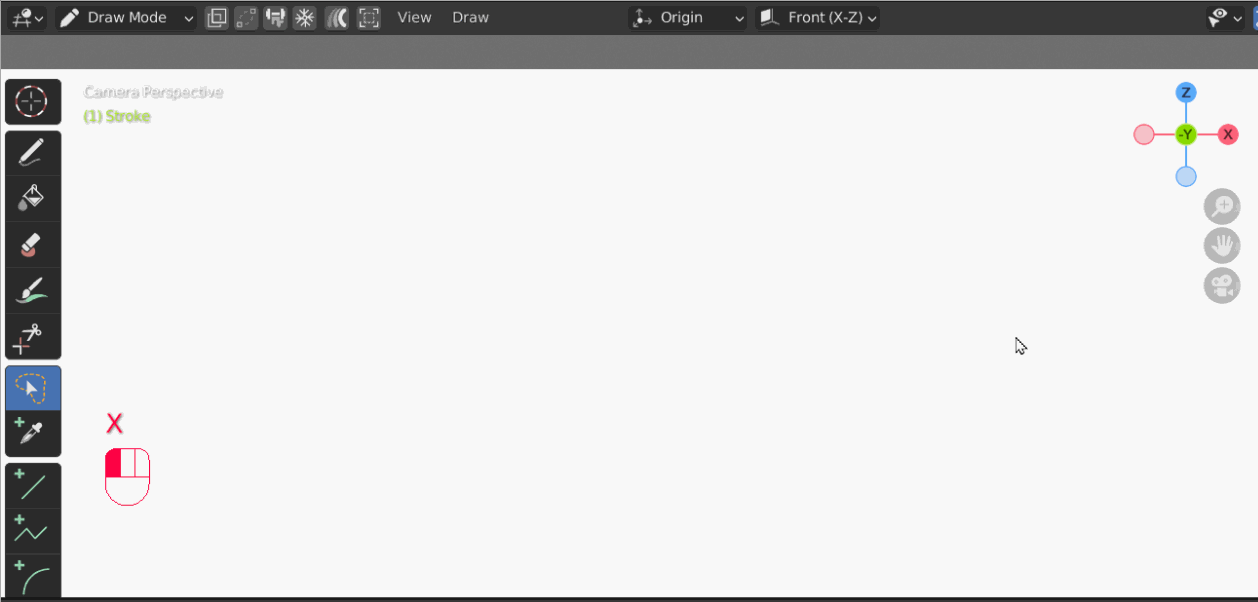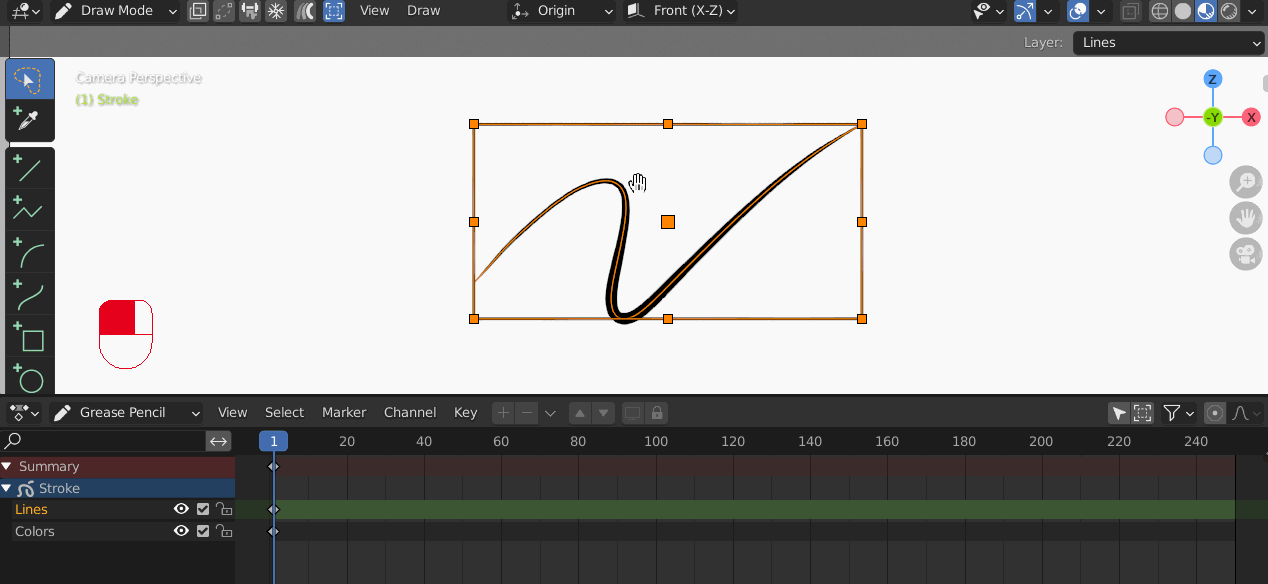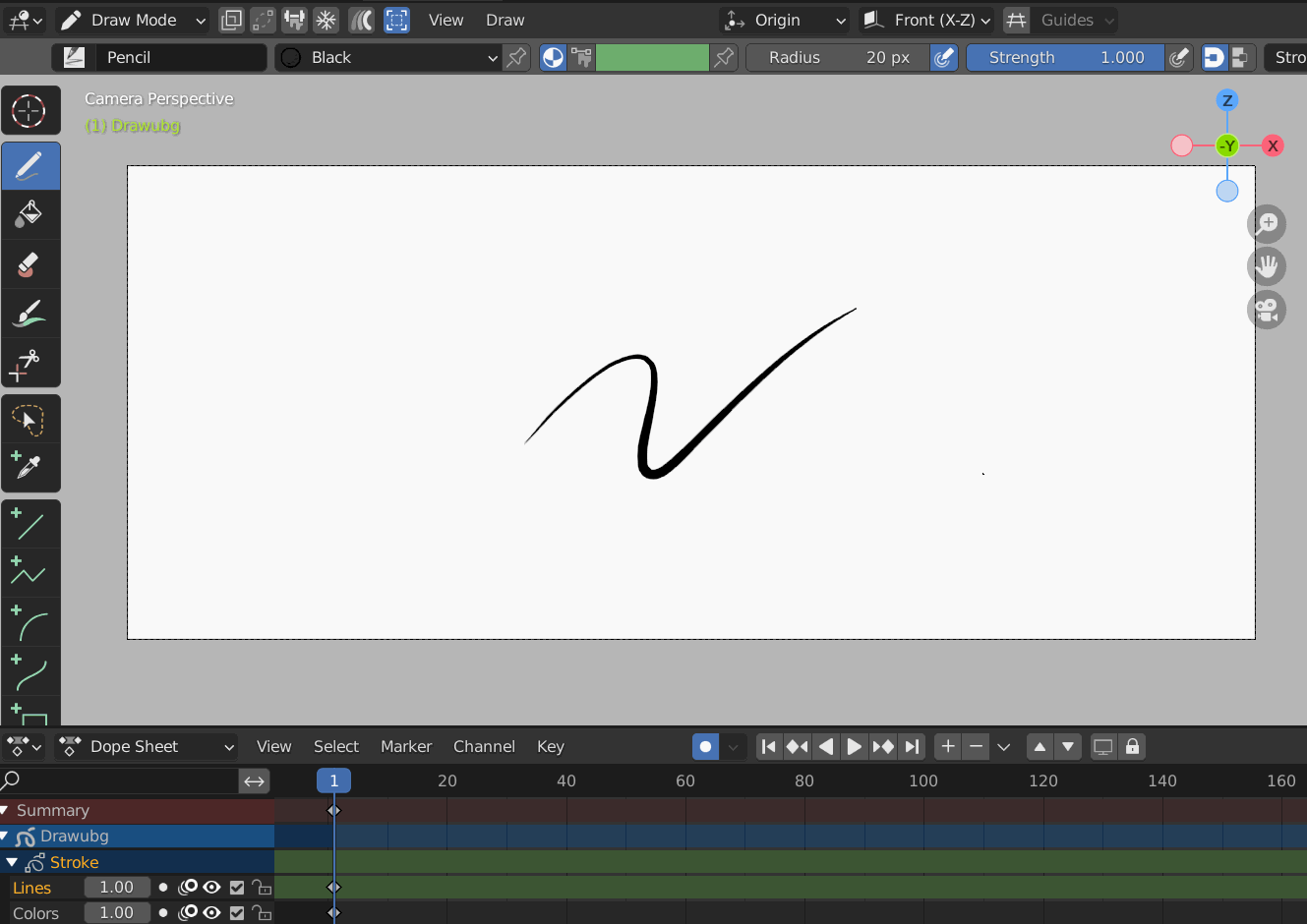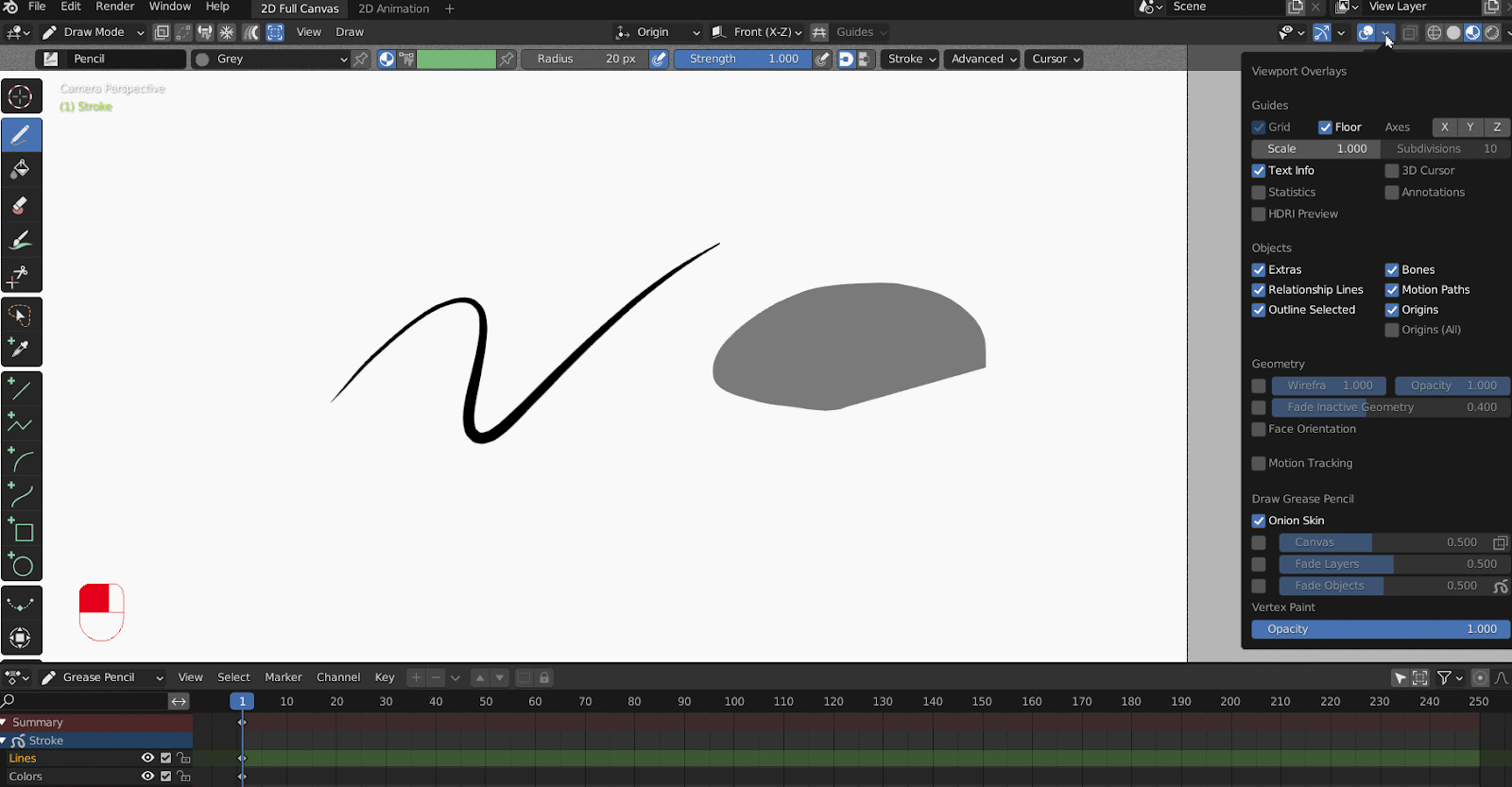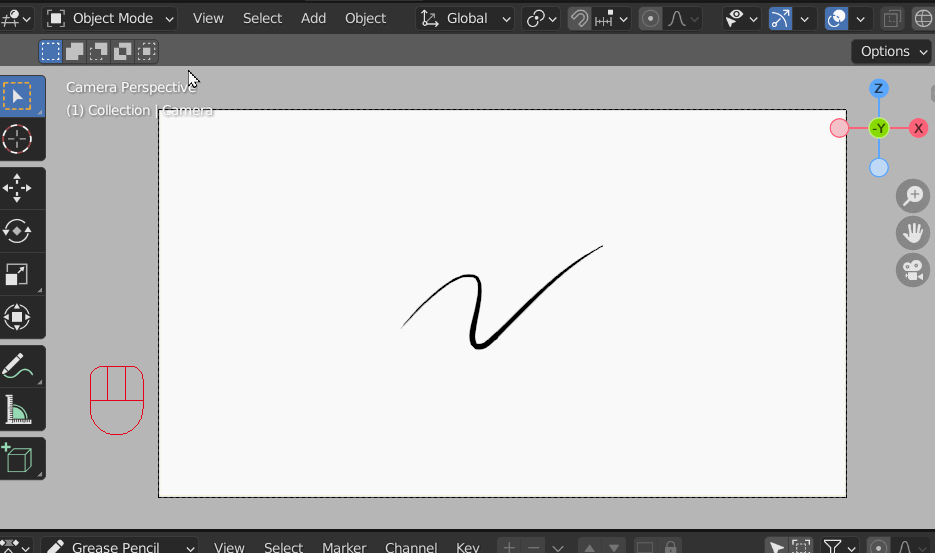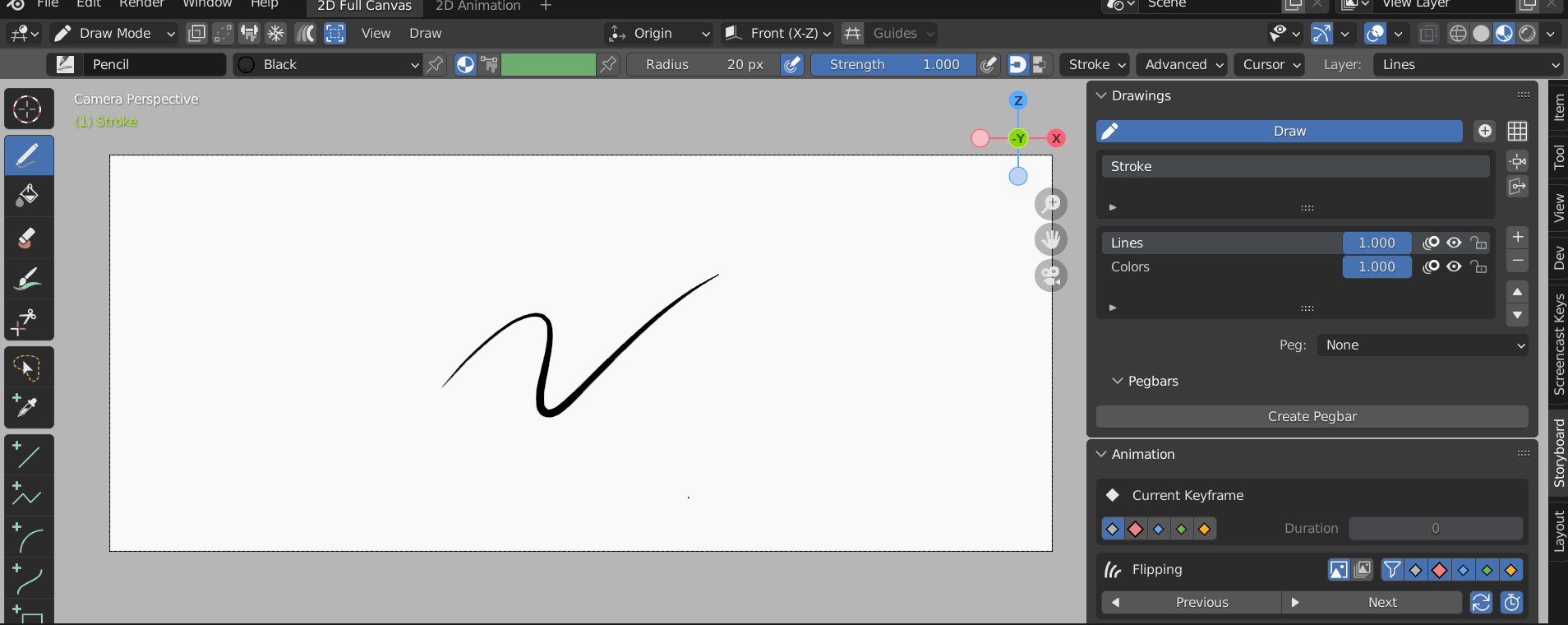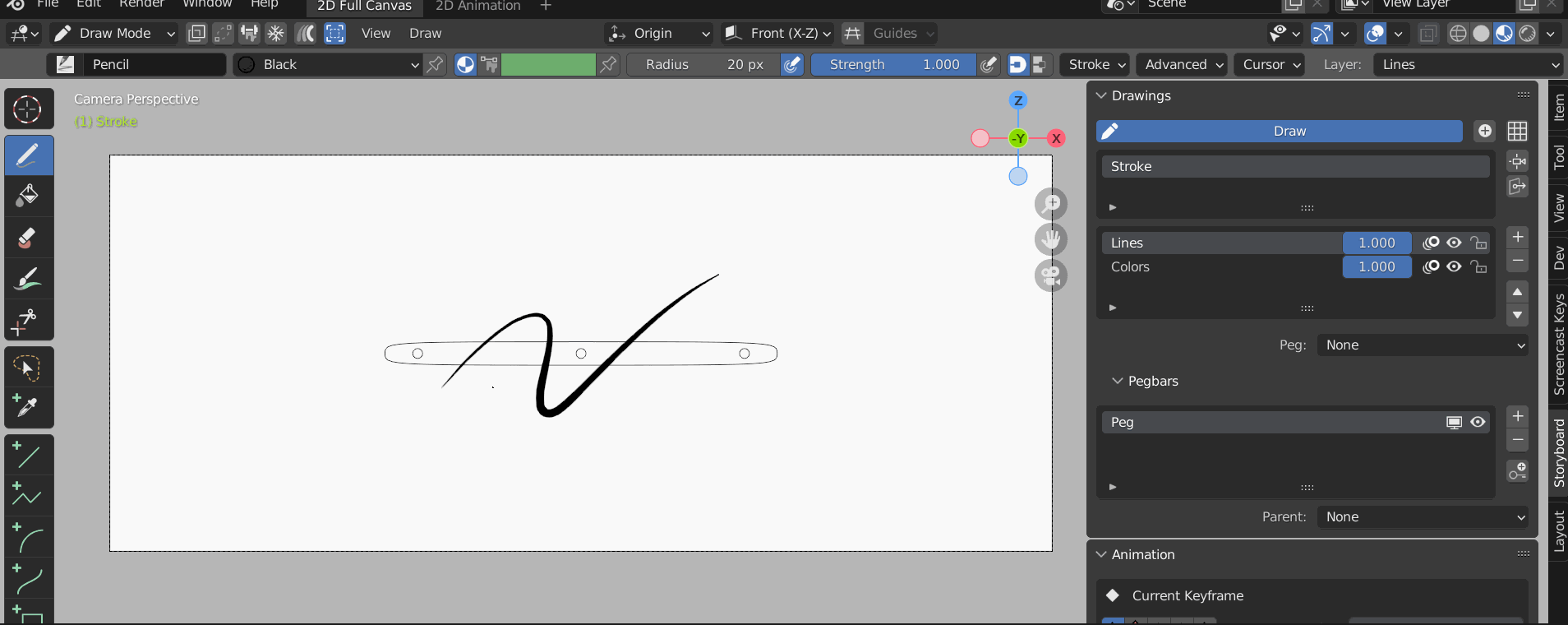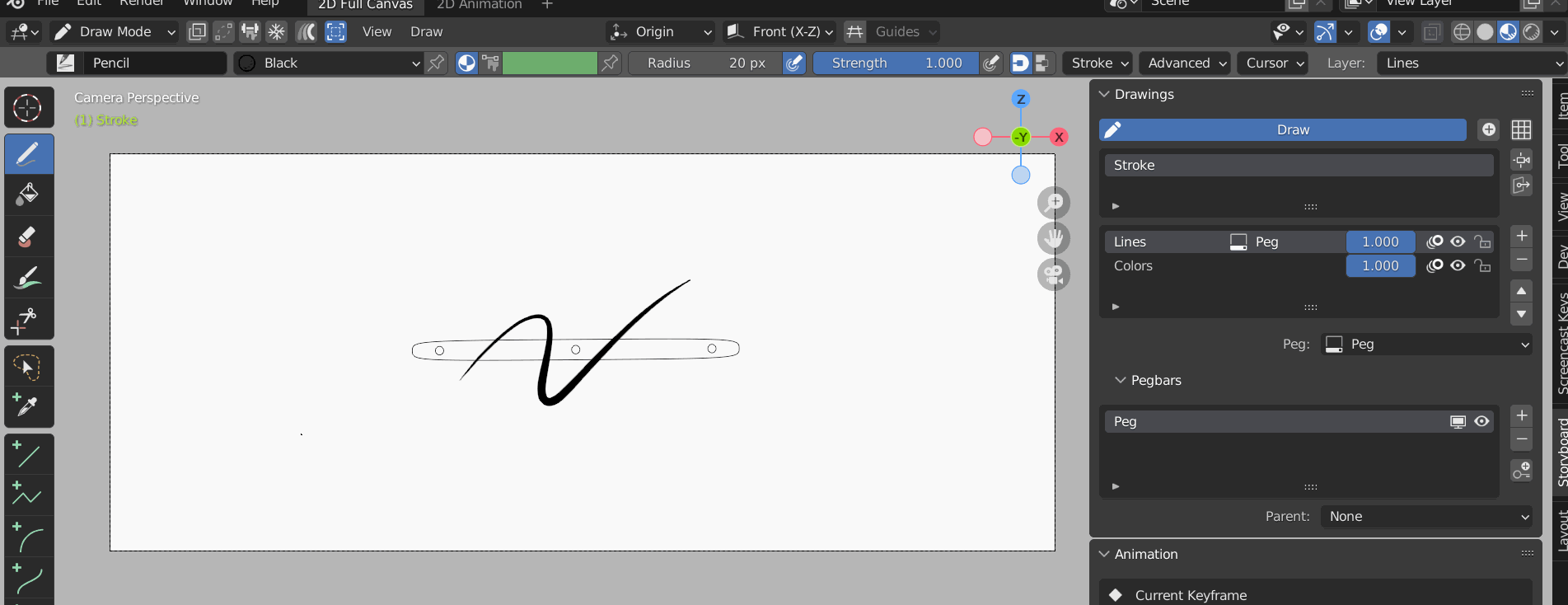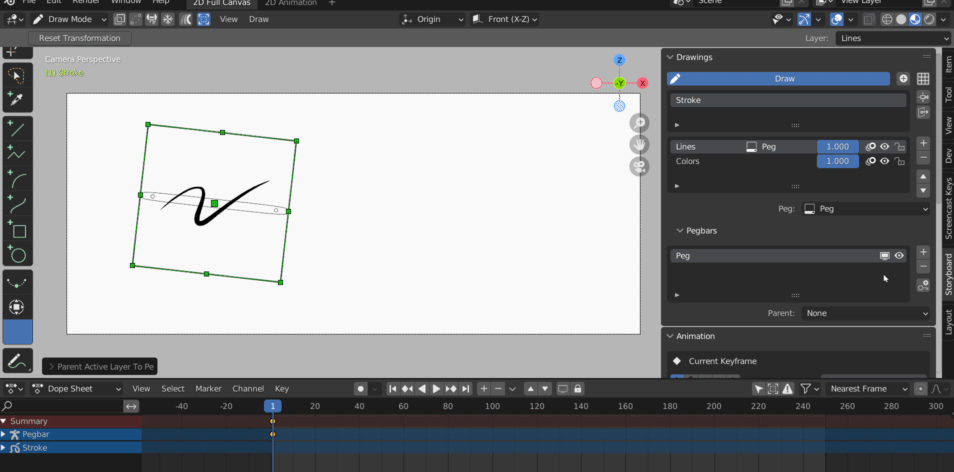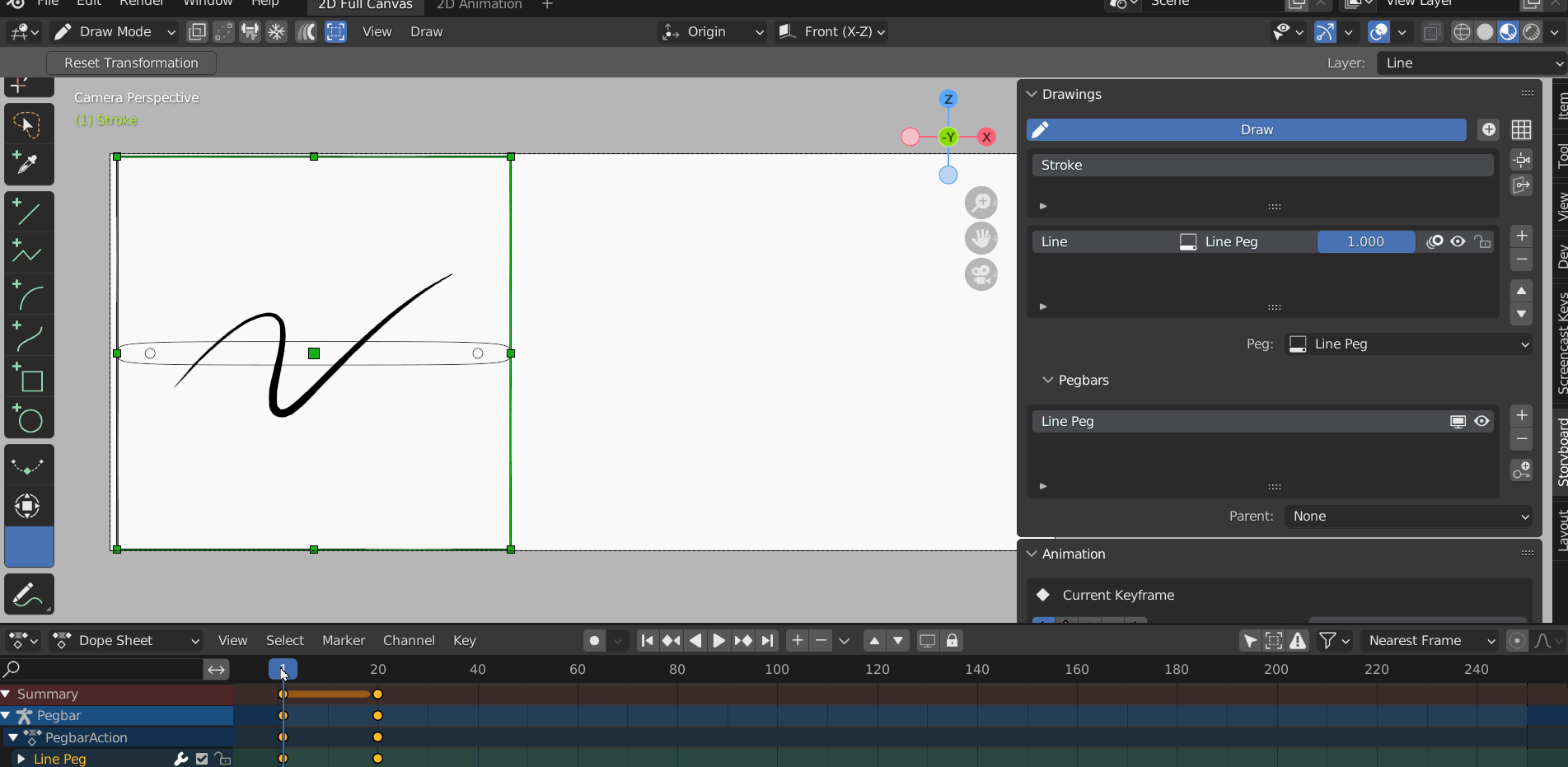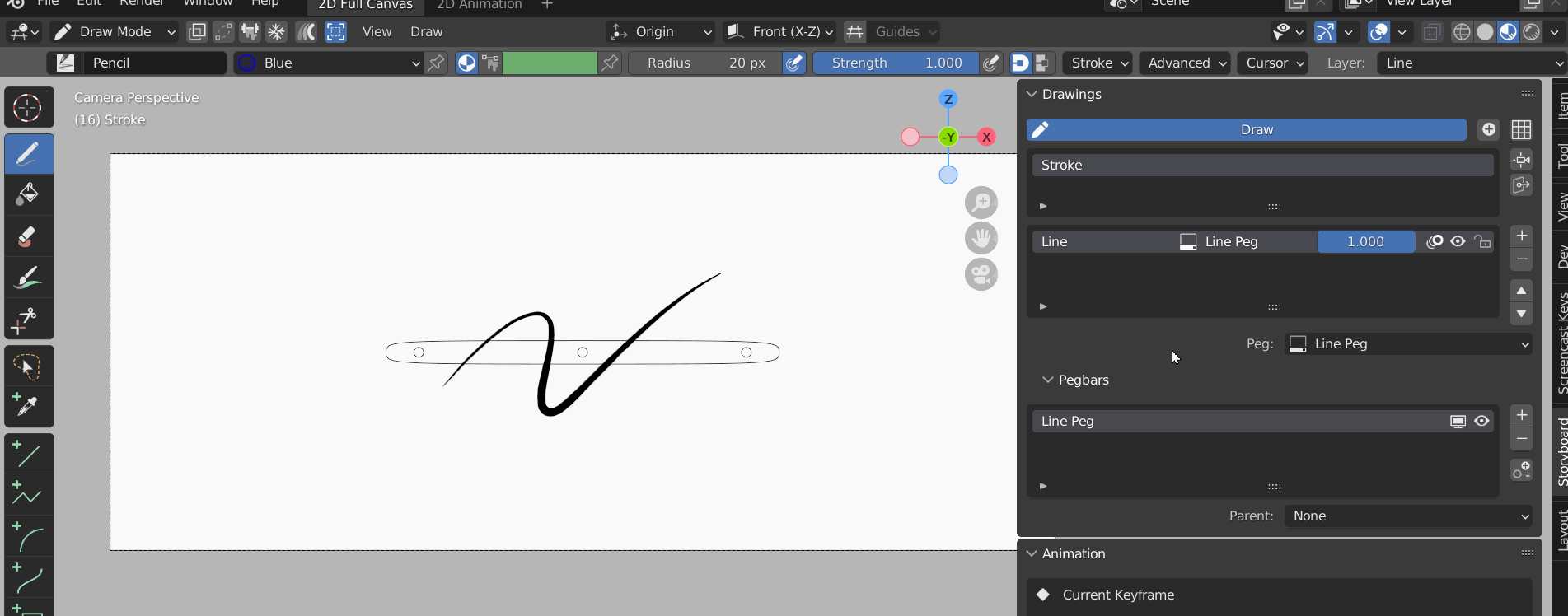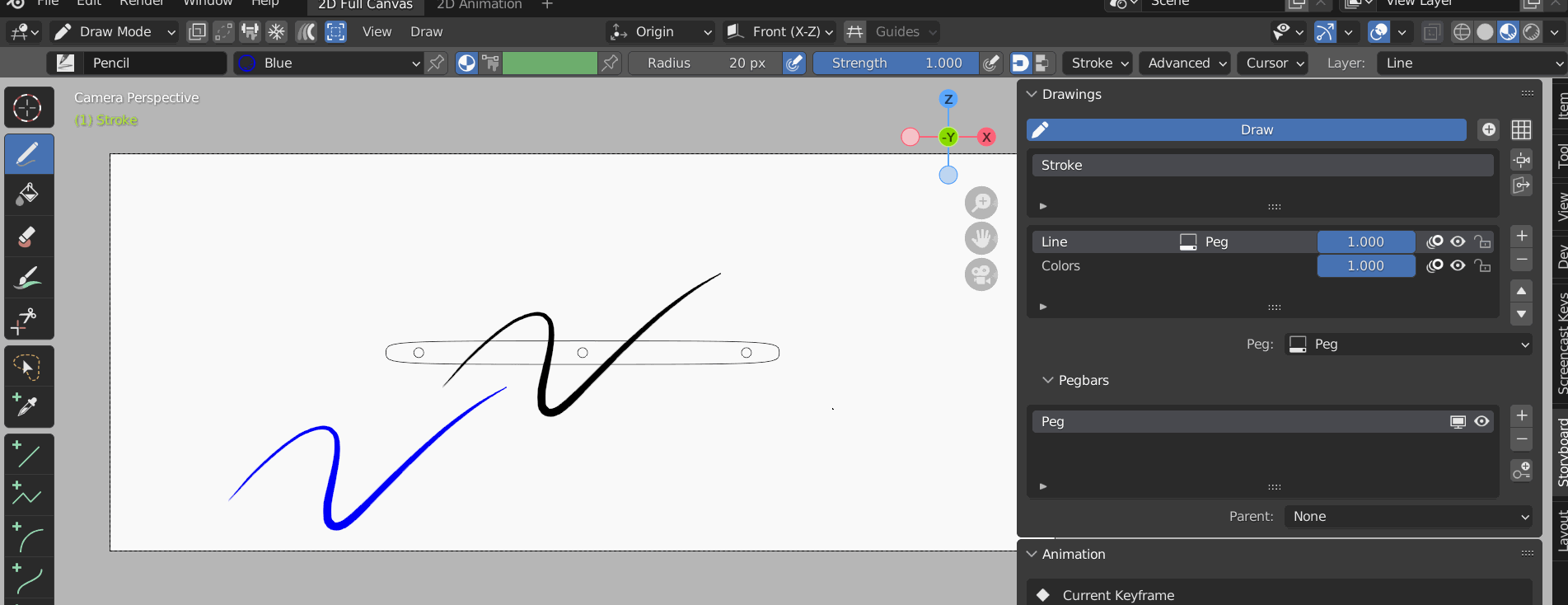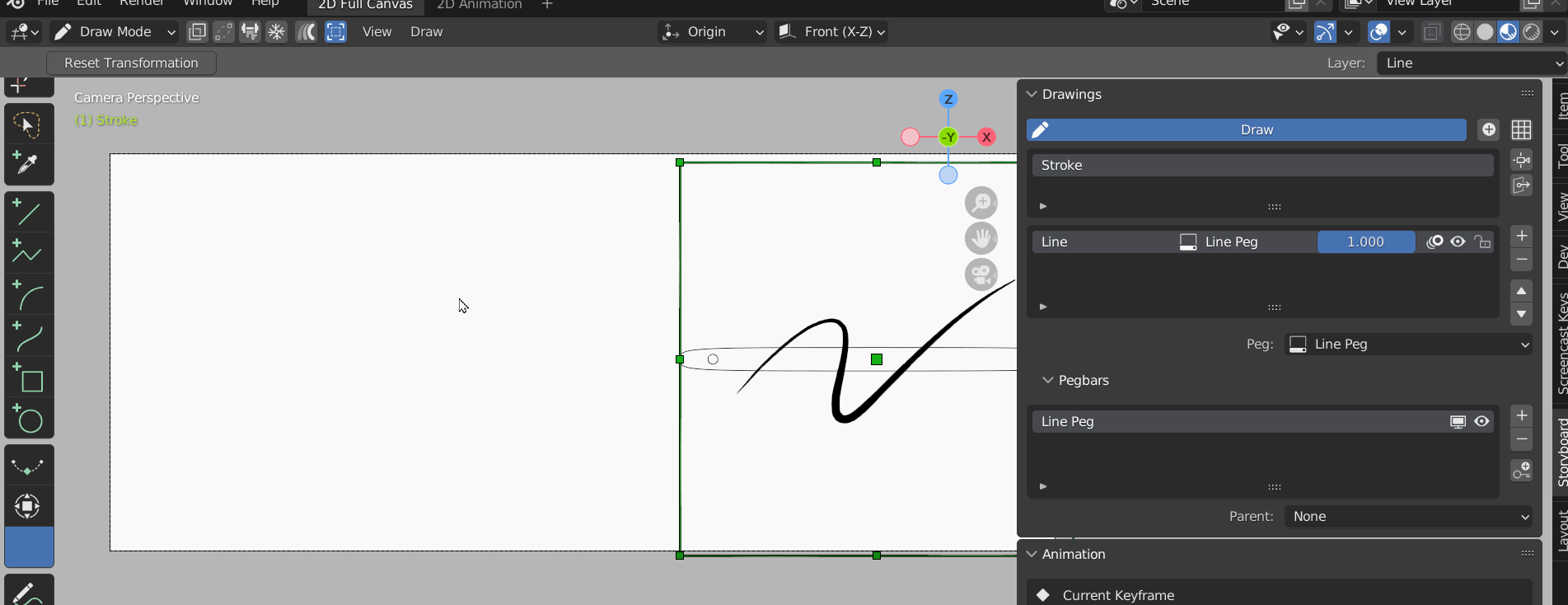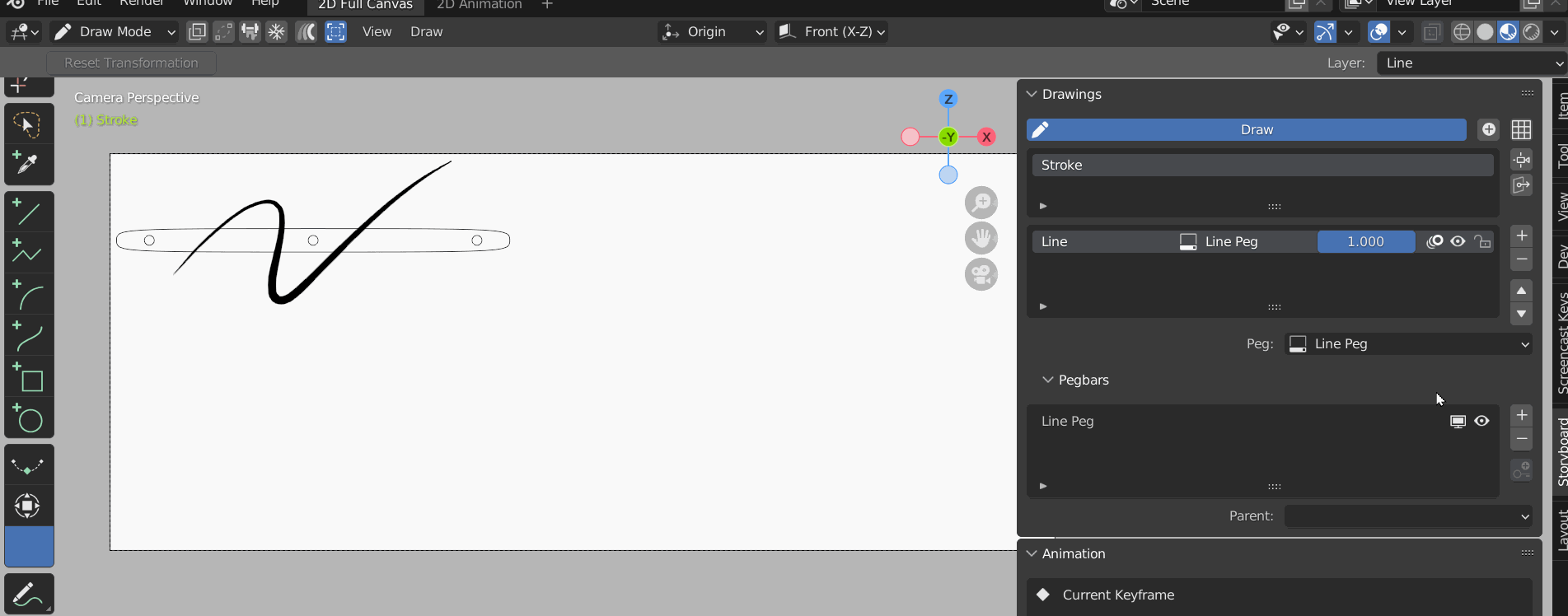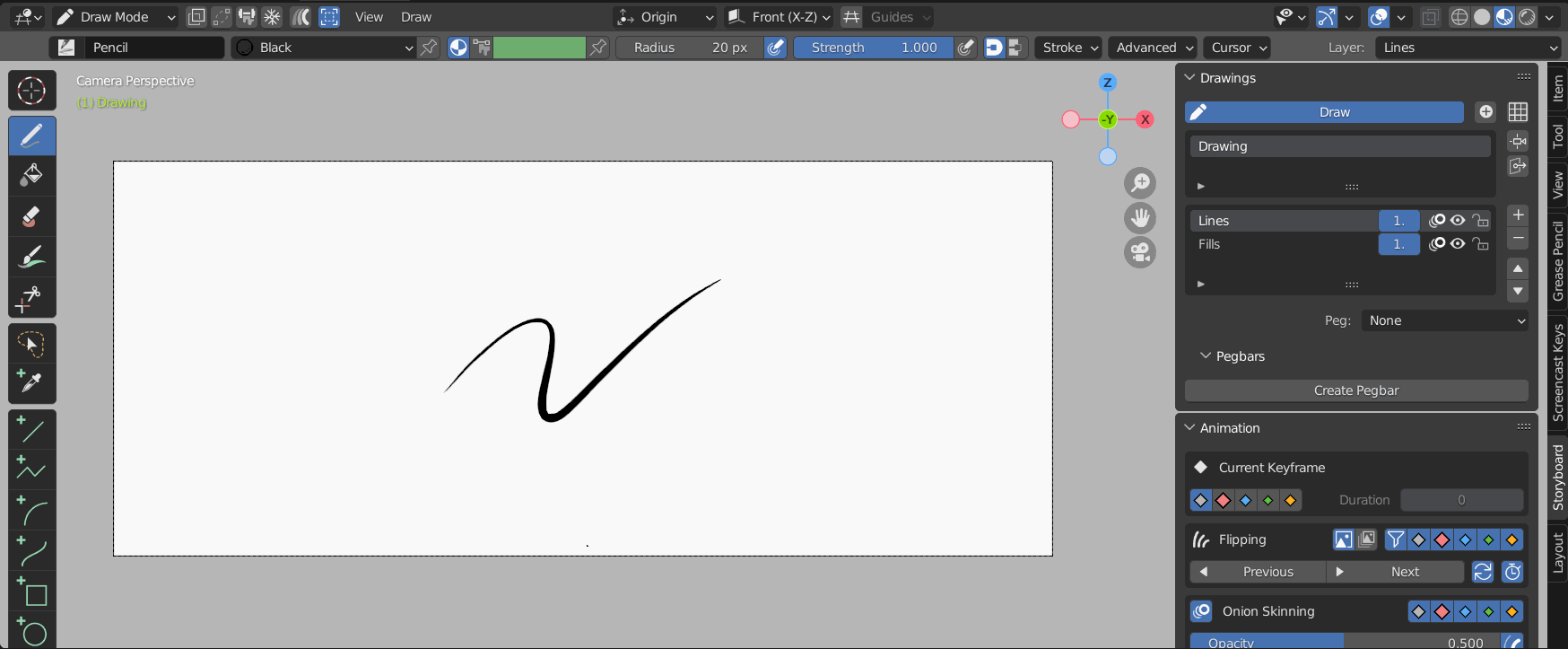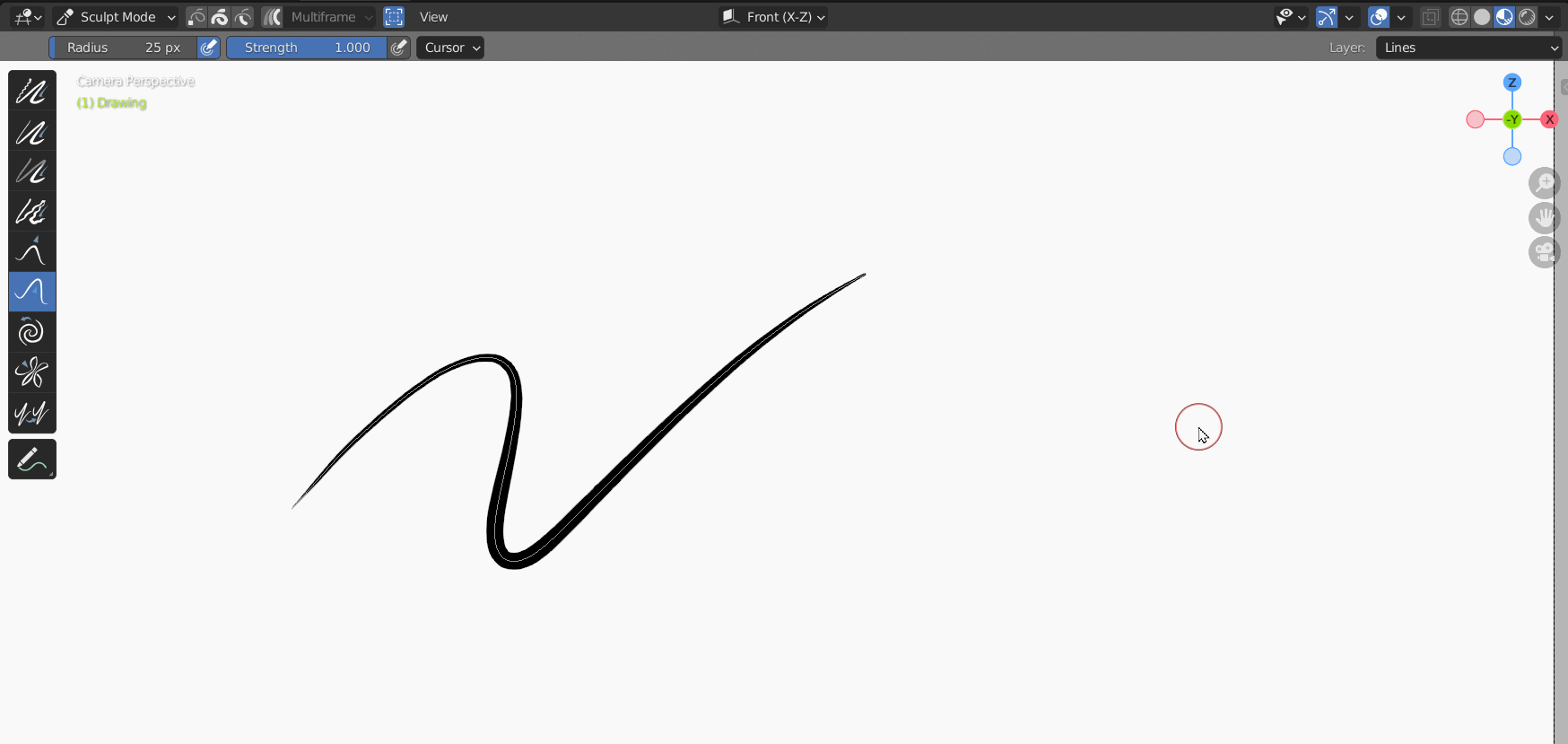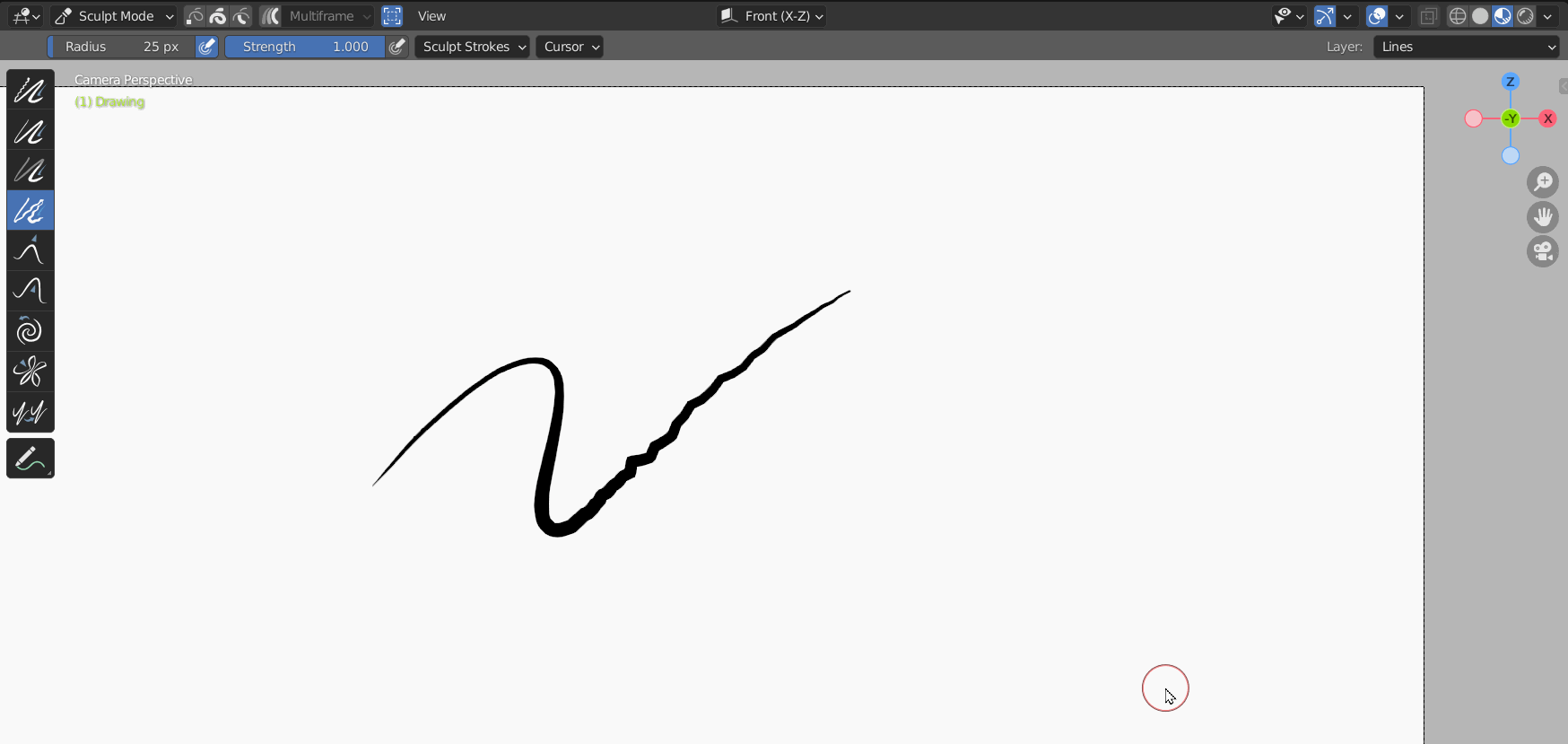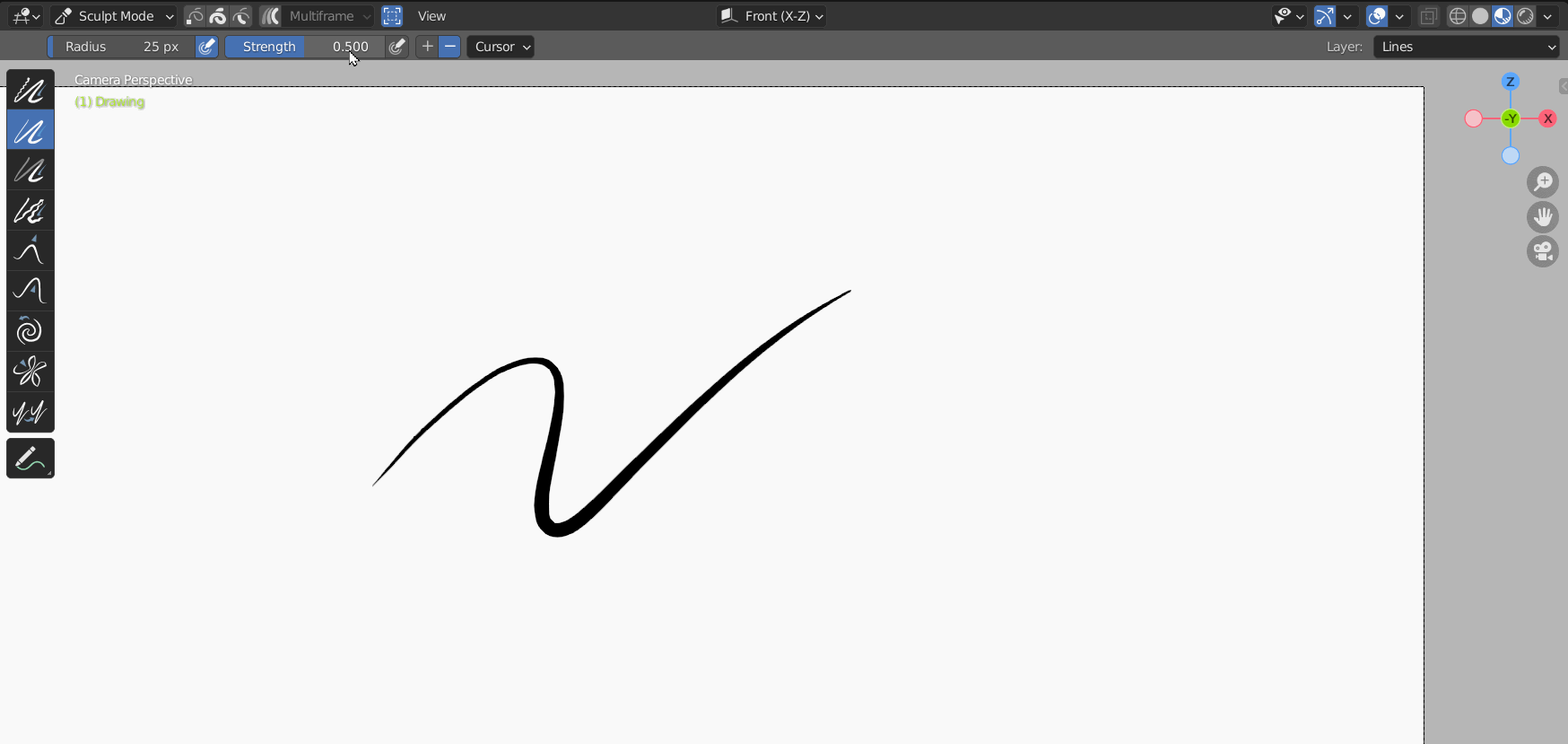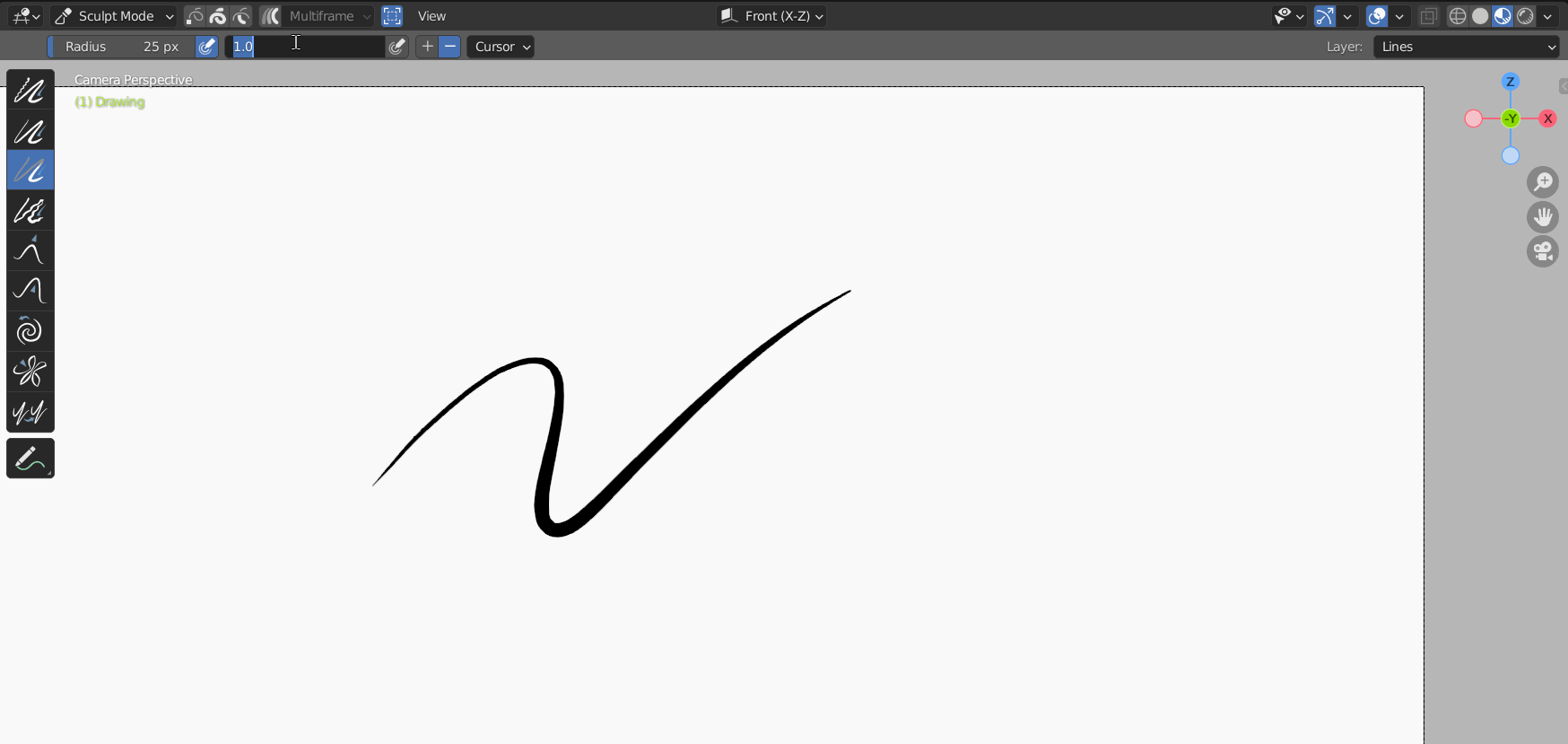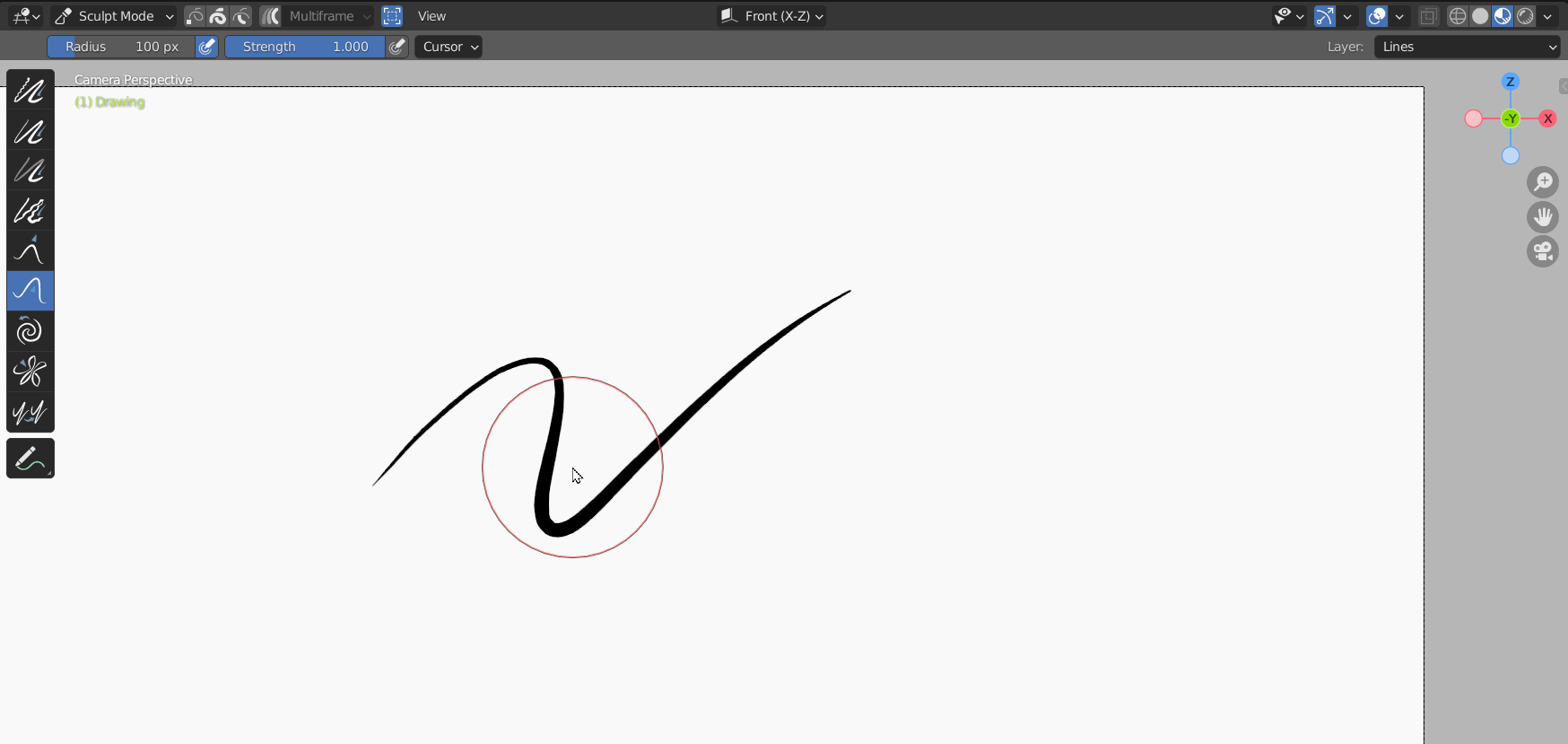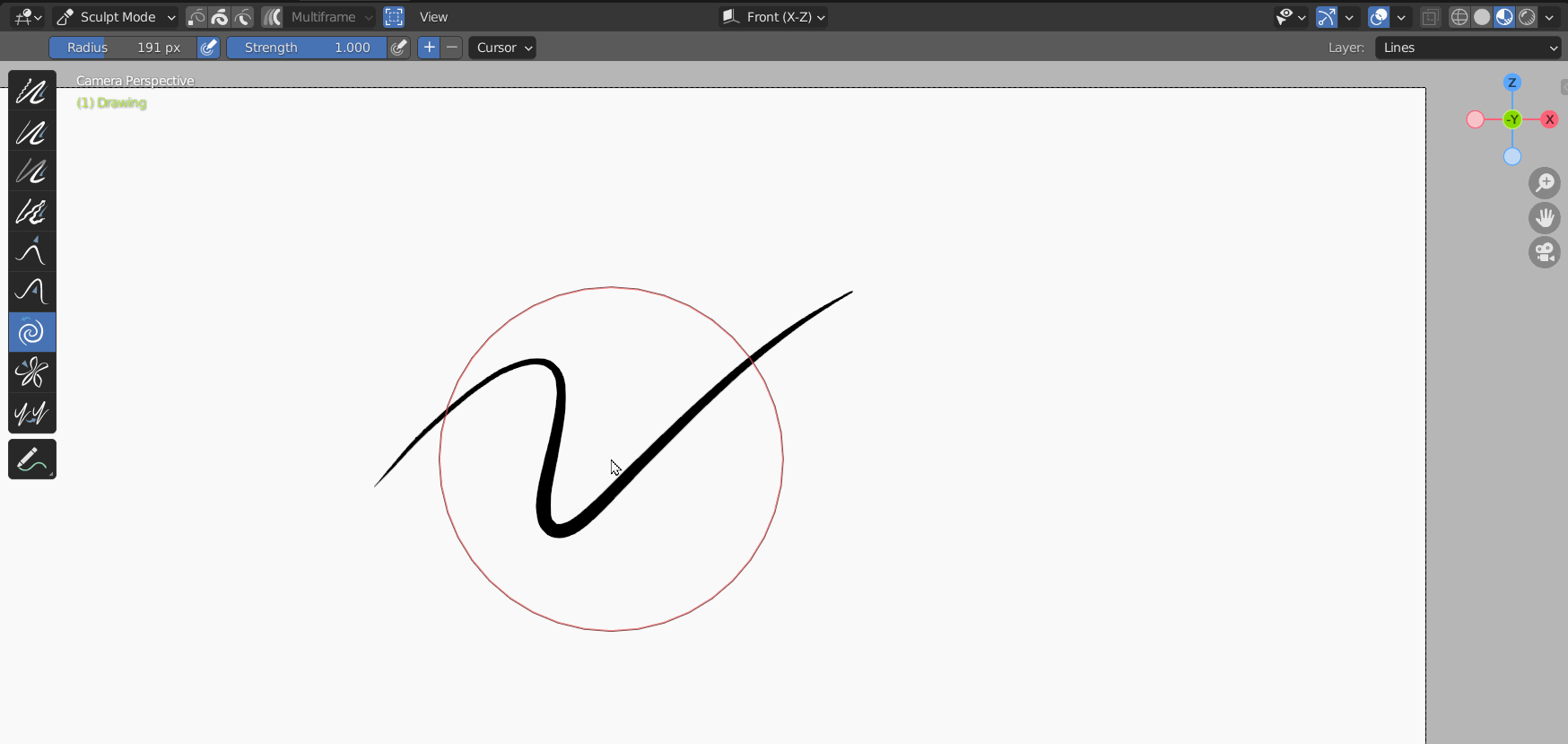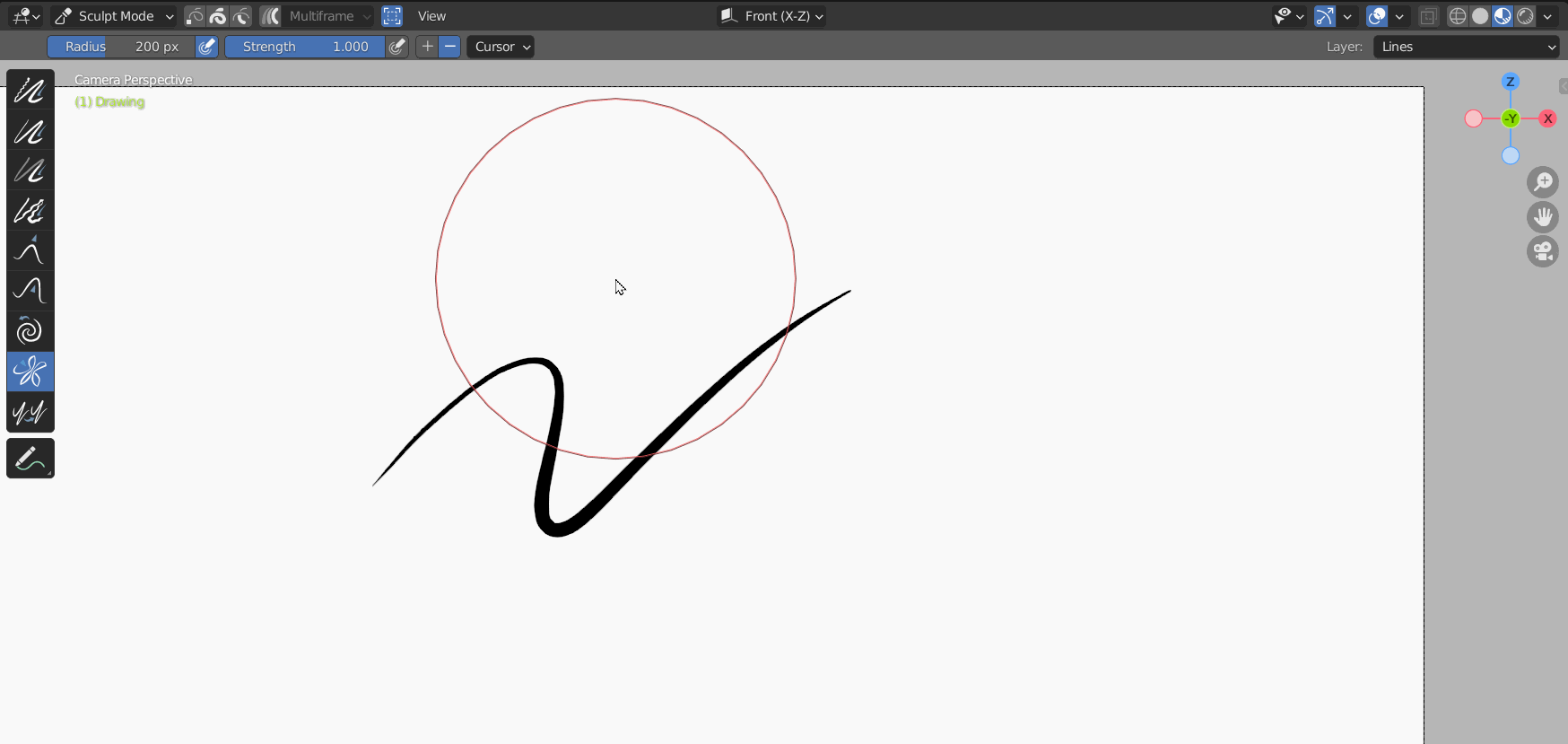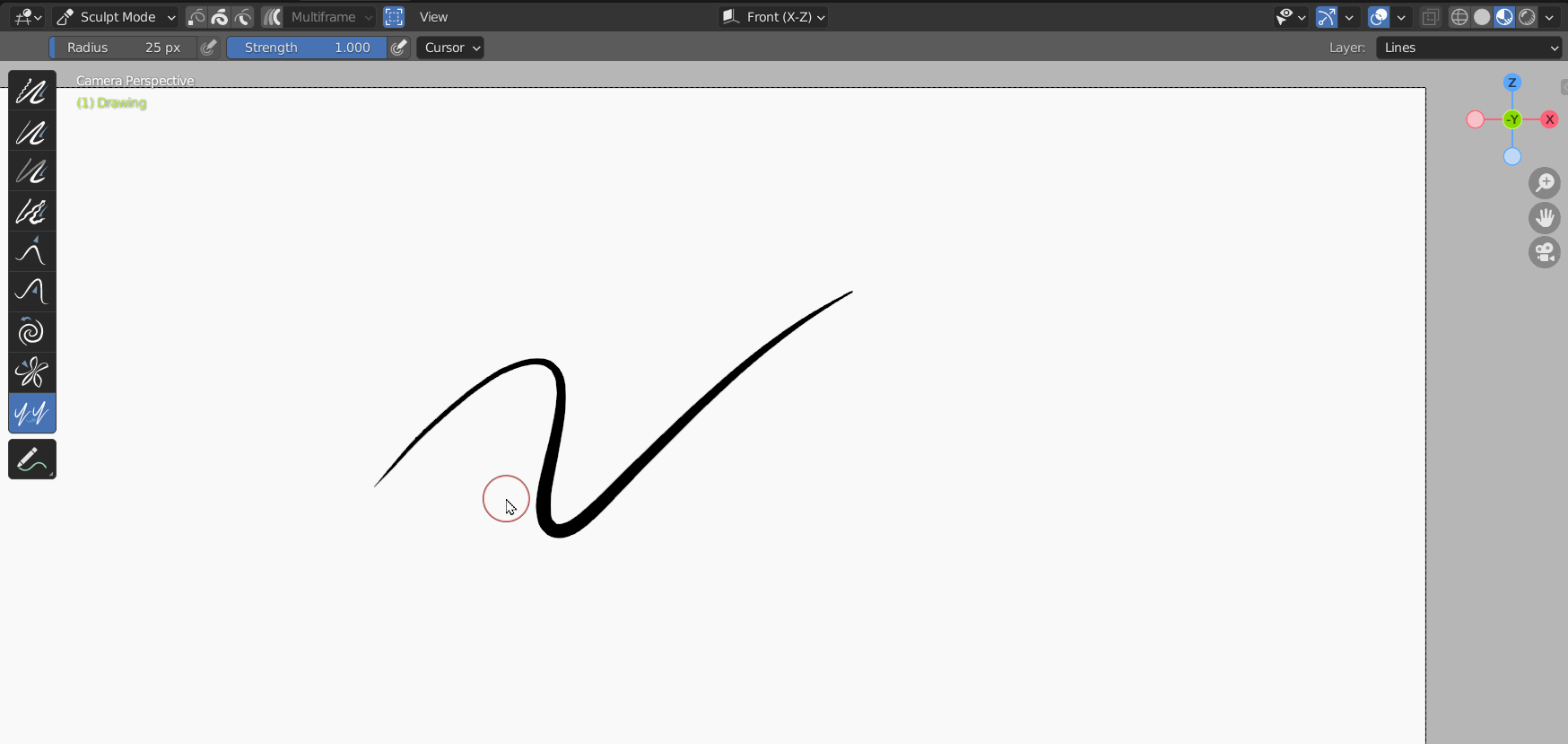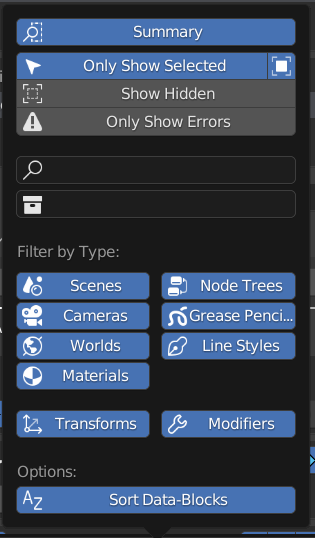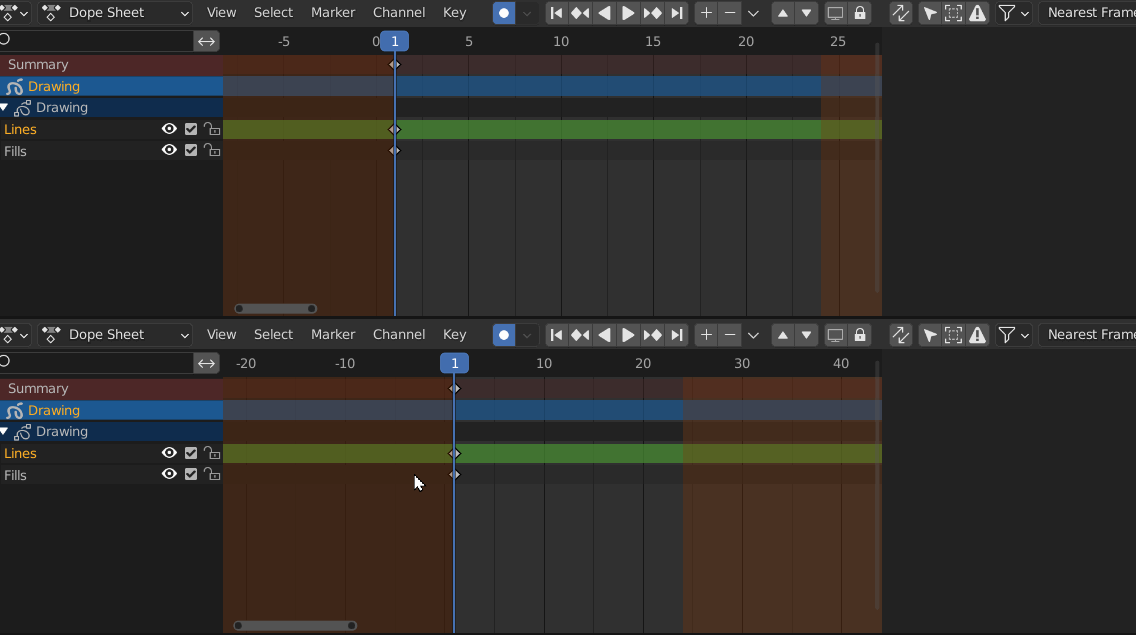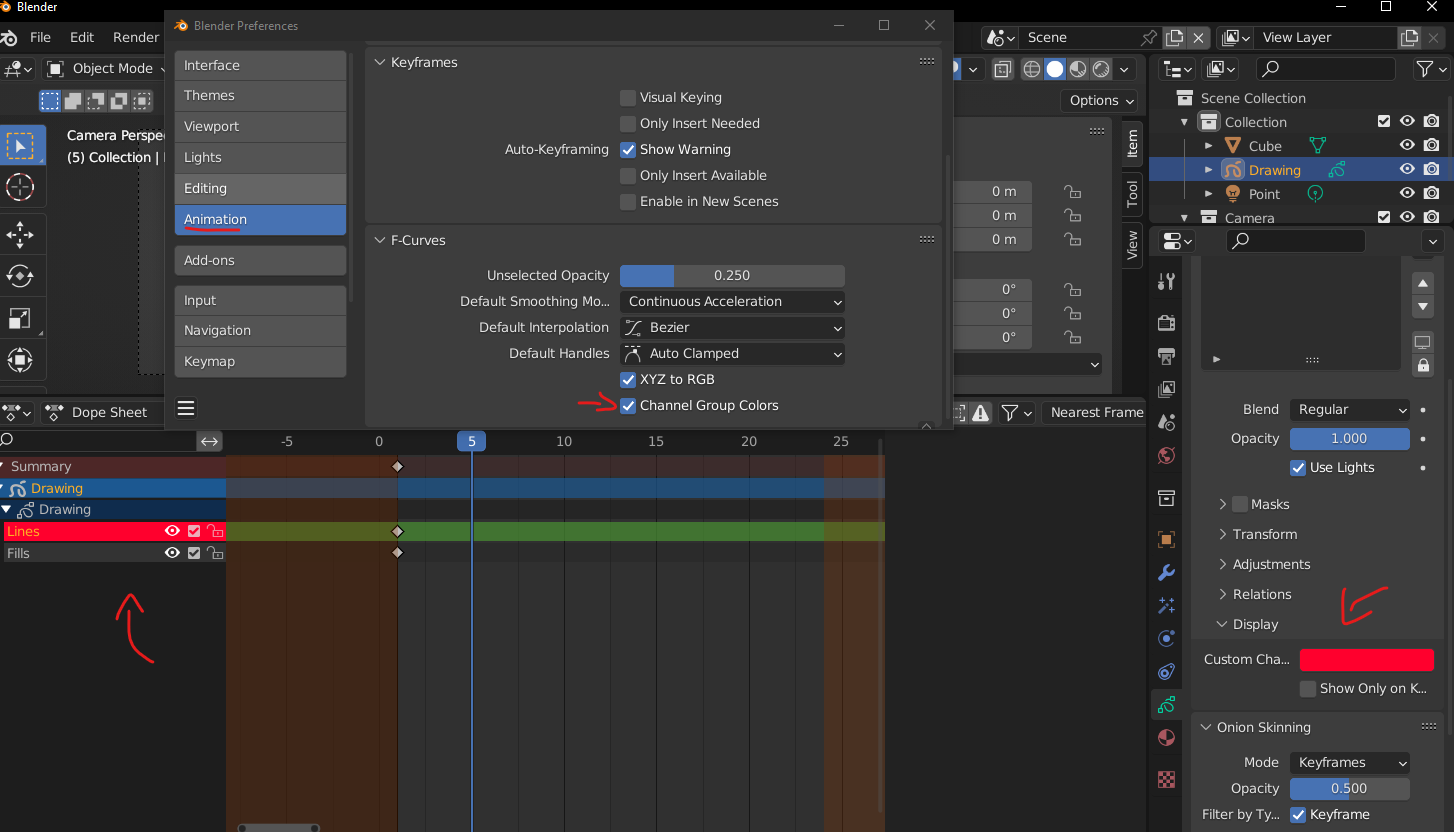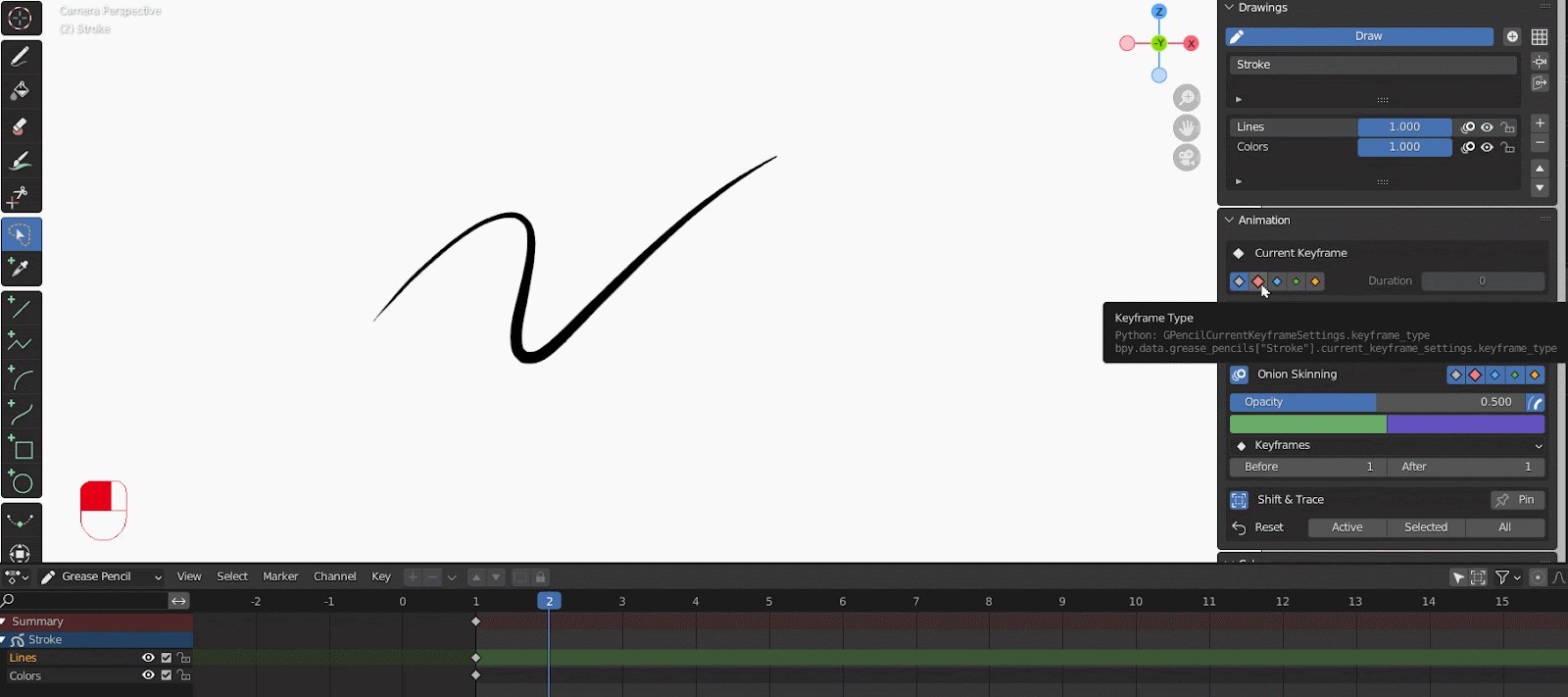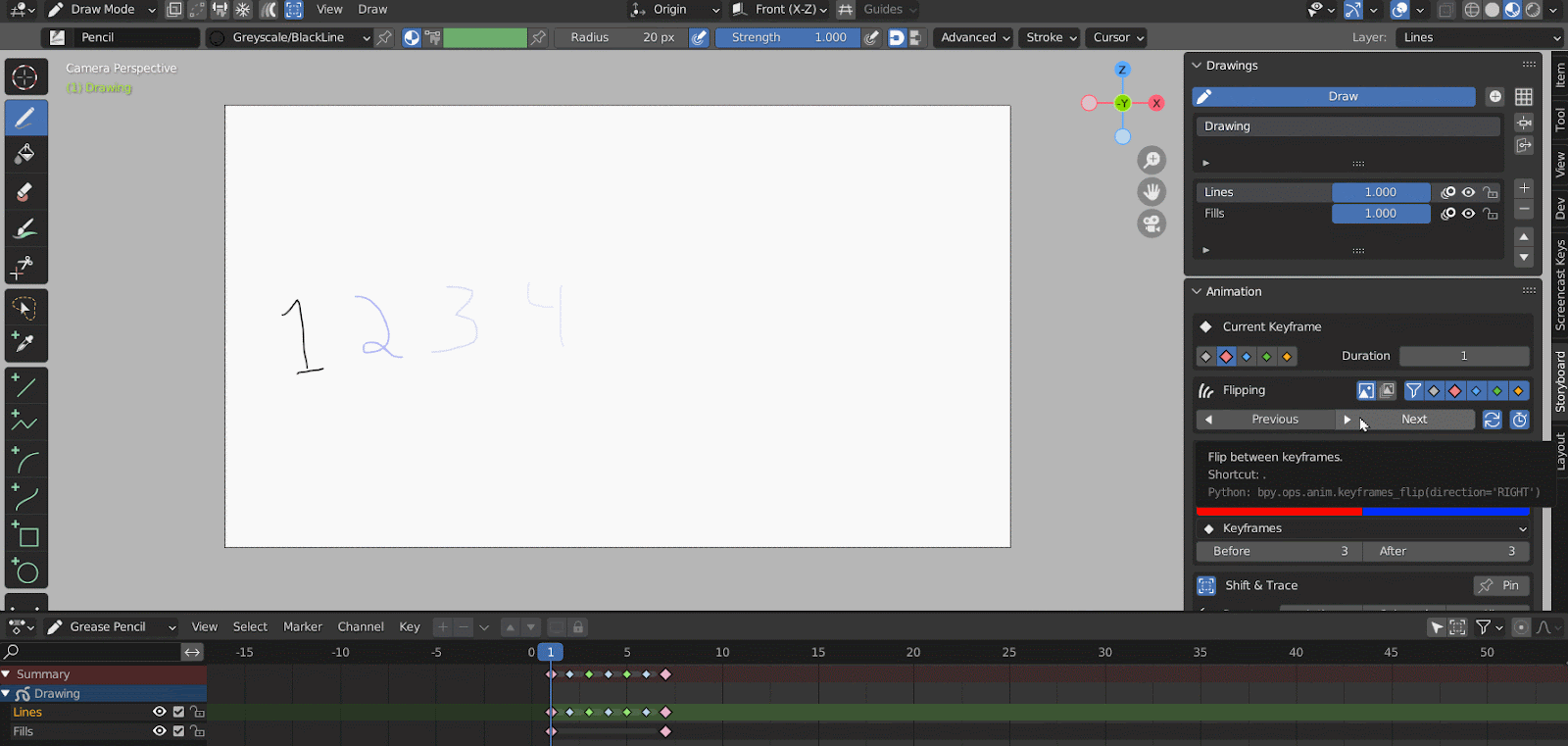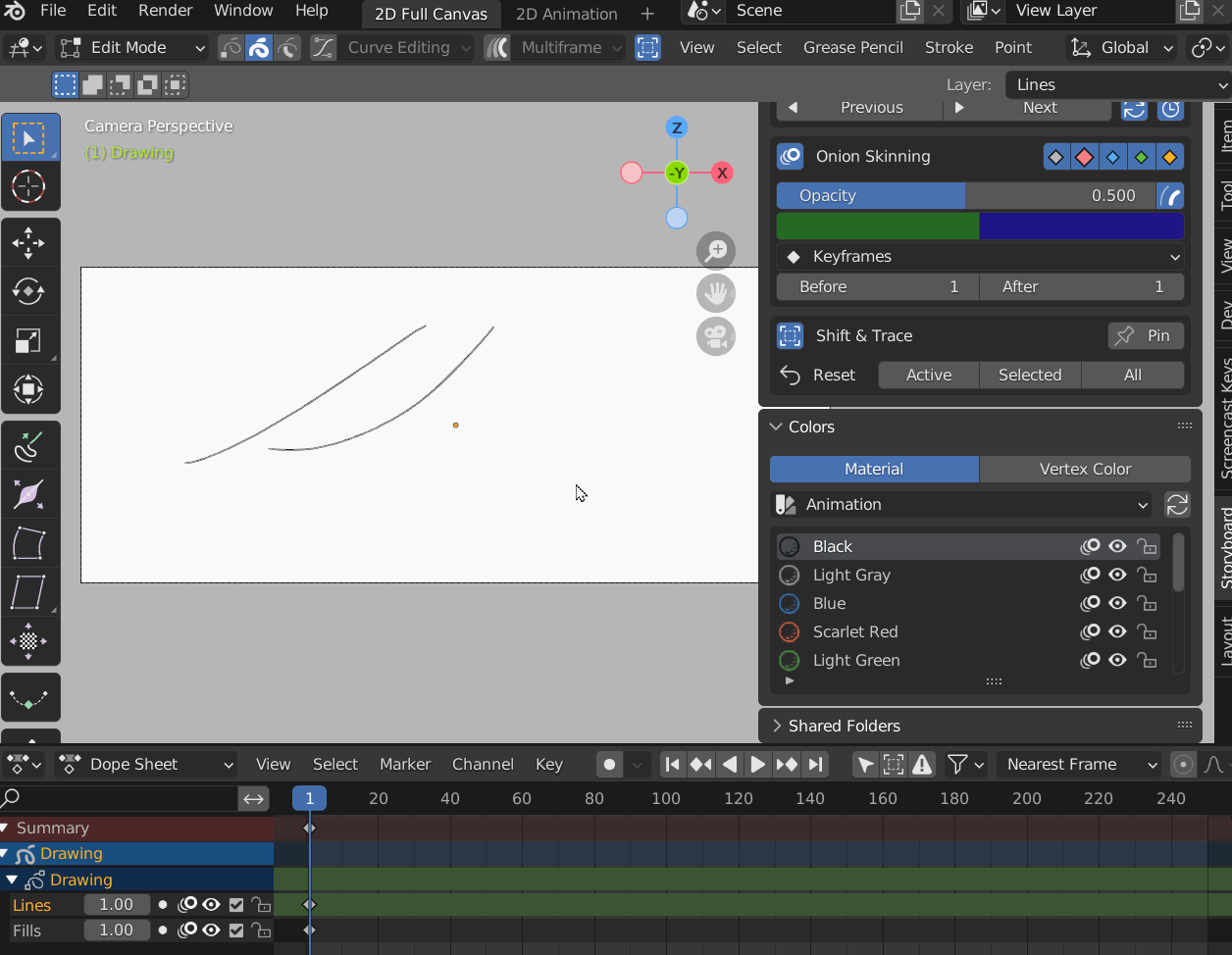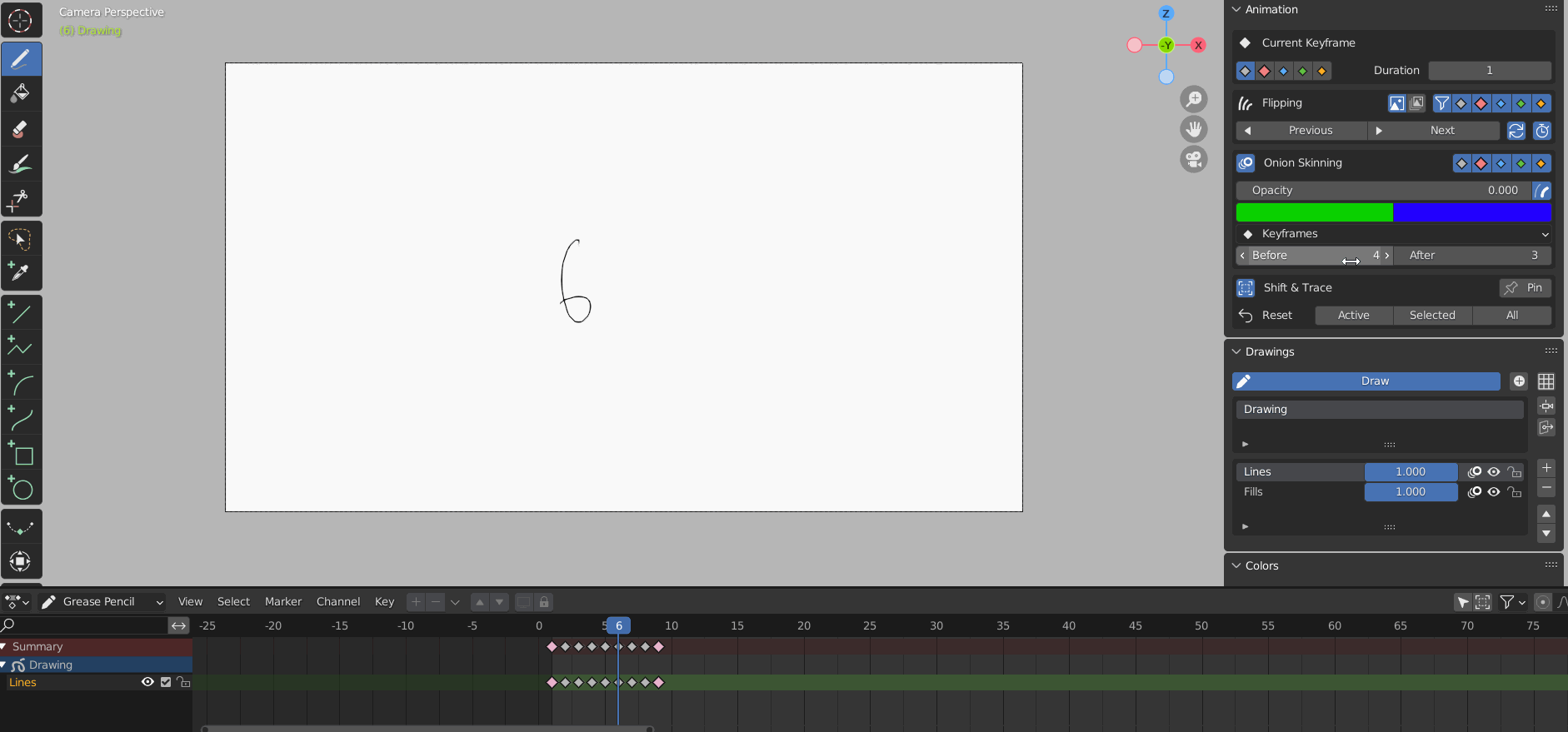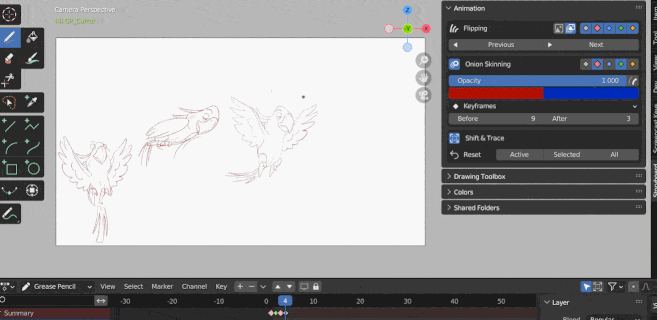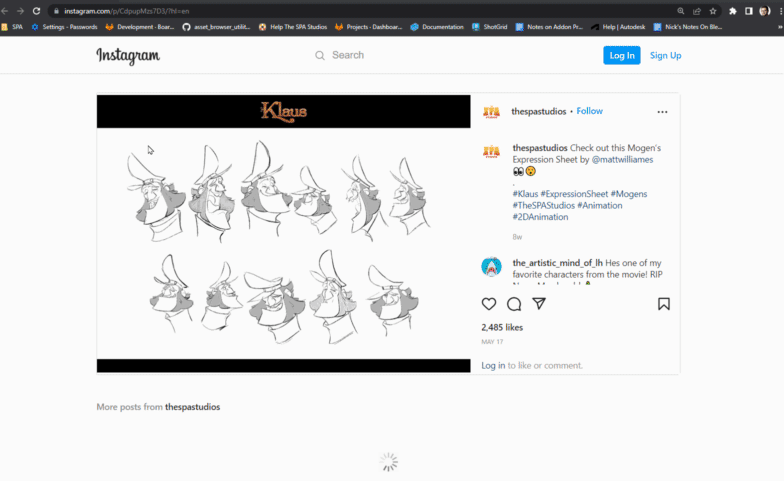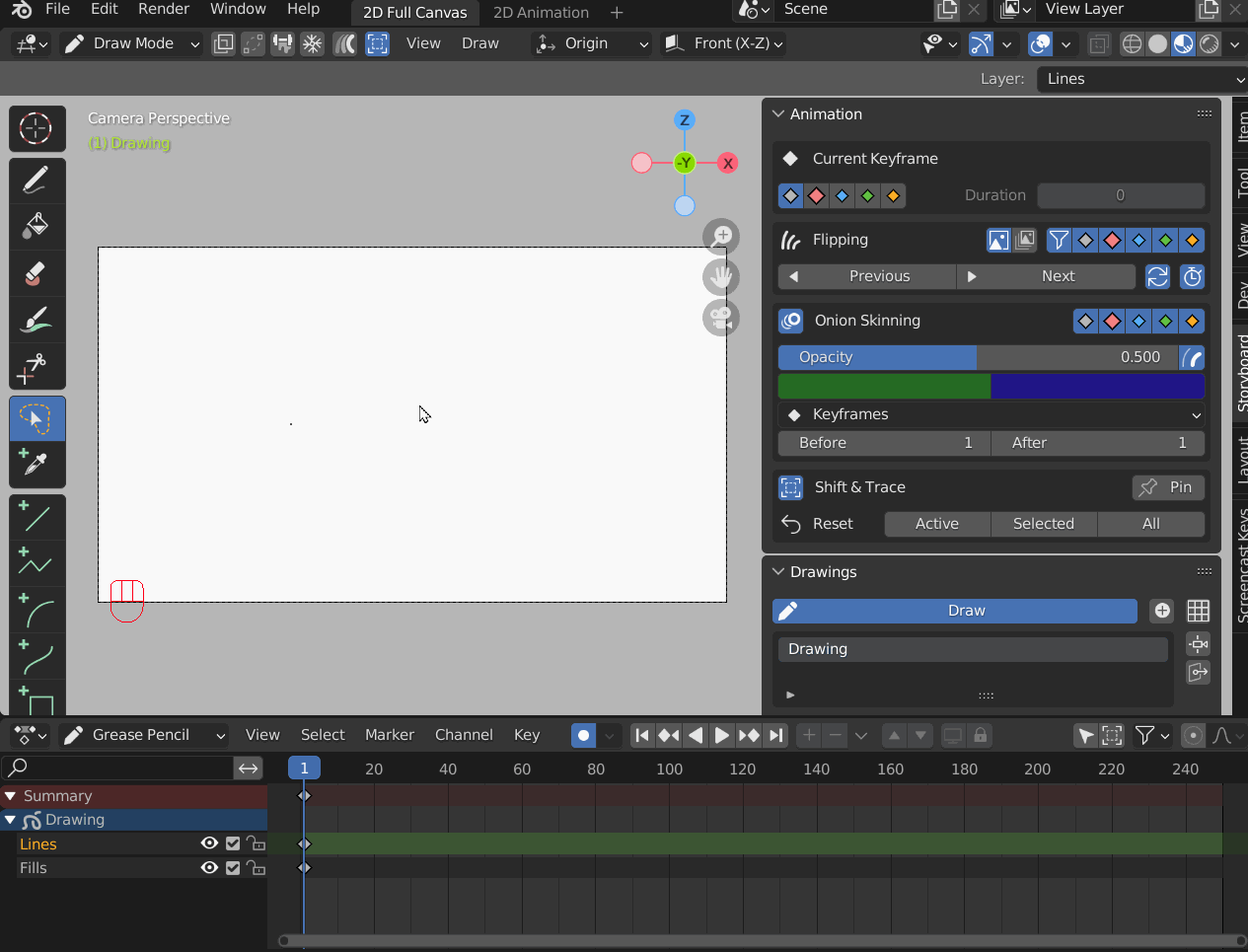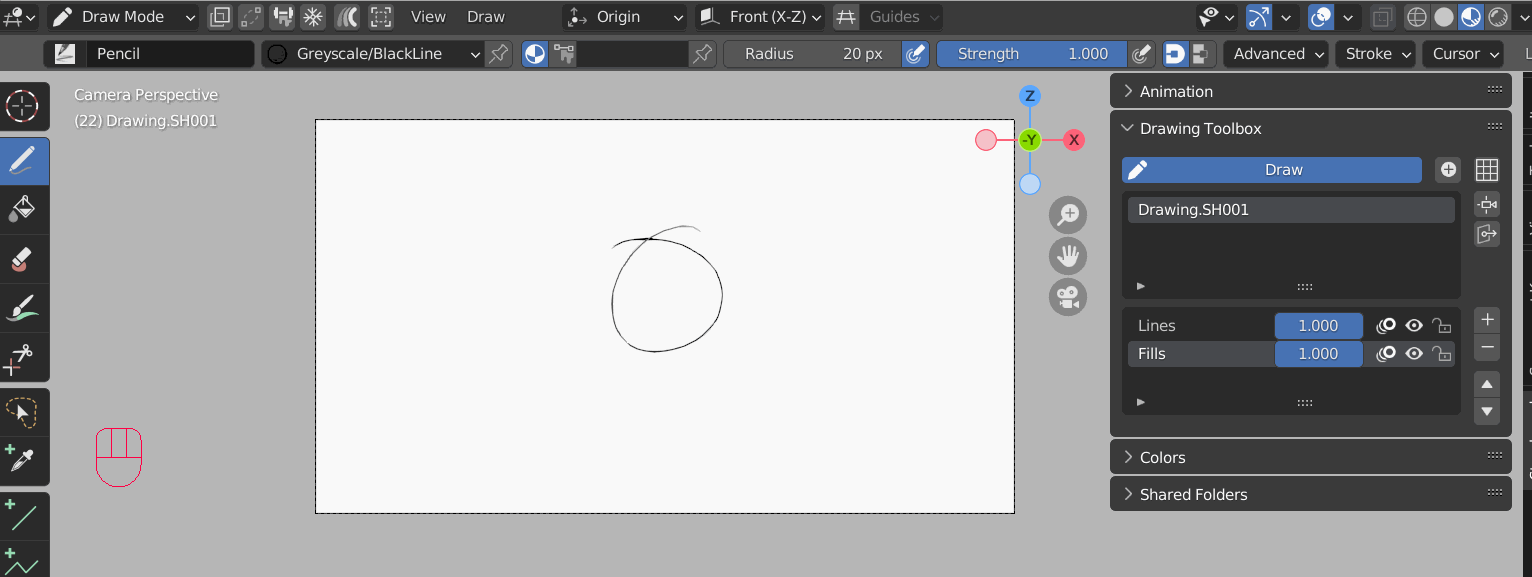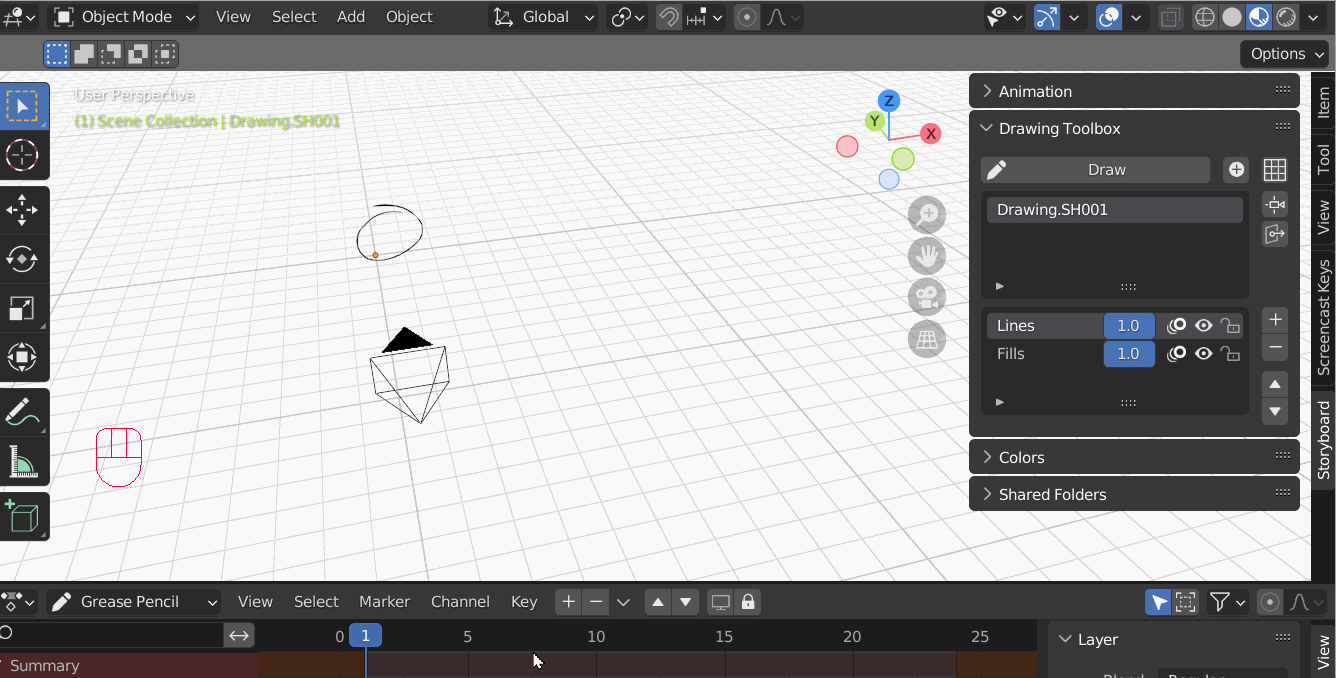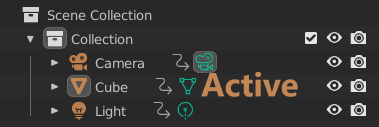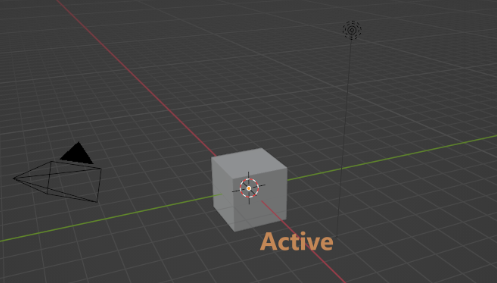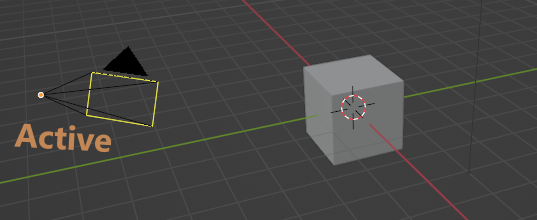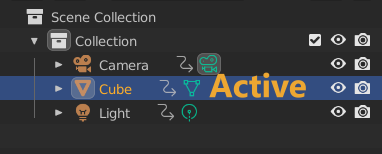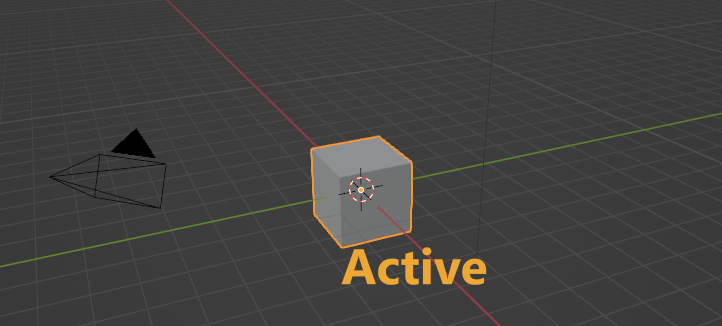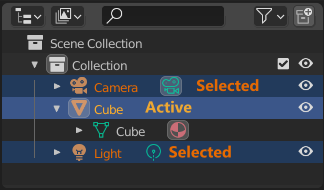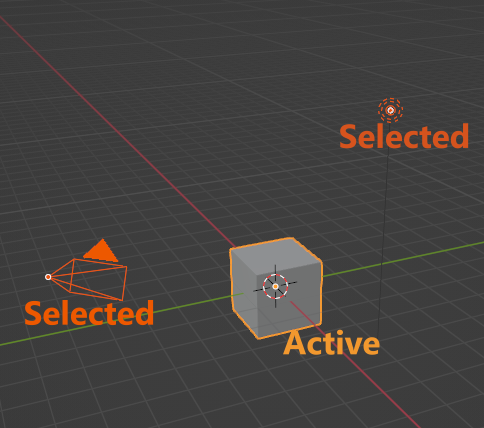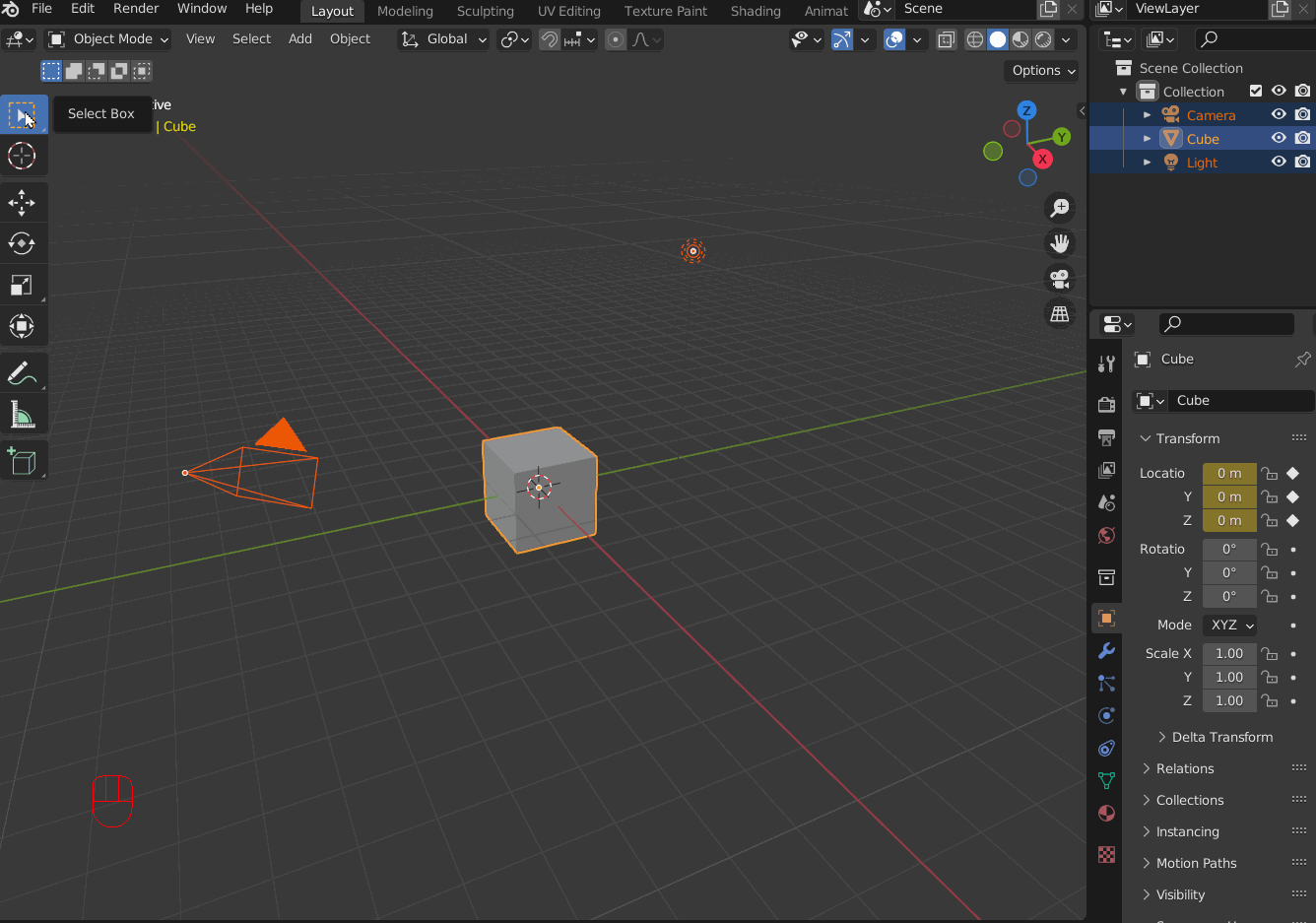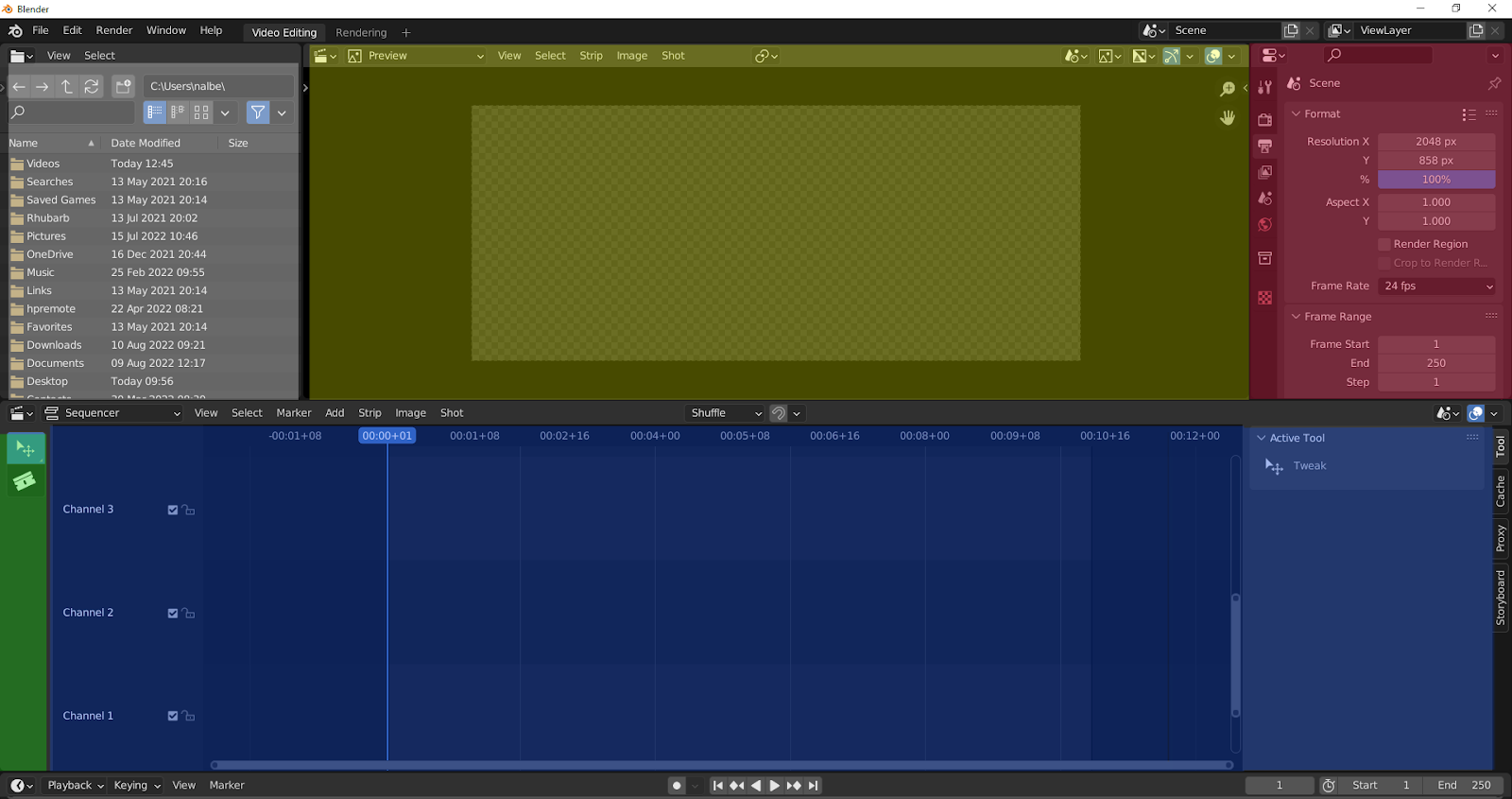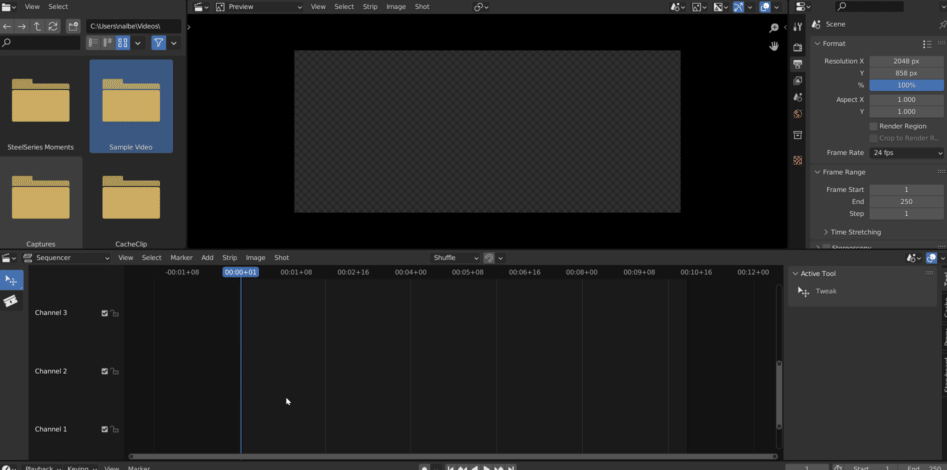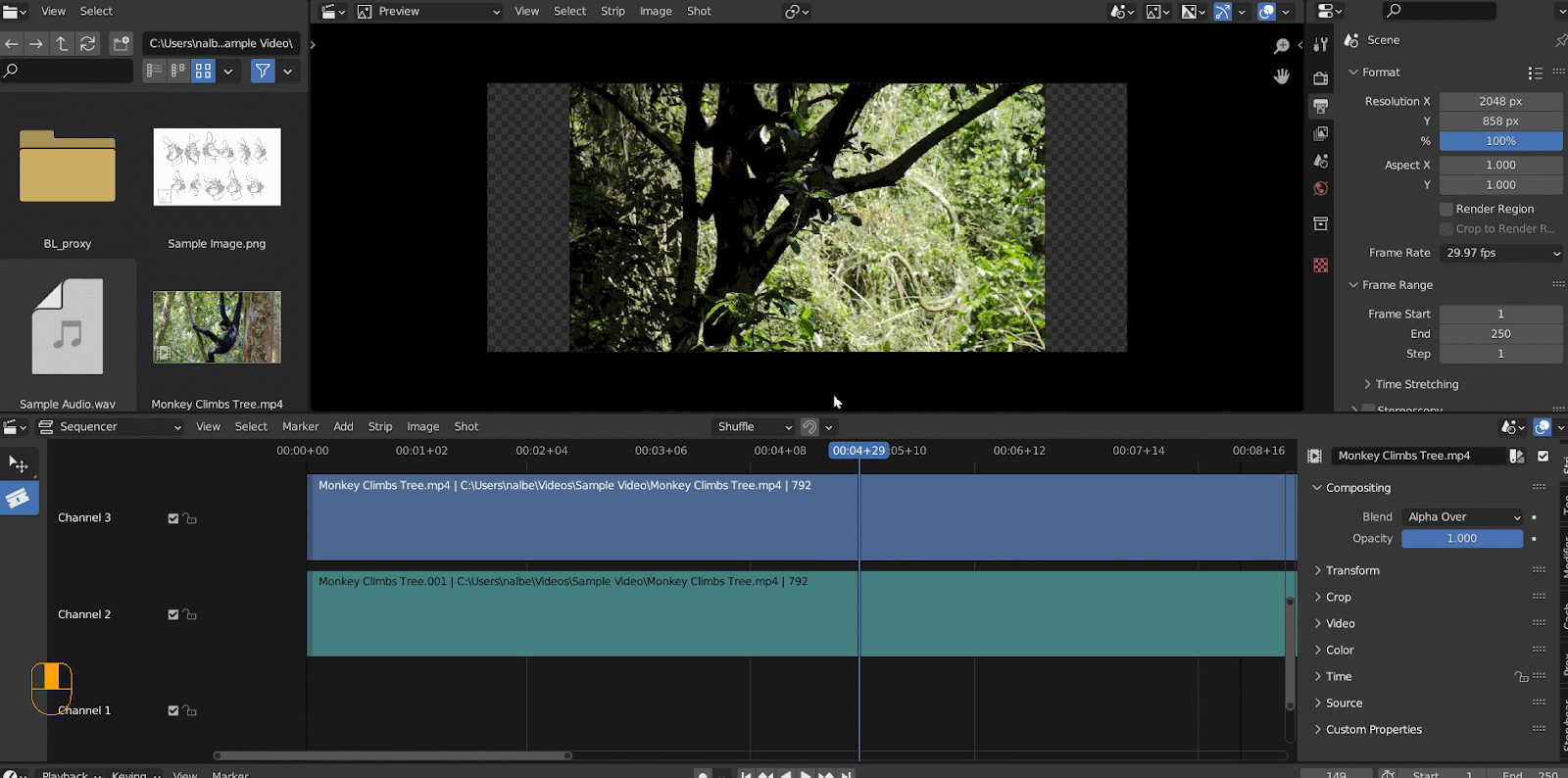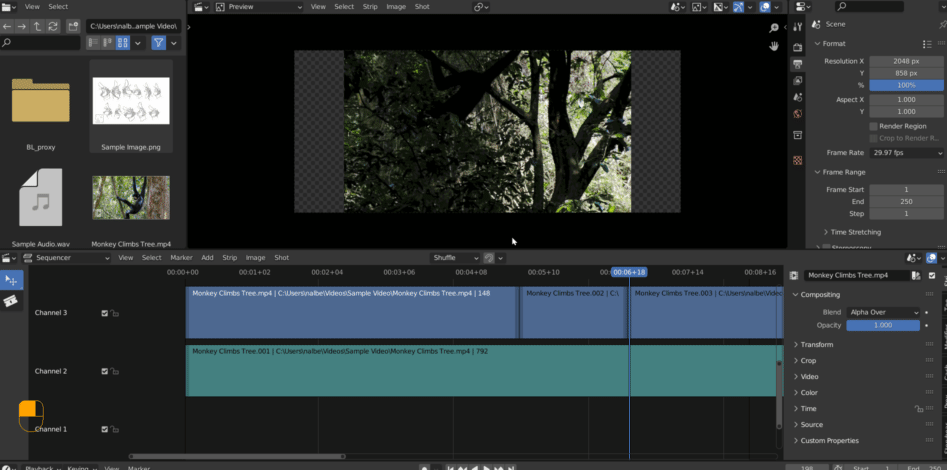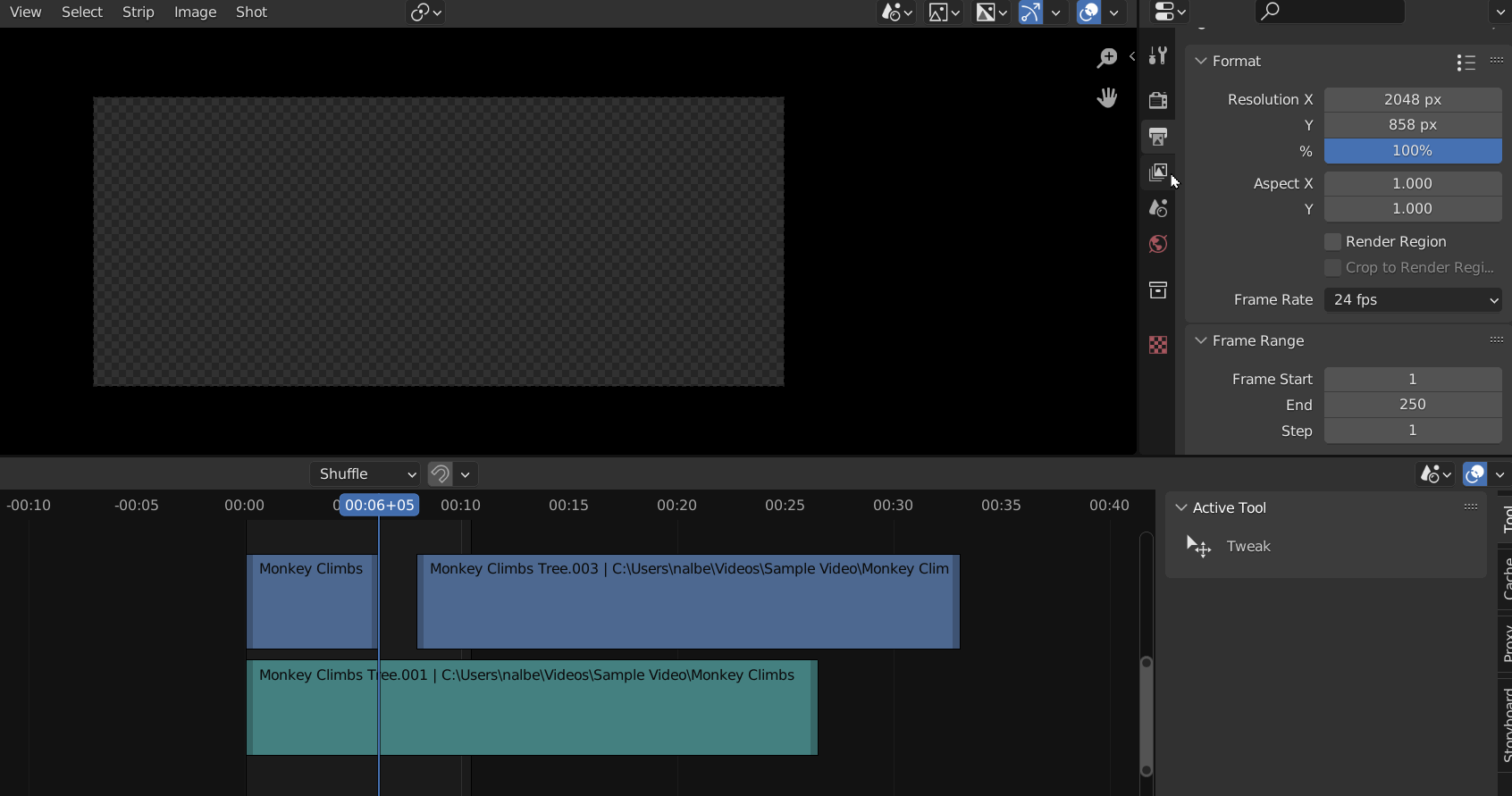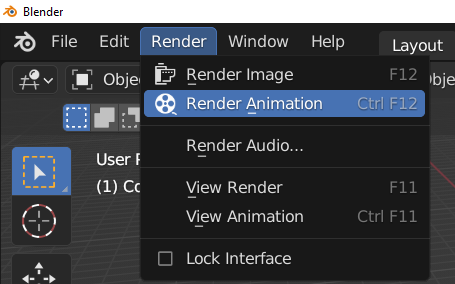Quick Start Guide
Introduction
Blender is a 3D program with a 2D package built-in. Some voices can be heard saying that Blender looks very complicated, but it is in fact a very streamlined and simple program even for 2D Animation. At least we are working at making it so.
At SPA we are developing our own studio-specific Blender with a set of UI changes and tools to ease newcomers to it and continue refining its capabilities based on your direct production feedback. This document aims to give you the basic knowledge to quickly start Animating with the SPA version of Blender.
Let's get started.
Install and launch Blender SPA
TODO: Write launch instructions for the outside world.
Open SPA 2D Animation Template
The first time you launch Blender you will be see the Blender Splash Screen. On the right is a list of recent files, on the left is templates to create a new file from. To get started in the SPA Animation experience select SPA 2D Animation template.
After launching the template you will see the default SPA Animation workspace. This workspace is opened on a drawing canvas in Draw Mode, you can now begin drawing your first keyframe.
Return to the Splash Screen
You can always re-open the Splash Screen by using the Blender Logo > Splash Screen in the top right corner of your Blender window. This will re-open the Splash Screen which usually appears when you first launch Blender.
Interface Basics
- Green: Toolbar This area contains tools like the Draw tool, Eraser tool and the Quick Edit tool.
- Yellow: Drawing Space This area is your canvas for drawing.
- Blue: Timeline/Dope Sheet The Dopesheet is where animation keyframes can be viewed/moved
- Red: Quick Access Panel The Quick Access panel is where you will find shortcuts for most Animation work
Navigation
Middle Mouse Action will in the future be set by default for artists launching Blender, temporarily please follow the below procedure to ensure you have the correct navigation settings.
Set your Middle-Mouse Preference right!
By default the Middle Mouse Button in Blender will Orbit around your object in 3D Space, which is not desirable for 2D artists.
Before you start, Open Edit>Preferences find the Keymap section from the sidebar of the preferences window. And set Middle Mouse Action to Pan as the default (instead of Orbit).
Basic Navigation of your Canvas
To quickly navigate your scenes, Blender has some handy keyboard shortcuts. These come in the form of Zoom, Pan, and Rotate Canvas Shortcuts.
Also do not forget to press the ESC key if you get lost or performed an operation you are not sure about and want to get out of. Or press the camera icon to get back to default view
- Pan: Move your Pen/Mouse Left and Right or Up and Down while Holding Down the Middle Mouse Button to pan the Canvas
- Zoom: Move your Pen/Mouse Up and Down while Holding Down CTRL + Middle Mouse Button to zoom in/out
- Rotate Canvas: Move your Pen/Mouse and Hold Down SHIFT + CTRL + Middle Mouse Button,
- Use CTRL + SHIFT + R or the Blue Rest Icon in the lower center of your screen to reset your Rotated Canvas
- Mirror Canvas: SHIFT+ W to mirror canvas at the current views center. SHIFT+W again to reset.
Your first strokes
To begin drawing in Blender simply start drawing in the Drawing Space/Canvas area. Use the Dope Sheet to navigate to a new frame and use I on your keyboard to insert a keyframe.
Radius
The Radius of a Brush can be controlled in the Header menu. The use pressure button allows for tablet pressure inputs on the Radius. You can quickly adjust the Radius with “F” on the Keyboard. Under the Tools>Brush Settings>Radius menu a custom curve can be set for the strength for more precise control.
Strength
The Strength is how Dark the stroke is, this can also be controlled by pen pressure. To set the Strength, edit it in the header menu, under the tools panel or use the keyboard shortcut SHIFT+F. Under the panel Tools>Brush Settings>Strength menu a custom curve can be set for the strength for more precise control.
Changing Colors
In the Quick Access Panel under the header Colors is a menu to select different colors for your drawing. Simply select one of the preset colors and continue drawing in the newly selected color!
Erase a Stroke
To remove a stroke with the Eraser tool, select the Eraser from the Toolbar on the left. You can now erase strokes, use the Strength to adjust how effective your Eraser is. Select the Stroke option to quickly erase entire strokes.
Edit a Stroke
To Edit a stroke, find the Quick Select tool on the left Toolbar area. Using the Quick Edit tool users can manipulate strokes. This transform box works similar to transform boxes in other 2D Animation software.
To learn more see Quick Edit Tool doc.
Enable SPA Theme
Dopesheet now has an updated look over vanilla blender to make it easier to read. You must have the SPA Theme enabled to do this follow the Enable SPA Theme page.
- Navigate to Edit>Preferences
- Open the Theme tab
- Select the SPA theme from the Dropdown
Navigating Between Drawings
There are several ways to switch the active layer, it can be selected from the Drawing Box or the Dope Sheet area, as shown in Layer Management. To jump between layers and grease pencil objects in the viewport we have the shortcuts CTRL+SHIFT+CLICK and ALT+CLICK.
From the Viewport
- Enabled Fade Inactive Objects + Grease Pencils from the overlays menu
- Enabled Fade Inactive Layers from the overlays menu
- Users can adjust the Fade opacity of inactive objects (set to .5 by default)
- Hover your Mouse/Pen over the stroke of an inactive drawing
- Ctrl+Shift and Click to make inactive drawing active
- Alt + Click to make an inactive layer in the current drawing active
From the Dope Sheet
- Ensure you have Sync Selection
 enabled in the Dopesheet header.
enabled in the Dopesheet header. - Select different layers in the Dopesheet the active object will update.
Always show Active Drawing in Dope Sheet
In Blender there is a a concept between active and selected. This means it is possible to have a drawing being edit-able but not appear in the Dopesheet. To avoid this issue enable the option Always Show Active under the Dopesheet header.
- Ensure you are in Draw Mode.
- From the Dopesheet header select the
 icon.
icon. - Use the
 icon to enable Always show Active Object
icon to enable Always show Active Object
Further Reading
- Drawing Tools
- Animation Tools
- References
- Shift & Trace Box
- Import Image as Reference# Start Drawing
The basic tools needed to start drawing in Blender.
Brushes & Materials
Pens or Brushes in Blender can be selected only when in Draw Mode. Pens will always define the shape or style of the stroke and can also sometimes define material or color of the stroke. The same pen can be used with multiple materials/colors.
- Pens can be selected from the top left menu. (only when in draw mode)
-
Materials are defined in the Storyboarding Panel by Pallet
- Select a pallet under either Material or Vertex Color
- Vertex Colors can be defined manually, allowing for quick custom color changes and Palette definitions.
Layer Management
Each Grease Pencil Object contains its own set of layers. Layers in Blender work very similar to other 2D programs like Harmony. Layers can be ordered top to bottom to create a hagiarchy and easily hidden/locked.
-
 Hide Icon
Hide Icon Lock Icon
Lock Icon Onion Skinning
Onion Skinning Layer Opacity
Layer Opacity Add/Remove Active Layer
Add/Remove Active Layer Up/Down Active Layer
Up/Down Active Layer
Add New Drawing Objects
To begin drawing in Blender you will need a Grease Pencil Object. Blender manages different sets of drawings inside of this Grease Pencil Object. It contains all data related to drawings including colors and layers. The Grease Pencil Object represents a 2D plane that drawings exist on. This object can be transformed and rotated in 3D space depending on the complexity of your scene.
- Select the "plus" icon to create a new drawing object
-
A “New Drawing Object” dialogue will open
- Name: Enter name based on convention TBD
- Location: This gives options to control where the object is in 3D space
- View Offset: Will place object in 3D relative to the camera’s position
- 3D Cursor: Will place object in 3D at a fixed point via 3D Cursor
- View Offset: Set distance of object relative the camera’s position
- The “Pin to Camera” button See Pinning Drawings…
- Orient Axis: Restrict orientation to the select axis.
- The newly created object will appear in the object list
Switching Between Drawings & Layers
We can use the shortcut Ctrl+Shift+Click to jump between objects while selecting them directly in the Viewport or while selecting the object in the list of Objects in the Drawings Panel. This feature, in combination with the setting to Fade in Active Objects allows us to now clearly differentiate which object is active and which is inactive and to what level, and jump between them easily.
- Ensure you are in Draw Mode
- Ensure you have Sync Selection
 enabled in the dopesheet header.
enabled in the dopesheet header. - Enabled Fade Inactive Objects + Grease Pencils from the overlays menu
- Enabled Fade Inactive Layers from the overlays menu
- Users can adjust the Fade opacity of inactive objects (set to .5 by default)
- Hover your Mouse/Pen over the stroke of an inactive drawing
- Ctrl+Shift and Click to make inactive drawing active
- Alt + Click to make an inactive layer in the current drawing active
- Notice the Drawing Panel updates which drawing is updated
Working with Palettes
Importing Existing Palette
Palettes are predefined groups of materials.
SPA provides a couple of palettes by default and some of these are provided in the Animation and Layout template files.
Create a new Palette
Palettes are based on existing Grease Pencil Objects. Palette's are defined by materials with a prefix in their name.
To create a new Palette we simply add a new material with a new prefix. Using a / to separate the palette from the material's name. The palette items are saved inside your Grease Pencil Object!
For example: <span style="font-weight: 400;">MyPalette/Color</span>
- Open the Material's Tab with a Grease Pencil Active
- Use the + Button to Add a new Material
- Rename your material with palette title
MyPaletteas a prefix followed by/ - Name your new material now, and set its color
- Refresh your palettes to see your new palette in the side panel.
Mirror the Viewport
Mirroring the Viewport can be done either from the Storyboard side panel or a keyboard shortcut
- Move your viewport to the item to be mirrored
- From the Side Panel select the
 icon]
icon] - Or use keyboard shortcut SHIFT+ W
**Notice:** When viewport is mirrored, the butterfly icon will turn red: [](./images/gallery/2022-09/image-1664540679660.png) and the top left will read **Camera Perspective** **(Mirrored)** if text info is enabled in the overlays menu.
Enable SPA Theme
SPA has a special theme to make it easier to read the Dopesheet. To enable the SPA theme follow these instructions.
- Navigate to Edit>Preferences
- Open the Theme tab
- Select the SPA theme from the Dropdown
What's new in the SPA Theme
Dopesheet now has an updated look over vanilla blender to make it easier to read.
- Active Object has a Light Blue Highlight on it's row
- Active Layer has a Light Green Highlight
- Inactive Object has a Dark Blue Highlight
- Inactive Layer has a Dark Green Highlight
Edit Drawings
How to edit your drawings, and navigate between different layers.
Quick Edit Tool
Similar to the selection tool in Harmony. The Quick Edit tool allows you to quickly select and transform any stroke within the Grease Pencil Object. It can be selected from the left Toolbar.
Selection & Move
Use the tool select and move a stroke in a Grease Pencil Object. Keyboard shortcuts allow for a more precise movement. The mouse cursor will display a hand icon when move is available.
- Use the Quick Edit tool to lasso a selection
- Click and Drag with Mouse/Pen on the transform box to move
- CTRL+ARROW KEY moves 1px
- CTRL+SHIFT+ARROW KEY moves 5px
- SHIFT+ Selection will add to the section
- CTRL + Selection will subtract from the selection
- Select blank canvas to deselect
Select/Deselect All
All strokes on the current frame can be selected and deselected with A or Alt+A
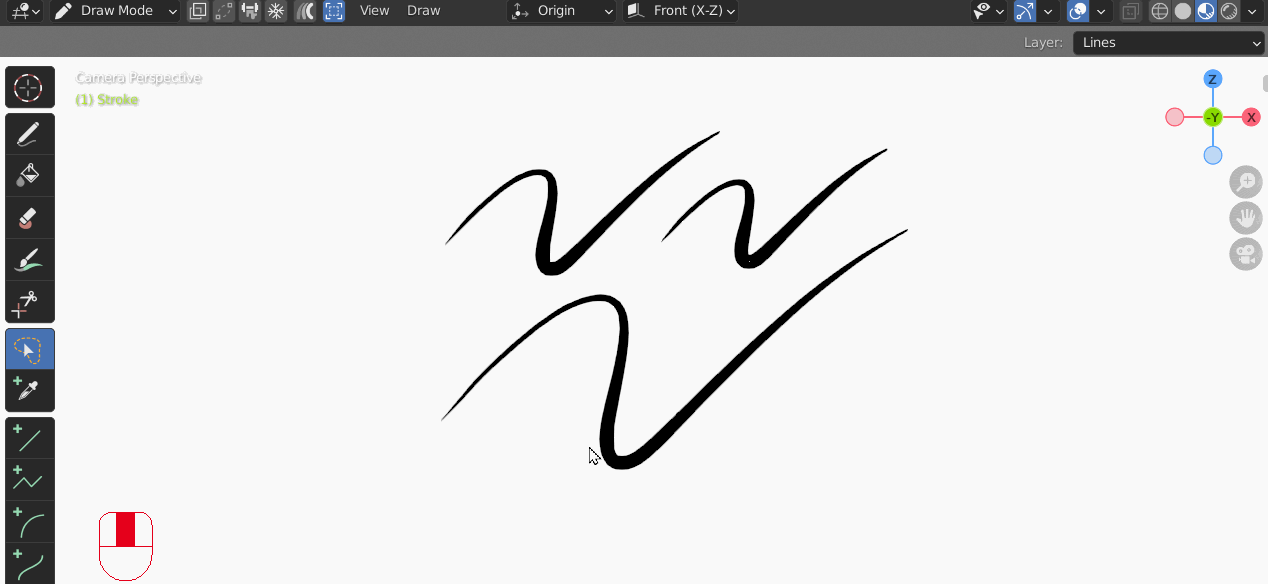
- Use ‘A’ while Quick Edit tool is enabled to select all strokes on the current frame
- Use ‘ALT + A’ while Quick Edit tool is enabled to deselect all strokes on the current frame
Scaling
Scale any selection either freely or while maintaining proportions. Scaling can also be done around the Pivot Point. Scaling is enabled when hovering over any point on the transform box. The mouse cursor will display a four way arrow when scaling is available.
- Select a drawing and select any point to Scale
- Hold SHIFT to Proportionally Scale
- Hold ALT to Scale around the opposite corner
- Hold SHIFT+ALT to Scale Proportionally around the opposite corner
Rotate and adjust Pivot Point
Rotate your selection from any corner. Adjust the pivot point for more advanced rotations. Rotation mode is available when the Mouse Cursor is in a + shape.
- Select Drawing and drag near any corner to rotate.
- Adjust pivot point to affect the rotation’s origin.
Skewing
Skewing a drawing can be done from any side. Skewing mode is enabled when hovering along the length of the transform box. The mouse cursor will display a bidirectional arrow along the skew axis when available.
- Hover mouse/pen over transform box line
- Click and drag to skew
- Hold ALT to skew about the pivot point
Copy & Paste
Strokes can quickly be selected for copying to another frame or for duplication using the selection tool.
- Make a selection
- Use Ctrl + C to copy
- Use Ctrl + V to paste
Duplication
- Make a selection
- Use SHIFT + D to duplicate
- Move the duplication with either the mouse or keyboard shortcuts
- Use X to move duplication horizontally
- Use Z to move duplication vertically
Delete
Strokes can quickly be deleted either an entire drawing or a portion of the drawing selected.
- Draw a selection
- Hit "X" to delete.
Move Selection to Layer
Strokes can quickly move to another layer using ‘M’ on your keyboard.
- Draw a selection
- Hit "M” to Move to Layer
-
Select a destination layer
Flip Strokes
- Draw a selection
- Use the Flip buttons in the Top Left header to mirror X/Y
- Mirror works on the current keyframe and can be animated across keyframes
Select Layer from Viewport
Select Layer from Viewport is a shortcut to quickly change the active layer while drawing.
Select a layer by Alt clicking a stroke in your viewport. Ensure you have “fade inactive layers” enabled, this will visualize the change in active layer. ALT+LEFT CLICK over drawings to switch to that drawing’s layer. The newly active layer will now be highlighted in the Drawings toolbox.
- Under Viewport Overlays
 ensure Fade Layers is enabled.
ensure Fade Layers is enabled. - ALT + LEFT CLICK over a stroke to make it’s layer active
Rotating the Canvas in 2D
To rotate the current view use the Rotate Canvas shortcut. Can be used anywhere in the viewport.
- From either Camera or 3D View
- Keyboard Shortcut SHIFT+CTRL+MIDDLE MOUSE BUTTON
- The Blue gizmo will help orient your rotation. At the button an reset icon will appear to show rotation is being used.
- Use the
 icon to reset the view. Or use shortcut SHIFT+CTRL+R
icon to reset the view. Or use shortcut SHIFT+CTRL+R
Pegbars
Pegbars are for offsetting, rotating and scaling individual Grease Pencil Layers. Pegbars are for only transforming layers inside 2D space. The peg bar system will always aligned with a Grease Pencil Object's drawing plane.
Add Pegbar to Grease Pencil Object
- To create Pegbars select “Create Pegbar” in the Side Panel
- A new Pegbar will be created at the center view
Parent Peg to Layer
- To parent a peg to a layer select the layer in the Drawings Box
- Then under Peg: select the Peg that will be the parent of this layer
Transform Pegs
- To transform a peg firstly ensure that the desired peg is active in the Pegbars Box
- From the Toolbar on the left select the BLANK icon under the Shift and Trace icon
- A green transform gizmo will appear, used to Scale and Rotate the peg
Keyframe Peg Transforms
- Transform a peg to begin the keyframe process
- Use the
 button to insert new keyframes
button to insert new keyframes - Keyframes will appear in the Dopesheet under Pegbar
Mute Peg Action
Hide Peg UI from Viewport
Add / Remove Pegs
Pegs are always created at the object origin. Peg display location cannot be offset yet.
- Double Click any Peg’s name in the Pegbars Menu to rename it
- Use the PLUS icon to add Pegs and the MINUS icon to remove Pegs
- Removing a peg will reset the associated layer back to it’s original position
Reset Peg Transformation
- To reset Transformation of a peg ensure the Peg is active in the Pegbars menu
- Select RESET Transformation in the Top Left of the Window.
Parenting Pegs
- Create a new Peg name it "Parent Peg"
- Select the Layer Peg that will be it's Child and set the Parent: option to the Parent Peg.
- Transform the Parent Peg (remember use the keyframe button)
- The the Layer Peg is now the child of the Parent Peg and will inherit all transformations.
Sculpt Mode
Sculpt Mode in Blender is a way to manipulate strokes after they are already drawn. Sculpt mode can be used to tweak existing drawings, and clone/tweak similar strokes quickly. Sculpt Mode uses many brushes each with a unique characteristics like; Push, Pinch, Twist and more!
To Enter Sculpt Mode you must have a Grease Pencil Object active. From the top left of your viewport select Sculpt Mode.
- Navigate to VIEWPORT header find the Mode menu
- Select Sculpt Mode
Hiding Edit Line Overlays
In Blender each mode has an overlays menu. You can find the overlays menu by looking for the  symbol.
symbol.
- Navigate to Overlays Menu
- Disable Edit Lines
- Use the Vertex Opacity to fade the edit lines
Using Sculpt Mode
Sculpt Mode allows for manipulation of Drawing Strokes after they are drawn. Sculpt mode includes brushes to apply tweaks by painting over strokes.
**TIP:** Hold down the CTRL key to invert any brush instead of selecting the +/- buttons from the header menu.
Smooth
Eliminates irregularities in the area of the drawing within the brush’s influence by smoothing the positions of the points.
Thickness
Increase or decrease the points thickness in the area of the drawing within the brush’s influence.
Strength
Increase or decrease the points transparency (alpha) in the area of the drawing within the brush’s influence.
Grab
Grab selects a group of points on mouse-down, and pulls them to follow the mouse. The effect is similar to moving a group of points in Edit Mode with Proportional Editing enabled.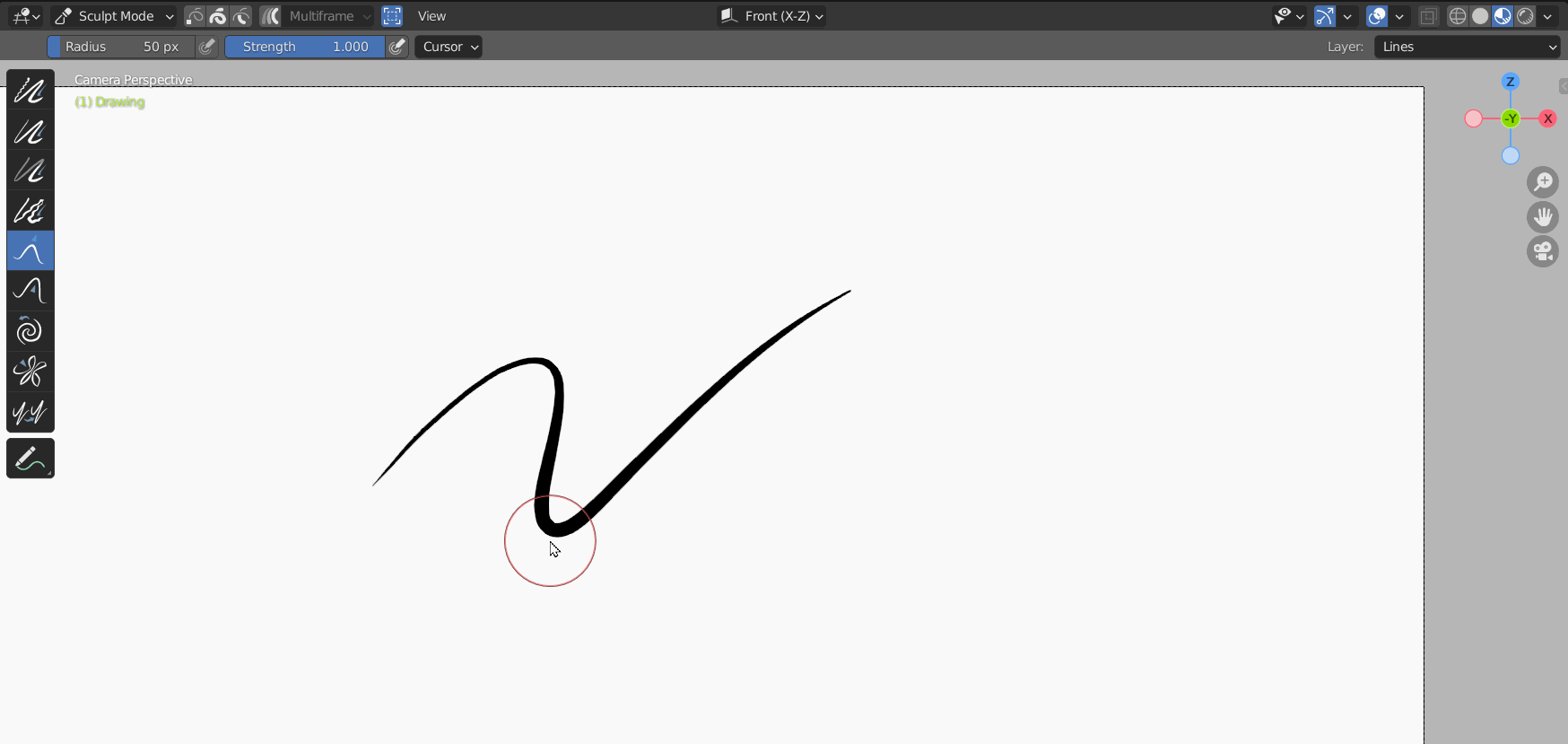
Push
Moves points in the direction of the brush stroke.
Twist
Twist the points in counter-clockwise (CCW) or Clockwise (CW) rotation.
Pinch
Pulls points towards the center of the brush. The inverse setting is Inflate, in which points are pushed away from the center of the brush.
Clone
Adds copies of the strokes in the clipboard in the center of the brush. You have to copy the selected strokes you want into the clipboard with Ctrl-C before using the tool.
For More Info on Sculpt Mode see Blender Doc
Animate Drawings
Tools to control keyframes for animation and to organize keyframes for Flipping/Onion Skinning,
Understanding the Dope Sheet
Differences in Dope Sheet Views
There are several different types of Dope Sheets that can be displayed in Blender. For the purposes of 2D Animation we want to focus on Dope Sheet, Action Editor & Grease Pencil.
- Action Editor: The action editor is limited to the current active object's animation data. It cannot show multiple objects, it cannot show Grease Pencil data.
- Grease Pencil: The Grease Pencil view only shows keyframes for grease pencil objects, can be multiple objects. It cannot show any Object animation data.
- Dope Sheet: The Dope Sheet can show all Object animation data, and grease pencil data, and from many objects not just the active one.
Sync Layer Selection in the Dope Sheet
Layer selection from the Drawing Box in the 3D Viewport can be synchronized with the current layer that is active in the Dope Sheet.
- Ensure you have Sync Selection
 enabled in the Dopesheet header.
enabled in the Dopesheet header. - Select different layers in the Dopesheet the active object will update.
Setting Filters in the Dope Sheet
The Dope Sheet can be customized to show different views on different classes of objects. For example it can show everything but the Camera, or show hidden keyframes or not.
To use Dope Sheet filters ensure you are in the Dope Sheet View.
- Summary: Is the header at the Top of the DopeSheet
- Only Show Selected: Will only Show the Selected Object
- Always Show Active: Will always Show the Active Object in Dopesheet
- Show Hidden: Will show objects or data that was hidden
- Only Show Errors: Show animation data that has lost it's object
- Filter by Type: Enable or Disable different types of objects in the Dope Sheet, (can be useful to only Show Grease Pencils Objects)
- Sort Data-Blocks: When disabled the order of the Timeline will match the Order of your Outliner
Sync Visible Range
When this setting is enabled, it will ensure that all regions share the same Zoom/Scroll levels. Please note that the Sync Visible Range setting must be enabled per timeline region. See below on where to find it.
- Open multiple Dope Sheet regions
- From each Dope Sheet's header select View>Sync Visible Range
- UI should now be synchronized across these Dopesheet
Enable Channel Colors
Blender allows users to organize channels using colors. To get started you must enable a setting in your user preferences.
- Go to Edit>Preferences
- Switch to the Animation tab
- Enable Channel Group Colors
- Under your drawings Object Data Properties tab
- Navigate to Layers>Display>Custom Channel Color
- Changes to this color will be reflected in the Dope Sheet for that layer
Dope Sheet Overlays
Dopesheet now has an updated look over vanilla blender to make it easier to read. You must have the SPA Theme enabled to do this follow the Enable SPA Theme page.
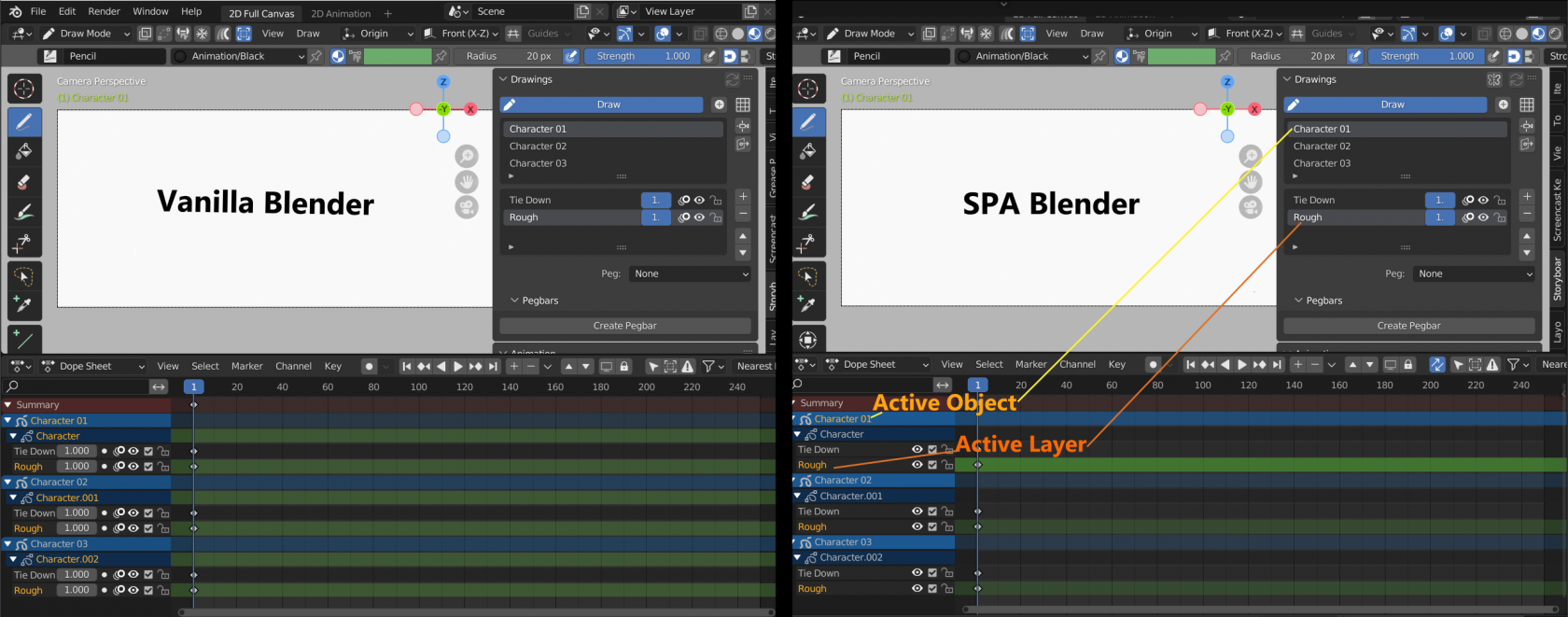
- Active Object has a Light Blue Highlight on it's row
- Active Layer has a Light Green Highlight
- Inactive Object has a Dark Blue Highlight
- Inactive Layer has a Dark Green Highlight
Keyframing Drawings
Keyframes are useful for controlling the timing. Keyframes can be placed automatically or manually. Using Keyframes in Draw Mode will allow for the creation of new frames. Using Keyframes in Object Mode will allow for the animation of objects including the camera. This can be used to for example animate a camera in a Master Layout which is often used in combination with Pinning Drawings to Camera.
Manually
- Ensure at least one Grease Pencil Object is active.
- Use the Arrow Keys to navigate the Grease Pencil Dopesheet to the desired frame
- Use “I” on Keyboard or select Grease Pencil > Animation from the Header menu. (Object>Animation to animate Camera/Objects)
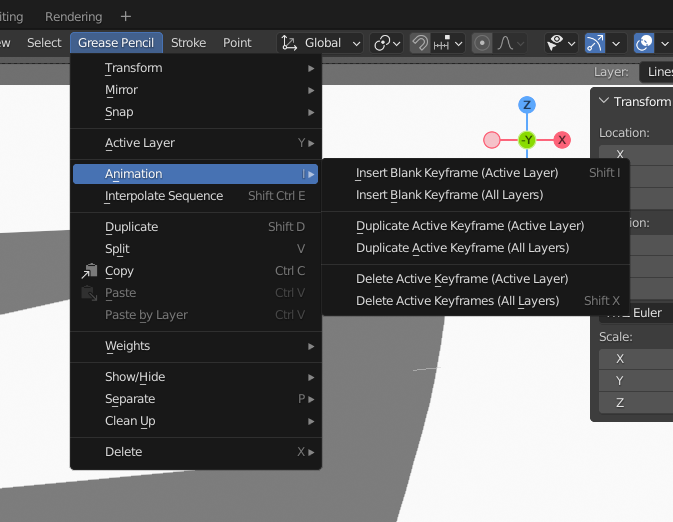
Automatically
- To enable Auto-Key select the Timeline region.
- Enable the Circular Auto Key button in the center of the Timeline region.
- New blank frames will be inserted automatically on the active layer.

Current Keyframe Box
Change Frame Type
Keyframe types are used to filter drawings in operations like Onion Skinning and Flipping. Keyframe types includes:
 Normal keyframe (white / yellow diamond),
Normal keyframe (white / yellow diamond), Breakdown (small cyan diamond),
Breakdown (small cyan diamond), Extreme (big pink diamond), and
Extreme (big pink diamond), and Jitter (tiny green diamond).
Jitter (tiny green diamond). Moving Hold (dark gray / orange diamond)
Moving Hold (dark gray / orange diamond)
To change the current keyframe type select a different keyframe type from the Current Keyframe box, status of any active frame will be displayed in this row.
- Navigate to the desired frame
- Check the desired layer is active
- Select a new Keyframe Type from the Current Keyframe box.
Change Frame Duration
To change the length of an active keyframe ensure there is at least one keyframe forward of the (otherwise the frame will be infinite, and its duration will be 0). Once between two keyframes the length of the active frame can be changed, and all other keyframes forward of the play-head on the active layer will shift.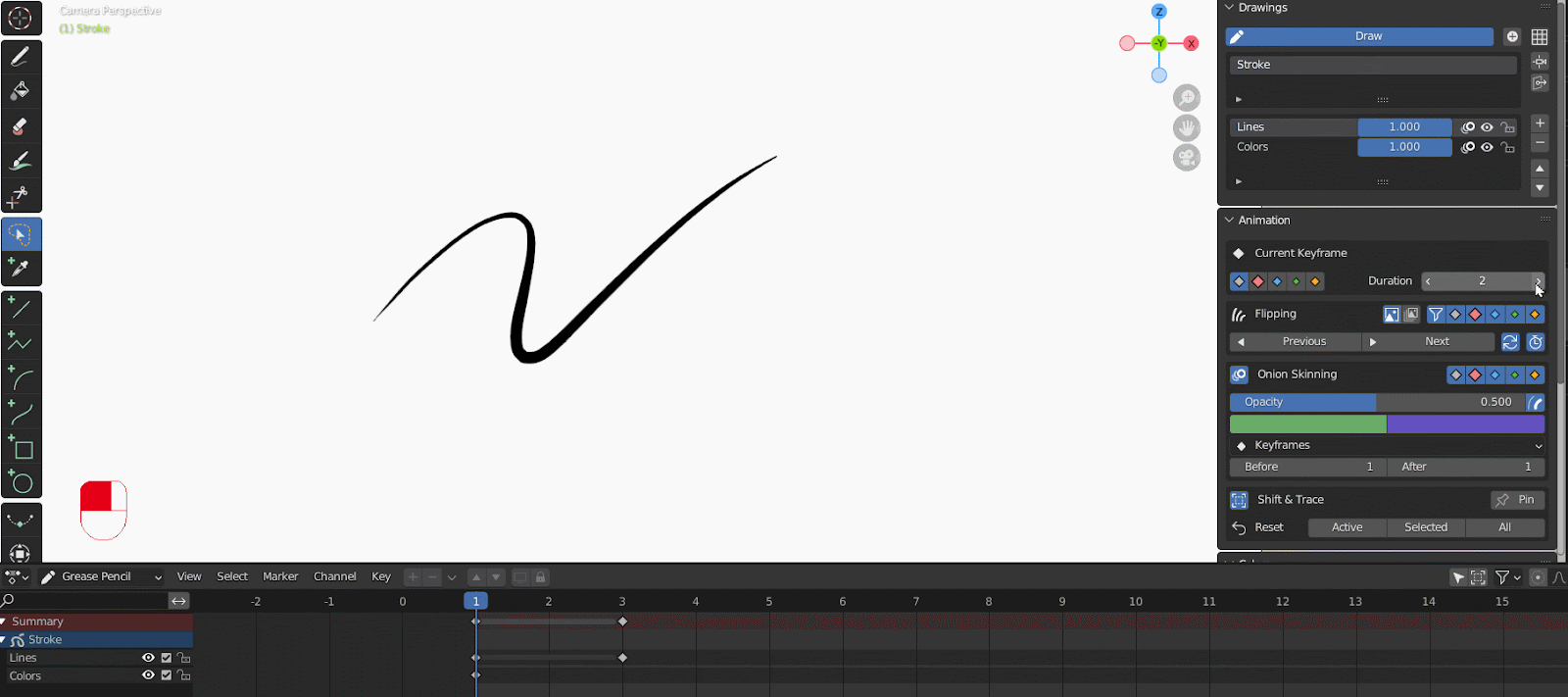
- Navigate to the desired frame
- Ensure there is a keyframe forward of the play-head
- Adjust the duration by entering a number or selecting the handles to move one increment
Flipping Box
The Flipping menu allows you to rapidly flip through keyframes in the Grease Pencil Object. This allows you to quickly filter keyframe types to flip between.
To change a Keyframe type for the purposes of filtering. Select the keyframe and hit “R” on the keyboard or from the Grease Pencil Dope Sheet header select Key>Keyframe Type. See Blender Manual for more information. Or use Current Keyframe box.
- To flip only on the active layer select the
 (left) single image symbol.
(left) single image symbol. - To flip on all active layers select the
 (right) multi image symbol.
(right) multi image symbol. - Use the colorful keyframe symbols to filter which keyframe types to flip between frames.
- Click the filter icon
 to disable keyframe filtering
to disable keyframe filtering - Alternatively use Keyboard Shortcuts "," for flip left and "." for flip right. (comma=left and period=right)
- Enable the
 to loop the flipping sequence
to loop the flipping sequence - To consider preview range ensure the
 is enabled under Flipping.
is enabled under Flipping.
Choose Flipping Undo Behavior
When using Undo by default Blender will include frame changes by default in the undo history. So Ctrl + Z will flip back to the last frame you saw.
To disable this behavior enabled Stick To Frame under Flipping Undo Settings in the SPA Blender Addon Preferences.
Onion Skinning Box
Enable Onion Skinning to preview previous and next drawings. This can be filtered in various ways like by Frame, Keyframe, Selection and more. Use these filters to see only the frames you want.
- To enable Onion Skinning select the
 button.
button. - Adjust opacity of Onion Skins using the Opacity slider.
- Adjust the range of keyframes to be onion skinned with before/after.
- Keyframes Before/After can be filtered out using color/type (similar to Flipping)
- Mode to Display in
- Frames - Display every frame
- Keyframes - Display only keyframes
- Selected - Display only highlighted keyframes
- Tagged - TBD
References and Review
Tools to for importing references and tracing from drawings.
Shift and Trace Box
Shift and Trace is used to quickly move a drawing to another part of the screen for tracing in a non destructive way. Shift and Trace can be quickly enabled and disabled and is used primarily as a reference.
- Make sure the Shift & Trace Overlay
 is active from the Storyboard Panel.
is active from the Storyboard Panel. - Select the Shift & Trace tool
 from the Toolbar on the left.
from the Toolbar on the left. - Mode: Can be set to the Active Layer or any Editable Layer
- Use Current Frame allows you to shift the active frame.
- Custom Frame allows a specific frame to be targeted for shifting regardless of the playhead.
- The Shift & Trace tool uses move, scale, rotate and skew from the Quick Edit Tool.
- The tool is non-destructive, your edits will disappear when the overlay is disabled.
- To reset all edits or some edits use the Reset Menu in the Storyboard Panel

- Use CTRL+ARROW KEY to shift frames with the keyboard, similar to Quick Edit shortcuts
Pinning Shifted Frames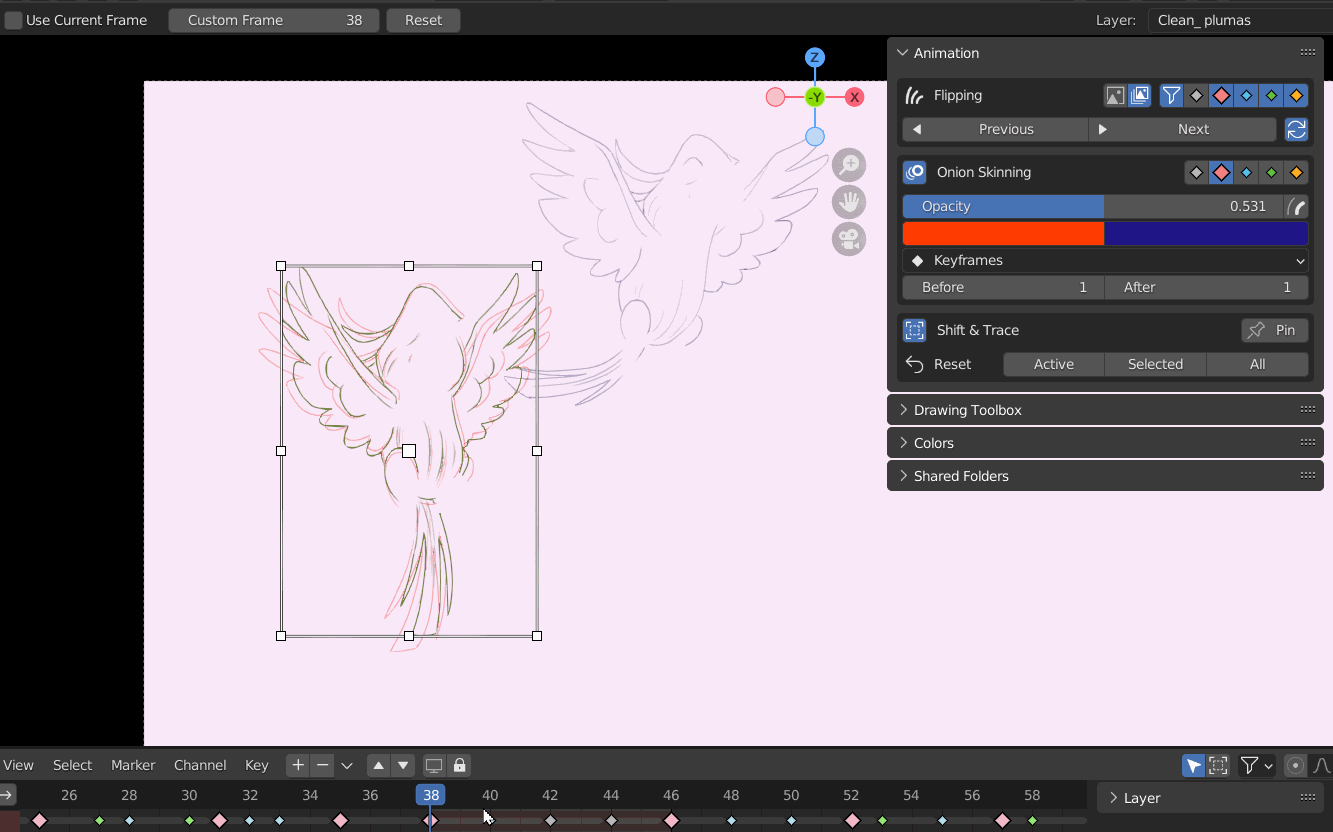
Pin your Shift & Trace to a selected frame using the new PIN icon. This means only the pinned frame will display Shift & Trace, so you can preview the rest of your animation easier.
Import Image as Reference
To import any image as a reference into Blender use the Import Image as Grease Pencil Reference option. This can be done using an image from your clipboard, or from a disk. This allows you to manipulate the reference image externally in any application and import into blender.
Grease Pencil references are first class citizens that use all the same operations including transformations and keyframing.
Import via Clipboard
To import an image from clipboard take a screenshot using the built in Windows Screenshot tools, this will automatically copy the screenshot to your clipboard. You can also copy an image layer from photoshop or copy an image from the web.
- Take a screenshot
- Open Blender
- Ensure you are in Draw Mode
- Use CTRL+SHIFT+V to paste the image from clipboard into the active Grease Pencil layer.
- Your reference will now be available as a keyframe in the Dope Sheet.
Import Image(s) from disk
To import an image from disk.
- Open Blender
- Ensure you are in Draw Mode
- Use SHIFT+A to Open to Import References
- Browse for the Image(s) you want to import
- Enable Pack Image(s) to include the image in your .blend file
- Enable Create New Layer(s) to create a layer per image
Layers will inherit Names from the Image file.
Animating with 3D Objects
Working with 3D in the Animation workspace.
Moving Objects/Cameras
Blender allows for multiple ways to control an object's position in 3D space. Blender Object can be moved multiple times and in combination with Keyframing can be used to animate Objects including the camera.
- Switch to Object Mode using the drawing toolbox.
- Select the desired object with your mouse
- From the left toolbar select the Move gizmo from the Toolbar.
Rotate, Scale & Transform tools are also available from the same toolbar.
Switching back to Draw Mode
Draw Mode is where all drawing is done on the Grease Pencil Object as defined in the Creating a New Object section. Once in Draw Mode users can draw, erase, add/remove layers and add/remove keyframes and much more.
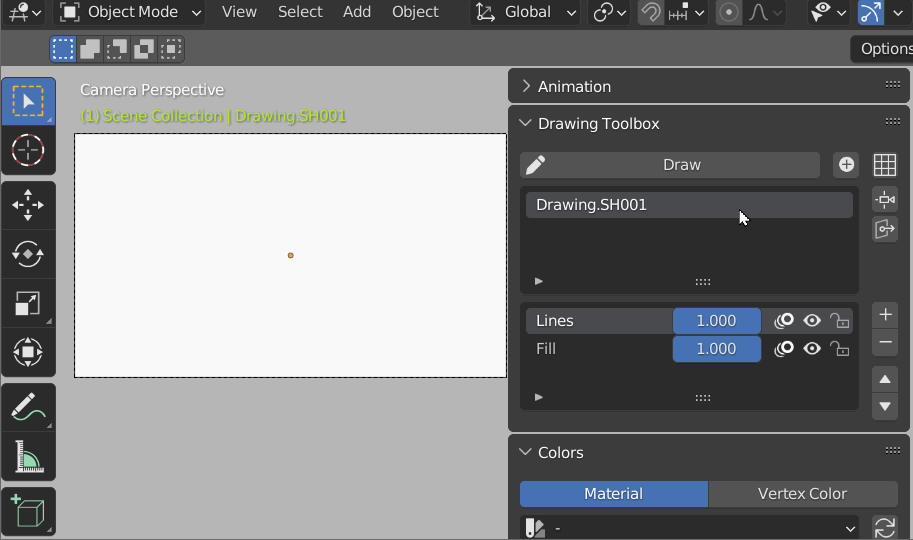 An active Grease Pencil/Drawing Object is required to enter Draw Mode. Follow the Create New Drawing Object guide to add a new Object.
An active Grease Pencil/Drawing Object is required to enter Draw Mode. Follow the Create New Drawing Object guide to add a new Object.
- Entering Draw Mode select an Object
- Select the enter Draw Mode button
- The interface will switch into drawing mode.
- To change the active drawing simply select a new drawing from the same list
Pinning Drawings to Camera
When the camera is animated in Blender it is important to manage the location of your Grease Pencil Object within the scene.
- Select an Object from the Object list.
- Select the “Pin to Camera” button
- The Grease Pencil Object will now follow the camera’s animation path.
Selected and Active Objects
Selection and Active are properties of objects only in Object Mode. To enter drawing mode on a certain object, it must be your active object, it is also possible to have a difference between an active and a selected object. There are many reasons why Blender separates these concepts. For example is Snapping locations from an Active Object to the Selected Object for more info on snapping see here. Another example Object Modes like Draw, Edit, Sculpt etc are dependent on your active object not your selected object.
Single Active Object
In the Outliner
The single active object in this example is the Cube.
- Icon: Active Object will appear with a Faint Grey Background around it's icon in the outliner.
- (We know, yes. it's really faint!)
In the 3D Viewport
The single active object in these examples are first is the Cube, and second is the Camera.
- Origin Point: Single Active Object will have it's origin displayed as an Yellow Dot
Single Active & Selected Object
In the Outliner
The single active & selected object in this example is the Cube.
- Icon: Active Object will appear with a Faint Grey Background around it's icon in the outliner.
- Name: The name of the Active Object will be Highlighted in Yellow**
- Item Row: The entire Item row in the Outliner is Highlighted in Blue
In the 3D Viewport
The single active & selected object in this example is the Cube.
- Origin Point: Single Active Object will have it's origin displayed as an Yellow Dot
- Outline: The Object's shape has a Yellow Outline
Multiple Selected & Single Active Object
In the Outliner
The Active Object in this example is Cube. The selected Objects in this example are Camera, Light & Cube.
- Active
- Icon: Active Object will appear with a Faint Grey Background around it's icon in the outliner.
- Name: The name of the Active Object will be Highlighted in Yellow
- Item Row: The entire Item row in the Outliner is Highlighted in Blue
- Selected
- Name: The name of the Active Object will be Highlighted in Orange
- Item Row: The entire Item row in the Outliner is Highlighted in Dark Blue
In the 3D Viewport
The Active Object in this example is Cube. The selected Objects in this example are Camera, Light & Cube.
- Active
- Origin Point: Single Active Object will have it's origin displayed as an Yellow Dot
- Outline: The Object's shape has a Yellow Outline
- Selected
- Origin Point: Single Active Object will have it's origin displayed as an Orange Dot
- Outline: The Object's shape has a Orange Outline
Clearing Selections
If you have multiple selections made in Blender you can click anywhere in the 3D Viewport to clear the selection, or use the Alt-A shortcut shown below.
Use shortcut Alt + A to clear selections.
To learn more about Selection vs Active see the [Blender Documentation](https://docs.blender.org/manual/en/latest/editors/outliner/selecting.html)
Editing references
Editing References
With Blender, every artist as access to a full editing package.
Launch Video Editing Template
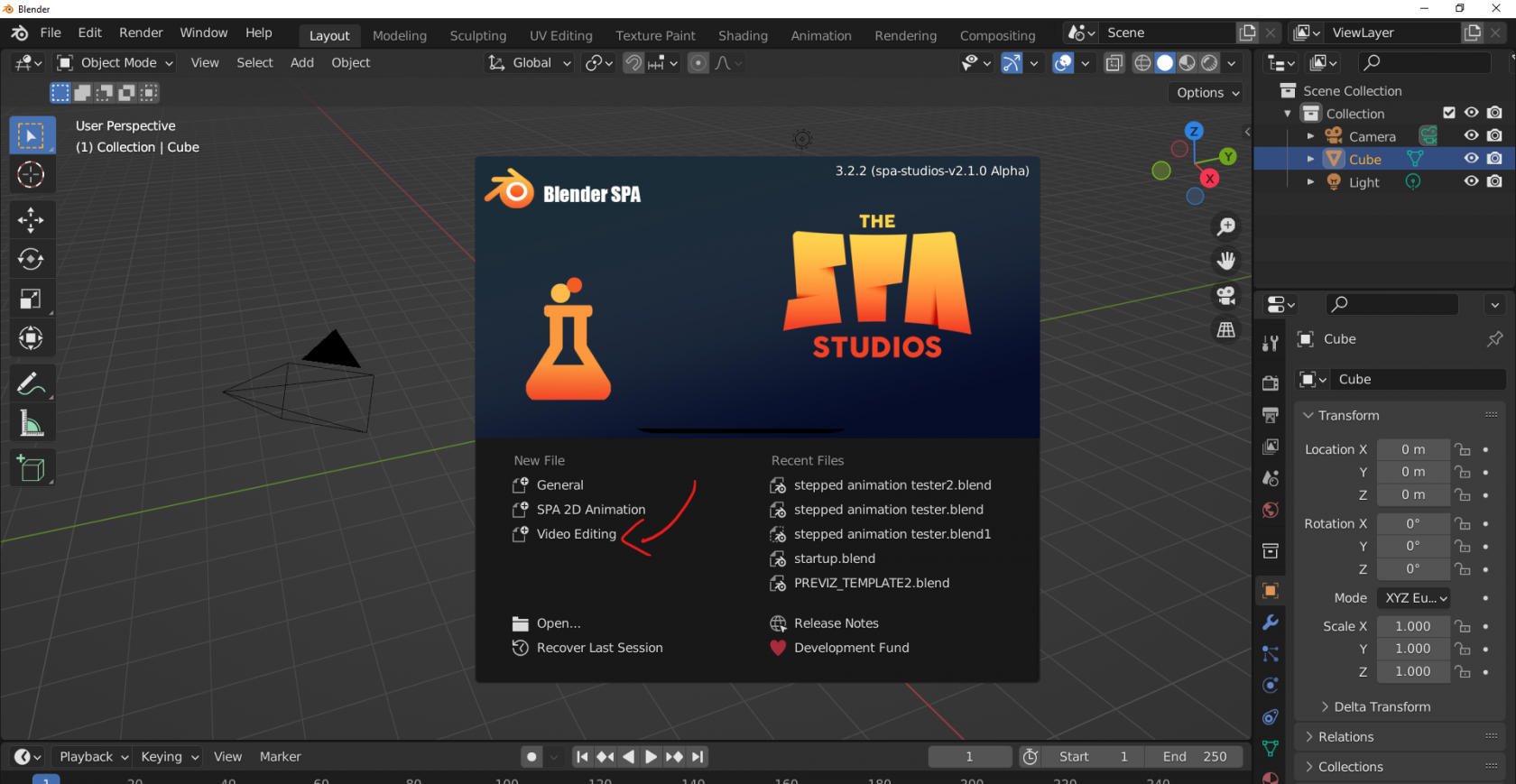 To begin simply launch blender via Shotgrid and select the
To begin simply launch blender via Shotgrid and select the Video Editing template from Blender's Splash Screen,
Interface Basics
- White: File Browser This area is where you will find folders from your computer to use as media bins
- Yellow: Video Canvas This where the video you are editing will play
- Red: Properties Panel This area is where you will find render settings like duration, resolution
- Green: Toolbar This area contains tools like the Selection and Cut tools.
- Blue: Sequencer/Timeline The Sequencer area is where you can move and organize movie and sounds strips
Importing Files as Strips
Blue Strips contain Videos, while Turquoise Strips contain Audio. Typically movie files will have a Video and an Audio strip.
- You can import a file using the file browser area
- To begin a folder in the File Browser and navigate to the desired video/audio file.
- Drag the desired file into the timeline area
- Alternatively use shortcut CTRL+A to begin importing
Cut a strip
- Select the Blade tool from the Toolbar area
- Click on the clip you would like to cut to insert a cut
- Alternatively use Shortcut SHIFT+SPACEBAR , K to open blade tool
Delete a Strip
- Select strip you would like to delete
- From the sequencer header menu select Strip>Delete
- Alternatively use Shortcut X to delete strips
Move a Strip
- To move a strip select the strip
- Hit G on the keyboard and move the mouse or arrow-keys
- Press Enter to confirm
Moving Strip's Handles
- To move a handle select the handle of a strip (handles are highlighted white)
- Hit G on the keyboard and move the mouse or arrow-keys
- Press Enter to confirm
Adjust Render Length
- In the Properties Panel under Render Properties
- Find Frame Range and set Start & End Frames
